Honeywell 480628-4096 Wireless LAN Radio Card User Manual
Honeywell International, Inc. Wireless LAN Radio Card
Contents
- 1. Manual
- 2. Full Manual
Full Manual

WaveLAN/IEEE Turbo 11 Mb PC Card i
You can find the most recent software and user documentation for all
WaveLAN products on our internet site.
If you encounter problems when installing or using this product, or
would like information about our other WaveLAN products, please
contact your local Authorized WaveLAN Reseller or regional
Lucent Technologies Sales Office. You can find their address and
phone numbers on the WaveLAN website.
In case no local or regional support is available, you can reach us at
the addresses or telephone numbers listed below.
When contacting WaveLAN Support, please complete the WaveLAN
Problem Report form and include it with your email or fax. The form
(report.txt) is available on the WaveLAN Software CD-ROM, and on
the WaveLAN Support pages of the WaveLAN website.
Software and Documentation
World Wide Web http://www.wavelan.com
FTP Server ftp://ftp.wavelan.com/pub
WaveLAN Regional Support
U.S.A / Canada usasupport@wavelan.com
Caribbean/ Latin America calasupport@wavelan.com
Europe/ Middle-East/ Africa emeasupport@wavelan.com
Asia/ Pacific apasupport@wavelan.com
WaveLAN Global Support
U.S.A / Canada Voice: +1 800 WAVELAN-3
Caribbean/ Latin America
Technical Support

ii WaveLAN/IEEE Turbo 11 Mb PC Card
Wireless Interoperability
The IEEE 802.11 WaveLAN products are designed to be inter-operable with any
wireless LAN product that is based on Direct Sequence Spread Spectrum (DSSS)
radio technology, and is compliant to the IEEE 802.11 Standard on Wireless LANs
(Revision B), as defined and approved by the Institute of Electrical and Electronics
Engineers.
WaveLAN and your Health
WaveLAN, like other radio devices, emits radio frequency electromagnetic energy.
The level of energy emitted by WaveLAN devices however is far much less than the
electromagnetic energy emitted by wireless devices like for example mobile
phones.
Because WaveLAN operates within the guidelines found in radio frequency safety
standards and recommendations, Lucent Technologies believes WaveLAN is safe
for use by consumers. These standards and recommendations reflect the
consensus of the scientific community and result from deliberations of panels and
committees of scientists who continually review and interpret the extensive
research literature.
In some situations or environments, the use of WaveLAN may be restricted by the
proprietor of the building or responsible representatives of the organization. These
situations may for example include:
• Using the WaveLAN equipment on board of airplanes, or
• In any other environment where the risk of interference to other devices or
services is perceived or identified as harmful.
If you are uncertain of the policy that applies on the use of wireless devices in a
specific organization or environment (e.g. airports), you are encouraged to ask for
authorization to use the WaveLAN device prior to turning on the equipment.
Information to the User

WaveLAN/IEEE Turbo 11 Mb PC Card iii
The IEEE 802.11 WaveLAN PC Card must be installed and used in strict
accordance with the manufacturer’s instructions. This device complies with the
following radio frequency and safety standards.
Canada - Industry Canada (IC)
This device complies with RSS 210 of Industry Canada.
Europe - EU Declaration of Conformity
This device complies with the specifications listed below, following the provisions of
the EMC Directive 89/336/EEC:
• ETS 300-826 General EMC requirements for Radio equipment.
• ETS 300-328 Technical requirements for Radio equipment.
USA - Federal Communications Commission (FCC)
This device complies with Part 15 of FCC Rules. Operation of the devices in a
WaveLAN System is subject to the following two conditions:
• This device may not cause harmful interference.
• This device must accept any interference that may cause undesired operation.
Exposure to Radio Frequency Radiation.
Exposure to Radio Frequency Radiation. The radiated output power of the IEEE
802.11 WaveLAN PC Card is far below the FCC radio frequency exposure limits.
Nevertheless, the WaveLAN PC Card shall be used in such a manner that the
potential for human contact during normal operation is minimized. When using this
device in combination with WaveLAN Outdoor Antenna products, a certain
separation distance between antenna and nearby persons has to be kept to ensure
RF exposure compliance. Refer to the Regulatory Statements as identified in the
documentation that comes with those products for additional information.
Regulatory Information

Regulatory Information
iv WaveLAN/IEEE Turbo 11 Mb PC Card
Interference Statement
This equipment has been tested and found to comply with the limits for a Class B
digital device, pursuant to Part 15 of the FCC Rules. These limits are designed to
provide reasonable protection against harmful interference in a residential
installation.
This equipment generates, uses, and can radiate radio frequency energy. If not
installed and used in accordance with the instructions, it may cause harmful
interference to radio communications. However, there is no guarantee that
interference will not occur in a particular installation.
If this equipment does cause harmful interference to radio or television reception,
which can be determined by turning the equipment off and on, the user is
encouraged to try and correct the interference by one or more of the following
measures:
• Reorient or relocate the receiving antenna.
• Increase the distance between the equipment and the receiver.
• Connect the equipment to an outlet on a circuit different from that to which the
receiver is connected.
• Consult the dealer or an experienced radio/TV technician for help.
Lucent Technologies is not responsible for any radio or television interference
caused by unauthorized modification of the devices included with this IEEE 802.11
WaveLAN Kit, or the substitution or attachment of connecting cables and equipment
other than specified by Lucent Technologies.
The correction of interference caused by such unauthorized modification,
substitution or attachment will be the responsibility of the user.
For country-specific approvals, please consult the flyer “Radio Certification
Information” that was inserted into this kit.

WaveLAN/IEEE Turbo 11 Mb PC Card i
Technical Support i
Information to the User ii
Regulatory Information iii
Table of Contents i
1 About WaveLAN/IEEE 1-1
Kit Contents 1-1
WaveLAN Network Scenarios 1-2
■It’s Easy 1-4
WaveLAN PC Card Features 1-5
■WaveLAN PC Card Types 1-6
■Can I Upgrade WaveLAN Cards? 1-9
About the Software CD-ROM 1-10
Optionally Available 1-13
■WaveLAN IEEE Adapter Cards 1-13
■External Antennas 1-13
Connecting to a Network 1-17
■Connect to Any IEEE 802.11 LAN 1-18
■Connect to a Specific IEEE 802.11 LAN 1-19
2 Hardware Installation 2-1
Installing your WaveLAN Kit 2-1
■Preparation 2-1
■Card Removal and Re-insertion 2-2
Table of Contents

Table of Contents
ii WaveLAN/IEEE Turbo 11 Mb PC Card
Table of Contents
3 Installation for Windows 3-1
Introduction 3-1
■Before You Start the Installation 3-1
■What You Need to Know 3-2
Getting Started in Windows 95/98 3-3
■Starting Installation 3-3
Getting Started in Windows NT 3-5
■Starting Installation 3-6
Installing the Miniport Driver 3-9
■Network Installation 3-12
Setting the WaveLAN Parameters 3-13
■Which Parameters Do You Need? 3-13
■Basic WaveLAN Parameters 3-14
■WaveLAN Encryption Parameters 3-18
Finishing the WaveLAN Installation 3-20
■After Restarting Your Computer 3-20
Working with WaveLAN & Windows 3-21
■View Other WaveLAN Stations 3-21
■Selecting the Networking Protocol 3-22
■Verifying the Current Protocol Setting 3-23
■Display or Modify WaveLAN Parameters 3-24
4 Advanced WaveLAN Parameters 4-1
Introduction 4-1
MAC Address 4-2
AP Density 4-3
Transmit Rate 4-4
■The Auto Transmit Rate Select Mechanism 4-4
■The User-defined Transmit Rate 4-5

Table of Contents
WaveLAN/IEEE Turbo 11 Mb PC Card iii
Medium Reservation 4-8
Power Management 4-13
■Enable Power Management: 4-14
5 Monitoring WaveLAN Performance 5-1
About WaveMANAGER/CLIENT 5-1
Installing WaveMANAGER/CLIENT 5-2
Running WaveMANAGER/CLIENT 5-3
■Monitoring Options 5-3
■What to Monitor 5-4
■Choosing your WaveMANAGER Tool 5-6
WaveLAN Status/Function Window 5-7
WaveLAN Link Test 5-8
■Testing Radio Communications Quality 5-9
■Testing Data Throughput Efficiency 5-10
WaveLAN Card Diagnostics 5-13
Advanced User Options 5-14
■Basic Mode versus Enhanced Mode 5-14
■Logging Measurement Data 5-15
6 WaveLAN Security Options 6-1
Introduction 6-1
■Closing the Infrastructure 6-2
■Wireless Access Control 6-3
■Wireless Data Encryption 6-4

Table of Contents
iv WaveLAN/IEEE Turbo 11 Mb PC Card
Table of Contents
A Card Specifications A-1
Physical Specifications A-1
Networking Characteristics A-2
Radio Characteristics A-3
■Supported Frequency Sub-bands A-7
WaveLAN PC Card Types A-9
■About Previously Purchased Cards A-9
■Can I Upgrade WaveLAN Cards? A-12
B Troubleshooting B-1
LED Activity B-1
Windows Operating Systems B-4
■Generic Problems B-4
■Hardware Conflict B-6
Upgrading the WaveLAN Miniport Driver B-14
■Removing the WaveLAN Miniport Driver B-20
MS-DOS Systems B-23
■Error Messages B-23
■Can Not Connect To The Network B-23
C Installing in Windows CE C-1
Introduction C-1
■Installing the WaveLAN Driver C-2
■Using WaveLAN with Windows CE C-4
■Modifying Configuration Parameters C-5

Table of Contents
WaveLAN/IEEE Turbo 11 Mb PC Card v
D Installation for MS-DOS D-1
Introduction D-1
■What You Need to Know D-1
■Driver Types D-1
■Installation Overview D-2
Copy the WaveLAN Software D-3
Setup the WaveCAD Program D-4
■Card & Socket Services D-4
■Intel 82365 PCIC D-5
Install the Network Client Software D-9
Setup the WaveLAN Parameters D-10
■DOS ODI Driver Configuration D-10
■Packet Driver Configuration D-19
Finishing Installation D-25
Advanced Options D-27
■Dual Card Configuration D-27
■Start-up Menu Configuration D-27
E Installing in Apple Macintosh E-1
Introduction E-1
Installing the WaveLAN Driver E-2
■Installing Networking Protocols E-2
■Enabling your WaveLAN Card E-3
Using WaveLAN with PowerBooks E-5
■Basic Parameters E-6
■Advanced Parameters E-7
■Monitoring Wireless Performance E-9
■Modifying Configuration Parameters E-9

Contents
1
About WaveLAN/IEEE
Kit Contents 1-1
WaveLAN Network Scenarios 1-2
It’s Easy 1-4
WaveLAN PC Card Features 1-5
WaveLAN PC Card Types 1-6
■Silver Label Cards 1-6
■Gold Label Cards 1-7
■About Using Different Card Types 1-7
■About the Fixed Wireless PC Card 1-8
Can I Upgrade WaveLAN Cards? 1-9
About the Software CD-ROM 1-10
Optionally Available 1-13
WaveLAN IEEE Adapter Cards 1-13
External Antennas 1-13
■WaveLAN Range Extender Antenna 1-14
■WaveLAN Vehicle-Mount Antenna 1-15
Connecting to a Network 1-17
Connect to Any IEEE 802.11 LAN 1-18
Connect to a Specific IEEE 802.11 LAN 1-19

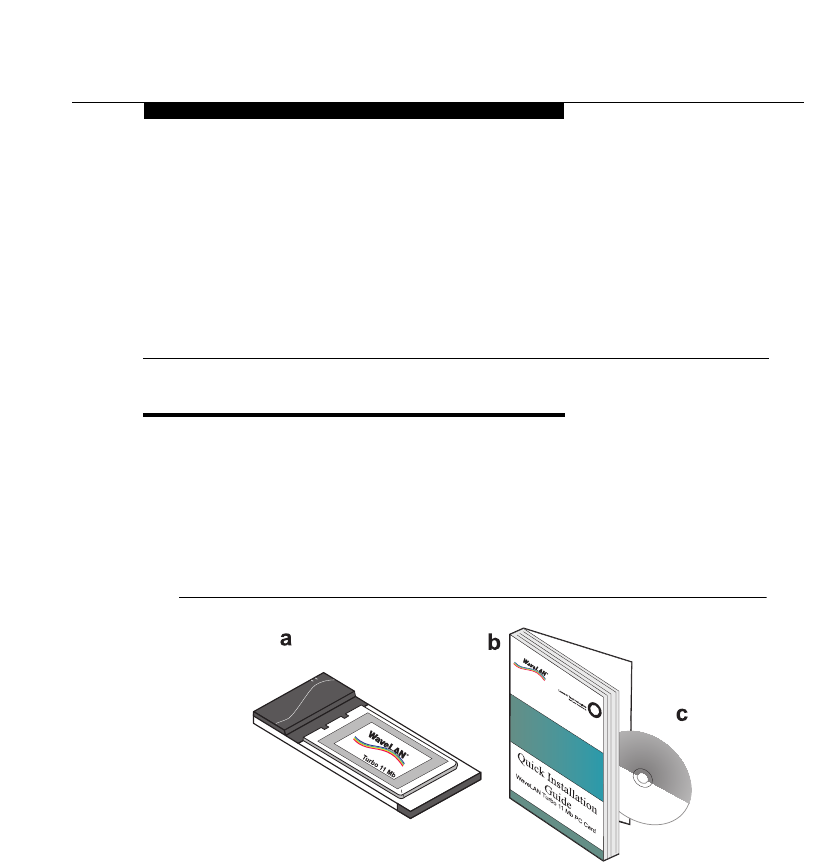
WaveLAN/IEEE Turbo 11 Mb PC Card 1-1
1
About WaveLAN/IEEE
Kit Contents 1
The WaveLAN/IEEE Turbo 11 Mb PC Card kit includes the
following items as pictured in Figure 1-1:
a. A WaveLAN/IEEE Turbo 11 Mb PC Card.
b. The Quick Installation Guide (this document).
c. WaveLAN Software CD-ROM.
Figure 1-1 WaveLAN IEEE 802.11 Kit Contents
The printed Quick Installation Guide is an abstract of the electronic
Installation Guide included on the WaveLAN Software CD-ROM.
For detailed information you may wish to consult the electronic
version that is available in Adobe’s Acrobat Portable Document
File (*.pdf) format.
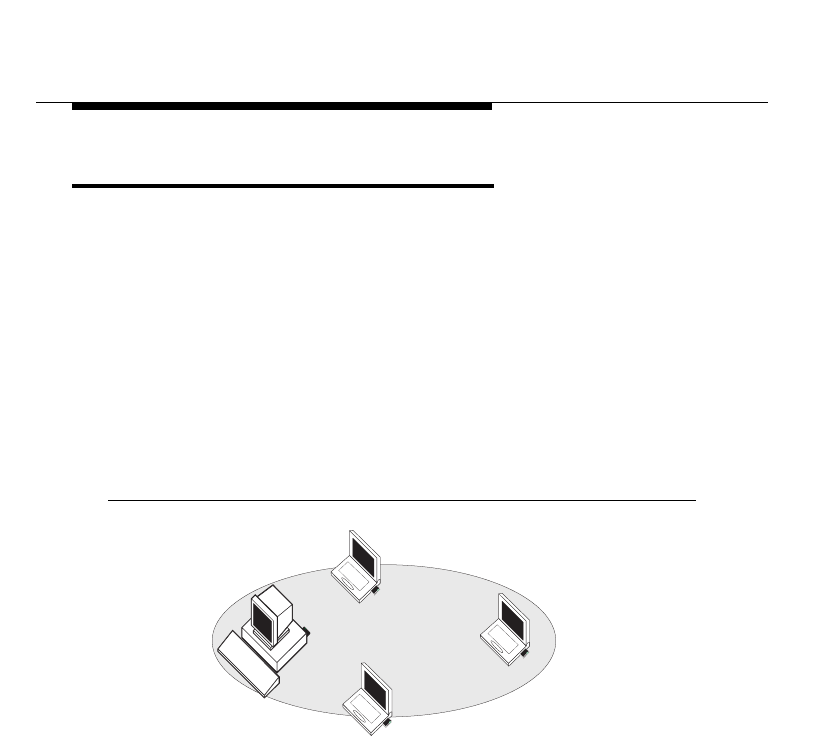
About WaveLAN/IEEE
WaveLAN Network Scenarios
1-2 WaveLAN/IEEE Turbo 11 Mb PC Card
WaveLAN Network Scenarios 1
This WaveLAN/IEEE Turbo 11 Mb PC Card Kit enables you to:
■Connect your computer to an ad-hoc workgroup of wireless
computing devices, or
■Connect your computer to a Local Area Network (LAN)
Infrastructure that includes Lucent Technologies WavePOINT-
II access points, or other IEEE 802.11 compliant Local Area
Network (LAN) systems
■Expand the capabilities of your WavePOINT-II access points,
to support wireless devices that have been equipped with
IEEE 802.11 adapter cards.
Figure 1-2 Ad-hoc Wireless Workgroup
The ad-hoc workgroup configuration enables you to quickly set up
a small wireless workgroup, where the workgroup participants can
exchange files using features like “Files and Printer Sharing” as
supported by Microsoft Networking.
You can use this type of wireless peer-to-peer networks “on the
road”, or in Small Office Home Office (SOHO) environments. As
long as the station are within range of one another, this is the
easiest and least expensive way to set up a wireless network.
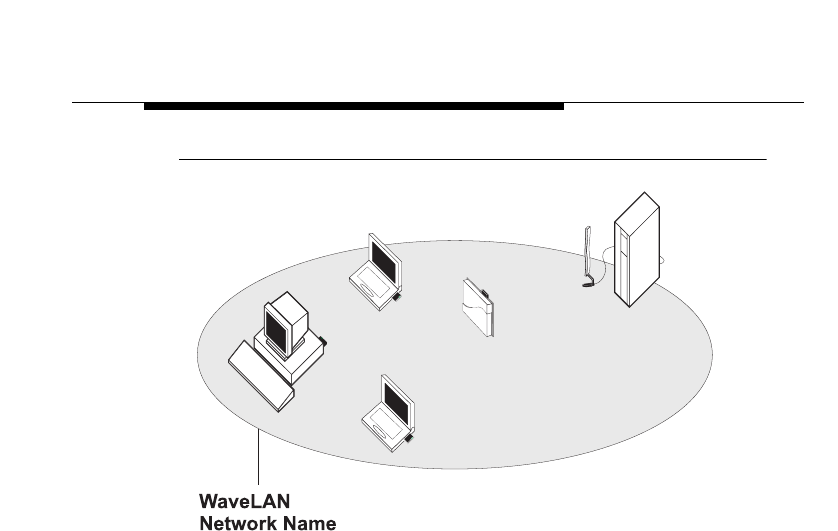
About WaveLAN/IEEE
WaveLAN Network Scenarios
WaveLAN/IEEE Turbo 11 Mb PC Card 1-3
Figure 1-3 Stand Alone Wireless LAN
Local Area Network (LAN) Infrastructures may either be:
■Stand-alone wireless LANs as pictured in Figure 1-3.
■Wireless network infrastructures connected to an existing
Ethernet network as pictured in Figure 1-4 on page 1-4.
■Wireless network infrastructures that may include previously
marketed WaveLAN products such as:
— Standard WaveLAN IEEE 802.11 PC Cards
— WaveLAN/IEEE Turbo PC Cards
— Previous generation WaveLAN Legacy cards.
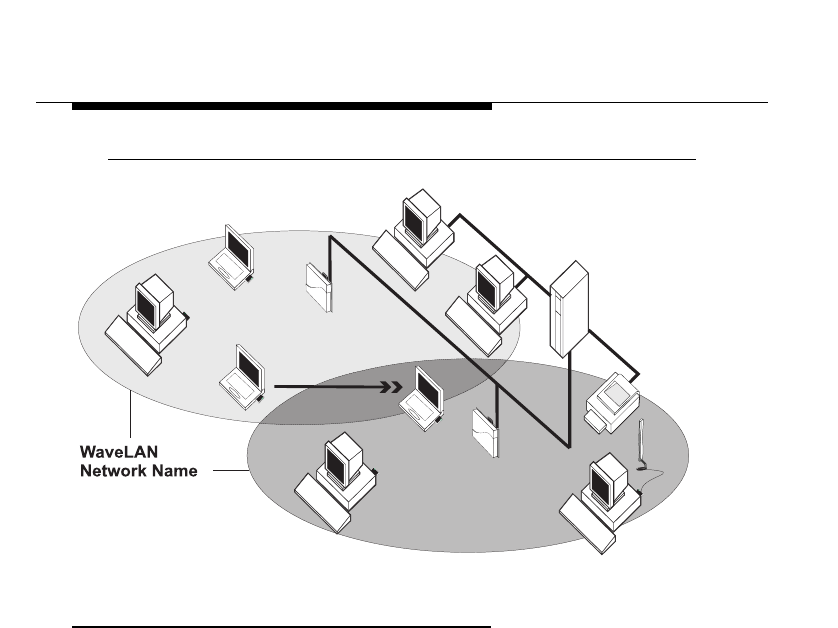
About WaveLAN/IEEE
WaveLAN Network Scenarios
1-4 WaveLAN/IEEE Turbo 11 Mb PC Card
Figure 1-4 LAN Infrastructure
It’s Easy 1
The WaveLAN PC Card functions like any standard wired Ethernet
card, but WaveLAN does not need any wires!
Where an Ethernet card requires a cable connection to a hub and/
or patch panel, the cable physically ties you down to the location of
the wired connection.
WaveLAN allows you to connect your computer to a Local Area
Network (LAN) system from anywhere within the wireless
coverage area. Expanding or re-designing your network is easy:
Add or relocate WavePOINT-II access points, power-up your (new)
WaveLAN computers, and you’re done!
Unlike Ethernet, WaveLAN will enable you to roam throughout the
network while remaining connected to the LAN.
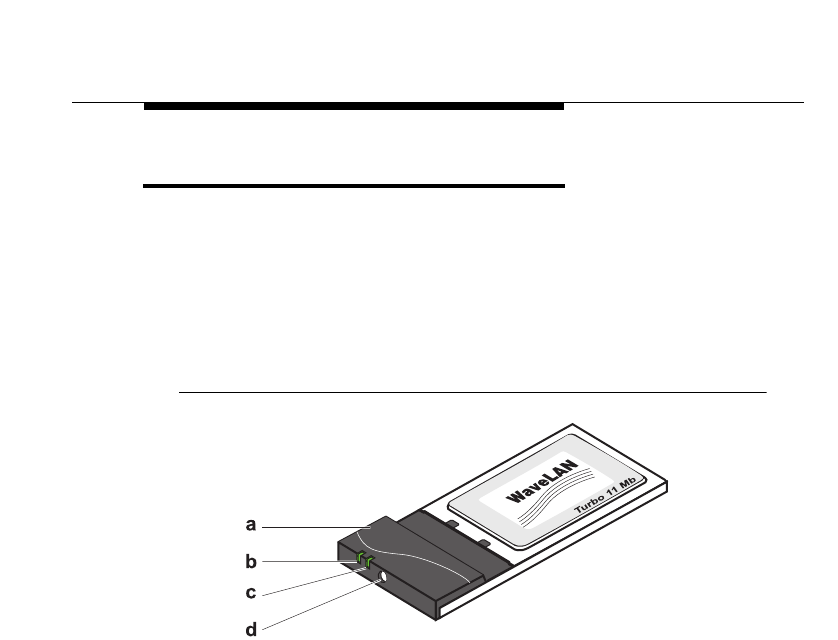
About WaveLAN/IEEE
WaveLAN PC Card Features
WaveLAN/IEEE Turbo 11 Mb PC Card 1-5
WaveLAN PC Card Features 1
The WaveLAN/IEEE Turbo 11 Mb PC Card is a standard PC Card
that fits into any PC Card Type II slot.
The WaveLAN/IEEE Turbo 11 Mb PC Card has two LED indicators
and two integrated antennas. Optionally you can use the
WaveLAN/IEEE Turbo 11 Mb PC Card in combination with an
external antenna (see page 1-13).
Figure 1-5 The WaveLAN/IEEE Turbo 11 Mb PC Card
a. Integrated Antennas
b. Transmit/ Receive LED
■Off - No wireless activity
■Blinking - Sensing/transmitting wireless data
c. Power ON/OFF LED
■Solid Green - standard operational mode
■Blinking Green - Power Management mode
d. Connector for optional External Antenna (see page 1-13).
For a more detailed overview of the LED activity, please consult
Table B-1 on page B-2 of Appendix B.

About WaveLAN/IEEE
WaveLAN PC Card Features
1-6 WaveLAN/IEEE Turbo 11 Mb PC Card
WaveLAN PC Card Types 1
The WaveLAN/IEEE Turbo 11 Mb PC Card is a wireless network
adapter card that complies with the IEEE 802.11 standard on
wireless LANs Rev. B. This card that supports data rates up to 11
Mbit/s is available in two variants:
■WaveLAN/IEEE Turbo 11 Mb Silver Label, and
■WaveLAN/IEEE Turbo 11 Mb Gold Label
Both types of WaveLAN/IEEE Turbo 11 Mb PC Cards are:
■Fully compatible with any other wireless LAN system based on
Direct Sequence Spread Spectrum (DSSS) radio technology
that complies with the “IEEE 802.11 standard on wireless
LANs (Revision B)”.
■Backwards compatible with any other previously released
model of the WaveLAN/IEEE product family.
Silver Label Cards 1
The WaveLAN/IEEE Turbo 11 Mb Silver PC Cards supports the
following wireless LAN features:
■Automatic Transmit Rate Select mechanism in the range of
"High, Medium, Standard and Low".
■Frequency Channel Selection (2.4 GHz).
■Roaming over multiple channels.
■Power Management.
■Wired Equivalent Privacy (WEP) data encryption, based on the
64 bit RC4 encryption algorithm as defined in the IEEE 802.11
standard on wireless LANs.
These features are described in more detail in Chapter 4
”Advanced WaveLAN Parameters”

About WaveLAN/IEEE
WaveLAN PC Card Features
WaveLAN/IEEE Turbo 11 Mb PC Card 1-7
Gold Label Cards 1
The WaveLAN/IEEE Turbo 11 Mb Gold PC Cards supports the
same functionality as the WaveLAN/IEEE Turbo 11 Mb Silver
cards. The Gold card however provides an enhanced type of data
encryption, based on the 128 bit RC4 algorithm.
NOTE:
The WaveLAN/IEEE Turbo 11 Mb Gold PC Card may not
be marketed in all parts of the world, subject to national
legislation or local regulations. For availability in your
country, please consult your local Lucent Technologies
Sales Office.
About Using Different Card Types 1
When using WaveLAN/IEEE Turbo 11 Mb PC Cards in networks
that include different types and/or versions of WaveLAN/IEEE
products carefully read the items listed below.
Different Transmit Rates 1
When using different types of WaveLAN/IEEE PC Cards, your
WaveLAN cards will always revert to higest compatible transmit
rate as supported by both cards.
For example your 11 Mb PC Card will switch to the Standard
Transmit Rate (2 Mbit/s) when communicating with a wireless
device that has been equipped with:
— A Standard IEEE PC Cards (identified by either a white,
Bronze or Silver label).
— WaveLAN/IEEE Turbo PC Cards (identified by a Bronze or
Silver label that does not include the designator "11 Mb).1

About WaveLAN/IEEE
WaveLAN PC Card Features
1-8 WaveLAN/IEEE Turbo 11 Mb PC Card
Different Types of Data Encryption 1
When using the encryption feature, please note that encrypted
messages can only be deciphered by cards that will also have
encryption enabled and are using an identical encryption key.
When using the WaveLAN/IEEE Turbo 11 Mb Gold PC Card in
combination with Silver cards, your Gold card should be configured
with a WEP compatible (64-bit) encryption key.
Are you upgrading to 11 Mb/s PC Cards? 1
Transmissions at higher data rates, may not travel as far as
communications at Standard or Low Tranmit rate.
When you consider upgrading your wireless network to WaveLAN/
IEEE Turbo 11 Mb PC Cards, you may need to perform a site
survey again to verify that the entire coverage area allows for data
transmissions at the highest transmit rates.
You can use the WaveMANAGER/CLIENT IEEE tool described in
Chapter 5 of this Quick Installation Guide to perform such a site
survey.
About the Fixed Wireless PC Card 1
This card is a special WaveLAN PC Card for outdoor antenna
installations that is marketed in Europe and Japan only. It is
typically used in combination with WavePOINT-II access points
and/or the WaveLAN Vehicle-Mount Antenna to connect a wireless
LAN device to an outdoor antenna installation (see Chapter 1of ).
1The High and Medium Transmit rates, supported by these cards,
are not compatible with the high-speed rates as deifned by the
IEEE 802.11 standard Revision B.

About WaveLAN/IEEE
WaveLAN PC Card Features
WaveLAN/IEEE Turbo 11 Mb PC Card 1-9
The Fixed Wireless PC Card can be recognized from the distinct
red color of the extended part of the PC Card. It supports the same
networking capabilities as the other WaveLAN cards, but has
different radio specifications, to comply with radio regulations for
outdoor antenna installations as defined by the European
Telecommunications Standards Institute (ETSI).
For more details about this card, please consult Appendix A ”Card
Specifications” and/or the “WaveLAN Outdoor Antenna Installation
Guide” that can be downloaded from the WaveLAN website.
Can I Upgrade WaveLAN Cards? 1
To enhance (wireless) performance of your WaveLAN/IEEE cards,
updates
are made available via the WaveLAN website at regular
intervals.
Updates typically enhance existing features supported by the
specific waveLAN/IEEE PC Card, or resolve minor bugs.
You can not use the updates to "
upgrade
" a WaveLAN/IEEE Silver
card to a WaveLAN/IEEE Turbo 11 Mb Gold PC Card.
Updates for WaveLAN/IEEE PC Cards are managed via a
dedicated tool, called the WaveLAN Station Update tool (WSU).
This tool will update the embedded software of the card (also
referred to as the Station Firmware).
Whenever an update becomes available, you will be able to
download the latest WSU tool from the WaveLAN website. You are
advised to visit the WaveLAN website at regular intervals to check
if newer versions are available for your product.

About WaveLAN/IEEE
About the Software CD-ROM
1-10 WaveLAN/IEEE Turbo 11 Mb PC Card
About the Software CD-ROM 1
The WaveLAN software CD-ROM contains both software and
documentation for all WaveLAN products that support roaming
functionality in indoor environments.
If you wish to install WaveLAN driver software, turn to Chapter 2
”Hardware Installation” and follow the instructions as described for
installing your WaveLAN/IEEE Turbo 11 Mb PC Card.
If you would like to explore the contents of the CD-ROM, the
contents map as pictured in Figure 1-6 on page 1-11, may help you
find the items you are looking for:
■WaveLAN User Guides and other reference documents are
located in the folder “docs”.
■Software for WaveLAN client stations and/or infrastructure
products, such as the WavePOINT-II access points, are
located in the folder “software”.
Both the “docs” and “software” folder have been divided into
dedicated subfolders, related to the type of WaveLAN device.
For example:
■The folder "software\adapter\pc_card" contains all the software
avaialble for your WaveLAN/IEEE PC Card.
■The folder “software\bridge\accesspt” contains the software &
tools for the WavePOINT-II Access Point.
NOTE:
Prior to copying or installing the software, you are advised
to read the Software License Agreement "license.txt",
located in the root folder of the CD-ROM.
By installing, copying or using the WaveLAN software, you
are consenting to be bound by this agreement.
If you do not agree to all of the terms of the Software
License Agreement, do not download, copy or install the
WaveLAN software.
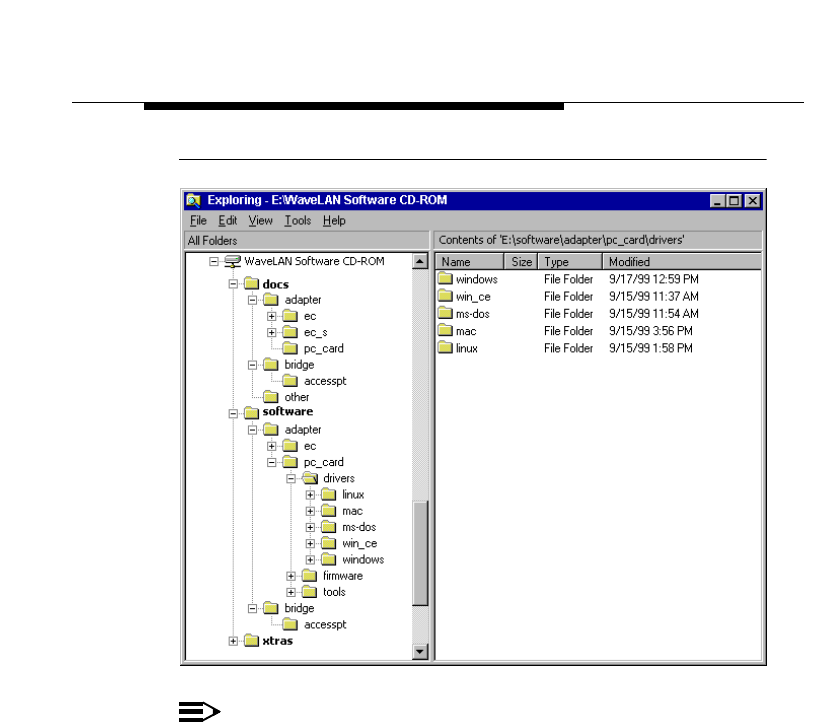
About WaveLAN/IEEE
About the Software CD-ROM
WaveLAN/IEEE Turbo 11 Mb PC Card 1-11
Figure 1-6 Contents of the Software CD-ROM
NOTE:
It is the policy of Lucent Technologies to improve products
as new technology, components, software and firmware
become available.
Before you proceed with the installation of this product, we
recommend you to consult the WaveLAN website to:
■Verify if newer versions of the software that was
shipped with your product are available.
■Download and install the latest software with your
purchased product.
You can download the latest software and documentation
from the WaveLAN website at: http://www.wavelan.com.

About WaveLAN/IEEE
About the Software CD-ROM
1-12 WaveLAN/IEEE Turbo 11 Mb PC Card
Looking again at Figure 1-6 on page 1-11 you will see that the CD-
ROM also includes a folder named “xtras”. This folder contains
additional tools, that may help you install and manage your
WaveLAN Network.
■The folder “Acrobat” includes a copy of the Adobe Acrobat
Reader ®, required to view and/or print the WaveLAN user
documentation included on this CD-ROM.
■The folder “CopyFile” includes a set of batch files that allow
you to quickly create or copy sets of driver software to:
— a floppy diskette
— hard-disk drive, and/or
— a network drive.
These files can not be executed independently, but will be
started automatically if you run the file “CopyFile.bat” that is
located in the root of the CD-ROM.
NOTE:
The Adobe Acrobat Reader is owned by and licensed from
Adobe Systems Incorporated. This software is provided
“as is.”
Lucent makes no warranty or representation, express or
implied, relating to the completeness, reliability,
effectiveness, accuracy, performance, or operation of the
Adobe software, or as to its suitability, merchantability or
fitness for a particular purpose or against infringement of
intellectual property rights of any party.
For more information about Adobe Acrobat software,
please consult the Adobe Website at:
“Http:\\www.adobe.com\acrobat”

About WaveLAN/IEEE
Optionally Available
WaveLAN/IEEE Turbo 11 Mb PC Card 1-13
Optionally Available 1
WaveLAN IEEE Adapter Cards 1
The Lucent Technologies WaveLAN IEEE solution has been based
upon a single wireless PC Card that can be used in a variety of
computing systems.
Optionally available are the following adapters for computer
systems that do not have a PC Card slot:
■WaveLAN/ISA
an ISA to PC Card-bus adapter card.
■WaveLAN/PCI
a PCI to PC Card-bus adapter card.
■WaveLAN/EC (Ethernet Converter)
A dedicated WaveLAN device that can be used to connect a
computer with a standard 10Base-T interface to your
WaveLAN network
■WaveLAN/EC-S (Ethernet & Serial Converter)
A dedicated WaveLAN device that can be used to connect a
computer with a standard 10Base-T or serial interface to your
WaveLAN network.
External Antennas 1
The WaveLAN IEEE 802.11 PC Card has been provided with two
integrated antennas (see Figure 1-5), which perform best in an
open environment with as few obstacles as possible.
Optionally available are the following types of external antennas:
■WaveLAN Range Extender Antenna.
■WaveLAN Vehicle-Mount Antenna.

About WaveLAN/IEEE
Optionally Available
1-14 WaveLAN/IEEE Turbo 11 Mb PC Card
These antennas have a Lucent Technologies proprietary
connector, that allows you to connect the card directly to the socket
on the extended side of the your WaveLAN IEEE 802.11 PC Card
(pictured in Figure 1-5 on page 1-5).
WaveLAN Range Extender Antenna 1
Use the WaveLAN Range Extender Antenna to ensure optimal
transmission and receiving quality for situations in which the
integrated antennas are shielded, for example when:
■The WaveLAN PC Card is close to metal surfaces.
■The WaveLAN PC Card is inserted into a WavePOINT-II
device or computer that is installed in a “hidden” location, e.g.
under a desk or inside a cabinet.
■Objects like thick stacks of books shield the antenna.
In most situations the WaveLAN Range Extender Antenna may
provide a performance increase of up to 50%.
Figure 1-7 Range Extender Antenna
You can connect the Range Extender Antenna to the WaveLAN
PC Card by inserting the connector into the socket on the

About WaveLAN/IEEE
Optionally Available
WaveLAN/IEEE Turbo 11 Mb PC Card 1-15
extended side of the PC Card. To protect the socket from dust, it is
shielded with a little cap, that should be removed prior to
connecting the antenna.
The WaveLAN Range Extender Antenna has a mounting bracket
and a base for perfect vertical positioning that allows you to put the
antenna on top of on your desktop computer, a table or filing
cabinet, or to hang it on the wall, or ceiling etc.
!CAUTION:
Many computer monitors today support a degauss option,
that can either be enabled manually by the user, but is
often also enabled automatically whenever you turn on the
monitor. The electromagnetic discharge that may occur
when degaussing the monitor may cause damage to the
WaveLAN equipment.
To avoid damage to your sensitive WaveLAN equipment,
do not place the Range Extender Antenna on top of, or too
close to, your monitor.
WaveLAN Vehicle-Mount Antenna 1
The WaveLAN Vehicle-Mount Antenna enables you to connect
vehicles with an on-board terminal to your LAN infrastructure.
The ruggedized design of this antenna allows you to mount it on
vehicles (for example fork-lift trucks) that need continuous access
to networked data, whether inside or outside of the building.
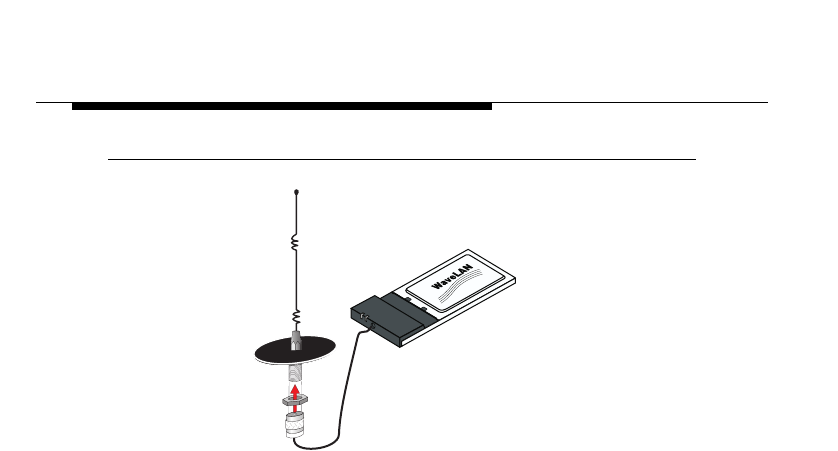
About WaveLAN/IEEE
Optionally Available
1-16 WaveLAN/IEEE Turbo 11 Mb PC Card
Figure 1-8 Vehicle Mount Omni-Directional Antenna
You can connect the Vehicle Mount Antenna to the WaveLAN PC
Card using the special 2.5 m WaveLAN IEEE Mobile Vehicle
Solution cable assembly.

About WaveLAN/IEEE
Connecting to a Network
WaveLAN/IEEE Turbo 11 Mb PC Card 1-17
Connecting to a Network 1
You can use your WaveLAN/IEEE Turbo 11 Mb PC Card to
connect to Local Area Network (LAN) systems that include Lucent
Technologies WavePOINT-II access points.
The WavePOINT-II access point is a transparent bridge between:
■WaveLAN stations that have been equipped with IEEE 802.11
compliant PC Cards.
■WaveLAN stations that have been equipped with previous
generation WaveLAN cards such as WaveLAN/PCMCIA and
WaveLAN/ISA.
■Ethernet stations that are connected to the WavePOINT-II
device via a 10Base-T or 10Base2 backbone.
To allow communication between your WaveLAN IEEE 802.11
station and the Infrastructure, the access point must be equipped
with an IEEE 802.11 compliant WaveLAN card.
WaveLAN IEEE 802.11 networks are identified by a unique
WaveLAN Network Name. All WavePOINT-II units that belong to
the same WaveLAN Infrastructure will share the same WaveLAN
Network Name.
You can configure your WaveLAN/IEEE Turbo 11 Mb PC Card to:
■“Connect to Any IEEE 802.11 LAN”
■“Connect to a Specific IEEE 802.11 LAN”, or
■“Create a ‘Stand-Alone’ IEEE 802.11 LAN” (also referred to as
"ad-hoc mode").

About WaveLAN/IEEE
Connecting to a Network
1-18 WaveLAN/IEEE Turbo 11 Mb PC Card
Connect to Any IEEE 802.11 LAN 1
This configuration setting is recommended when you intend to use
your computer in various networking environments.
When you start up your computer, your WaveLAN IEEE 802.11
station will attempt to establish a radio connection with the first
IEEE 802.11 compliant network system that provides a good
quality for radio communications.
In situations where multiple IEEE 802.11 compliant systems are
operational in the vicinity of the location where you powered-up
your computer, the WaveLAN card will connect automatically to the
network that provides the best level of communications.
Once your WaveLAN card finds an IEEE 802.11 compliant access
point, it will automatically:
■Retrieve the radio channel required to connect to this access
point.
■Establish the radio connection to the WavePOINT-II access
point that provides the best communications quality
When moving your computer to another location within the network
environment, i.e. out of range of the current access point, the
WaveLAN roaming functionality will automatically connect your
computer to other access points that belong to the same network.
This will allow continuous network connectivity as long as your
WaveLAN computer remains within range of one or more access
points that belong to the same network infrastructure.
NOTE:
Once your computer connects to “ANY” IEEE 802.11
network system, it will remain attached to this network until
you restart your computer again.
During run-time it will not switch dynamically between
systems identified by different WaveLAN Network Names.

About WaveLAN/IEEE
Connecting to a Network
WaveLAN/IEEE Turbo 11 Mb PC Card 1-19
Connect to a Specific IEEE 802.11 LAN 1
When you would like to connect to a specific IEEE 802.11 network
system, you are advised to configure your station to connect only
to the IEEE 802.11 network that is identified by the same
WaveLAN Network Name.
When your WaveLAN card finds the network with the matching
WaveLAN Network Name, it will automatically:
■Retrieve the radio channel required to connect to the specific
network.
■Establish the radio connection to the WavePOINT-II access
point that provides the best communications quality.
When moving your computer to another location within the network
infrastructure, i.e. out of range of the current access point, the
WaveLAN roaming functionality will automatically connect your
computer to other access points that belong to the same network.
This will allow continuous network connectivity as long as your
WaveLAN computer remains within range of one or more access
points that belong to the same network infrastructure.
NOTE:
We recommend that you use the “Connect to a Specific
IEEE 802.11 LAN” option when multiple IEEE 802.11
networks are operational within the same networking
environment, or in neighboring buildings.
This will prevent your computer from unintentionally
connecting to a different IEEE 802.11 system.



WaveLAN/IEEE Turbo 11 Mb PC Card 2-1
2
Hardware Installation
Installing your WaveLAN Kit 2
This chapter describes how to install your WaveLAN/IEEE Turbo
11 Mb PC Card into the PC Card slot of your computer.
NOTE:
If you intend to use the WaveLAN IEEE 802.11 PC Card in
a WavePOINT-II access point, or WaveLAN/EC device,
please refer to the User Documentation that was shipped
with the device, or that is available for download from the
WaveLAN website at http://www.wavelan.com.
Preparation 2
Unpack your WaveLAN PC Card kit and verify that all items are
present, as described in “Kit Contents” on page 1-1.
If any of the items described appear to be damaged or missing,
please contact your supplier.
Insert the WaveLAN/IEEE Turbo 11 Mb PC Card into the PC Card
slot of your computer as pictured in Figure 2-1 on page 2-2.
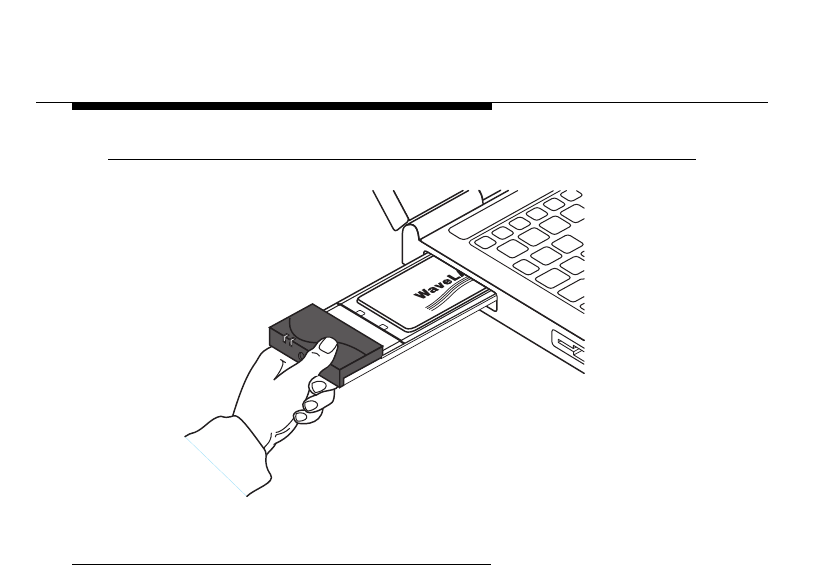
Hardware Installation
Installing your WaveLAN Kit
2-2 WaveLAN/IEEE Turbo 11 Mb PC Card
Figure 2-1 Inserting the PC Card into Your Computer
Card Removal and Re-insertion 2
WaveLAN adapter cards can be installed on various operating
systems, that may show different behavior when installing your
using your WaveLAN card:
■Plug & Play Compatible Systems
■Systems That Do Not Support Plug & Play
Depending on the type of operating system installed on your
computer, you can remove and re-insert your WaveLAN PC Card
whenever you like. This feature, also referred to as “Hot Swapping”
for PC Cards is supported by operating systems as described
under “Plug & Play Compatible Systems” below.
For systems that do not support “Plug & Play” you are advised to
follow the procedure as described under “Systems That Do Not
Support Plug & Play” on page 2-4.

Hardware Installation
Installing your WaveLAN Kit
WaveLAN/IEEE Turbo 11 Mb PC Card 2-3
Plug & Play Compatible Systems 2
Plug & Play for WaveLAN PC Cards is supported by the following
operating systems:
■MS-Windows 95, Windows 98 and Windows 2000 (formerly
known as Windows NT v5.0)
■Windows CE (version 2.0/2.11 and higher)
■Apple/Macintosh PowerBook systems.
When re-inserting the WaveLAN PC Card into your computer,
these operating systems will automatically:
1. Recognize the card
2. (Re-)load the driver and activate card operation
3. Attempt to restore the network connection.
When removing the card, these operating systems will:
1. Disable the WaveLAN driver and
2. Disconnect power to the PC Card slot.
!CAUTION:
When removing the WaveLAN card you will lose your
connection to the network.
Certain network operating systems however may not allow
you to restore the network logon automatically. In that
case you may need to restart your computer to rerun the
network login procedure to restore the network
connection.
You are advised to always disable the PC Card
prior
to removing
the card from the PC Card slot. This will allow the Windows
operating system to log off from the network server, disable the
driver properly and disconnect power to the PC Card slot.

Hardware Installation
Installing your WaveLAN Kit
2-4 WaveLAN/IEEE Turbo 11 Mb PC Card
For example to stop using the WaveLAN PC Card in Ms-Windows
environments, proceed as follows:
1. Click the “Start” button on the Windows Taskbar.
2. Click on “Settings” and then “Control Panel” item.
3. On the Control Panel double-click the PC Card icon to open
the PC Card (PCMCIA) properties window.
4. Select the PC Card socket that contains your WaveLAN/IEEE
Turbo 11 Mb PC Card and click the “Stop” button.
5. Wait for the operating system to acknowledge that the device
has been disabled and then remove the PC Card form the PC
Card slot.
NOTE:
A shortcut to disable the PC Card is clicking once on the
PC Card icon on the right side of the Windows Task bar,
and select the option "Stop WaveLAM/IEEE PC Card".
Double-clicking the PC Card icon, will open the PC Card
properties windows.
Systems That Do Not Support Plug & Play 2
Although Windows 95/98 and Windows NT version 4.0 are similar
in appearance, only Windows 95 and Windows 98 support true
“Plug & Play”.
When your computer runs one of the operating systems listed
below, neither “Plug & Play” support nor ‘”Hot Swapping” are
available for your WaveLAN/IEEE Turbo 11 Mb PC Card:
■Windows NT version 3.51
■Windows NT version 4.0
■MS-DOS

Hardware Installation
Installing your WaveLAN Kit
WaveLAN/IEEE Turbo 11 Mb PC Card 2-5
To remove your WaveLAN/IEEE Turbo 11 Mb PC Card from these
systems, you are advised to:
1. Power off your computer
2. Remove the WaveLAN PC Card from the PC Card slot
3. (optional) Restart the computer to proceed working with your
computer without the WaveLAN PC Card.
To (re-)insert the WaveLAN PC Card:
1. Power off your computer
2. (Re-)insert the WaveLAN PC Card into the PC Card slot
3. (optional) Restart the computer to proceed working with your
computer and the WaveLAN PC Card.
For more information about the differences between the
referenced Microsoft operating systems read the section “What
You Need to Know” on page 3-2.


Contents
3
Installation for Windows
Introduction 3-1
Before You Start the Installation 3-1
What You Need to Know 3-2
Getting Started in Windows 95/98 3-3
Starting Installation 3-3
Getting Started in Windows NT 3-5
Starting Installation 3-6
■Enabling PCMCIA Services 3-6
■Enabling Network Support 3-7
Installing the Miniport Driver 3-9
Network Installation 3-12
Setting the WaveLAN Parameters 3-13
Which Parameters Do You Need? 3-13
Basic WaveLAN Parameters 3-14
■WaveLAN Network Name 3-14
■Station Name 3-16
■Connecting to an Ad-hoc Network 3-17
WaveLAN Encryption Parameters 3-18

Finishing the WaveLAN Installation 3-20
After Restarting Your Computer 3-20
Working with WaveLAN & Windows 3-21
View Other WaveLAN Stations 3-21
Selecting the Networking Protocol 3-22
■Infrastructure Networks 3-22
■Ad-hoc Workgroup Networks 3-22
Verifying the Current Protocol Setting 3-23
Display or Modify WaveLAN Parameters 3-24

WaveLAN/IEEE Turbo 11 Mb PC Card 3-1
3
Installation for Windows
Introduction 3
This chapter describes the installation of the WaveLAN Miniport
Driver for Microsoft Windows 95, 98 & NT v.4.0.
Before You Start the Installation 3
To install and begin using your WaveLAN IEEE 802.11 PC Card,
you will need to install the following items:
■The WaveLAN IEEE 802.11 Miniport Driver.
■Network (client) Operating Software and Protocols.
■(optionally) The WaveMANAGER/CLIENT IEEE program.
The Network client software is included with the Windows
operating system software.
Before you start the installation, you are advised to keep the
Windows CD-ROM or software diskettes close at hand. If your
computer came with a factory-installed Windows operating system,
these files will be stored on your computer’s hard disk, in the form
of *.cab files.
NOTE:
If you are upgrading from an earlier version of the
WaveLAN Miniport driver, please read the section
“Upgrading the WaveLAN Miniport Driver” in Appendix B .

Installation for Windows
Introduction
3-2 WaveLAN/IEEE Turbo 11 Mb PC Card
What You Need to Know 3
Installing a WaveLAN IEEE 802.11 PC Card requires the same
level of expertise that you would need to install any other type of
standard Ethernet network adapter card. It is assumed that you
have a working knowledge of standard Windows 95, 98 or NT
operations and of installing network adapter cards.
Although similar in appearance, Windows 95, Windows 98 and
Windows NT operating systems show different behavior when
installing or operating new hardware on your computer.
The major differences between the operating systems are:
■“Plug & Play” support
■“User Profiles”
That’s why, you will find different “Getting Started” instructions for
each of the Microsoft operating systems described in this chapter:
■“Getting Started in Windows 95/98” on page 3-3
■“Getting Started in Windows NT” on page 3-5
The actual setting of the WaveLAN parameters is the same for
both type of systems (described on page 3-13).

Installation for Windows
Getting Started in Windows 95/98
WaveLAN/IEEE Turbo 11 Mb PC Card 3-3
Getting Started in Windows 95/98 3
Windows 95 and Windows 98 operating systems support “Plug &
Play” for PC Cards. Once you insert the WaveLAN card into your
computer, these operating systems will automatically:
■Detect the card, and enable the WaveLAN Miniport Driver, or
■Prompt you to install the driver, when the operating system
cannot find the required driver. This would typically occur when
inserting the WaveLAN IEEE 802.11 PC Card into your
computer for the very first time.
Once the WaveLAN Miniport Driver is installed, you can remove
and re-insert the card whenever you like. This is also referred to as
“Hot Swapping” (see also “Card Removal and Re-insertion” on
page 2-2).
The user profiles in Windows 95 and Windows 98 operating
systems are primarily used to customize the visual appearance of
your Windows desktop and user-defined preferences. These
profiles do not have any impact on the installation of your
WaveLAN card.
Starting Installation 3
To install the WaveLAN IEEE 802.11 PC Card on a computer
running either Windows 95 or Windows 98, proceed as follows:
1. Insert the WaveLAN Software CD-ROM in your computer.
2. Insert the WaveLAN/IEEE Turbo 11 Mb PC Card into your
computer.
3. Power up your computer.
Because both Windows 95 and Windows 98 support “Plug & Play”,
the operating system functionality will automatically detect your
WaveLAN IEEE 802.11 PC Card.

Installation for Windows
Getting Started in Windows 95/98
3-4 WaveLAN/IEEE Turbo 11 Mb PC Card
Once the operating system has identified the WaveLAN IEEE
802.11 PC Card, a message will be displayed identifying that the
WaveLAN drivers are being installed.
Turn to “Installing the Miniport Driver” on page 3-9 to continue the
installation of your WaveLAN IEEE 802.11 PC Card.
NOTE:
In some occasions Windows 95/98 operating systems may
not detect the new hardware. This may be the case in
situations where:
■The laptop computer into which you wish to install the
WaveLAN card is a brand-new “out-of-the-box”
computer, where the Windows 95/98 operating system
was already factory-installed.
■A previous installation of the WaveLAN adapter card
was aborted before it was finished.
When any of these situations applies, please consult
Appendix B <$paratext> for more information.

Installation for Windows
Getting Started in Windows NT
WaveLAN/IEEE Turbo 11 Mb PC Card 3-5
Getting Started in Windows NT 3
Unlike Windows 95/98, Windows NT operating systems (v3.51 and
v4.0) do not support “Plug & Play” and “Hot Swapping” of PC
Cards:
■In order to start the driver installation for your WaveLAN IEEE
802.11 PC Card, you will need to “introduce” the card to the
operating system.
■To swap PC cards, Windows NT machines typically require
you to restart the computer in order to recognize the card and
load the drivers.
Like Windows 95/98 systems, the Windows NT operating system
also identifies user profiles. On Windows NT systems, however,
user profiles (accounts) are associated with dedicated levels of
authority (privileges) like the ones listed below:
■Users - are allowed to change the visual appearance of the
Windows NT desktop and user-defined preferences.
■Power Users - can create “User Accounts” or “User Groups”.
■Administrators - can manage and control the overall
configuration of the workstation.
NOTE:
To install (or uninstall) the WaveLAN IEEE 802.11 PC Card
in a Windows NT environment, you will need to login as
the “Administrator”, or ensure that your login profile
provides the same level of privileges.
The privilege settings for each user (account) are set in the
Microsoft Windows NT “User Manager” program. Please consult
the documentation that was shipped with your Microsoft Windows
NT operating system or station for more information.

Installation for Windows
Getting Started in Windows NT
3-6 WaveLAN/IEEE Turbo 11 Mb PC Card
Starting Installation 3
To install the WaveLAN IEEE 802.11 PC Card on a computer
running Windows NT (version 3.51 or 4.0), proceed as follows:
1. Insert the WaveLAN IEEE 802.11 PC Card into your computer.
2. Power up your computer.
3. Enable PCMCIA Services
4. Enabling Network Support for your (client) station.
NOTE:
To be able to perform the steps as described on the
following pages, you will need the privileges of the
Windows NT station administrator.
From the Start menu, use the option “Log Off xxxxx” to
close all windows” and log on as “Administrator”.
Secondly, you will need to verify that the computer system
has at least NT Service pack v4.0 installed (check the
blue start-up screen of Microsoft Windows NT).
If the computer on which you plan to install the WaveLAN
PC Card is running with Service Pack v3.0 or lower, you
will need to download Service Pack v4.0 from the
Microsoft website (http://www.microsoft.com) and install
the Service Pack prior to installing the WaveLAN PC Card.
Enabling PCMCIA Services 3
To allow the Windows NT operating system to detect PC Cards in
the computer’s PC Card slot , you must enable the PC Card
Socket controller, identified as the PCMCIA device.
1. Click the Start button, then select “Settings” and then click
“Control Panel”.
2. Double-click the “Devices” icon.
3. Scroll down the list of devices and select the item “PCMCIA”.
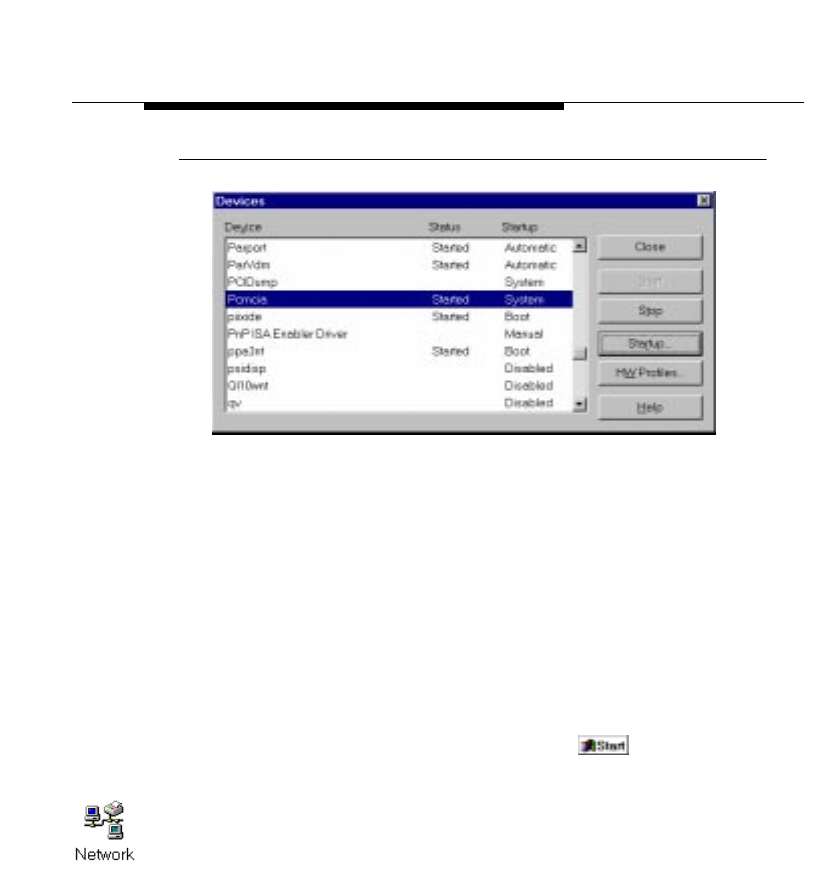
Installation for Windows
Getting Started in Windows NT
WaveLAN/IEEE Turbo 11 Mb PC Card 3-7
Figure 3-1 Enable the PCMCIA service for Windows NT
4. Click the button “Startup” on the right side of the “Devices”
window, and set the Startup type for the item PCMCIA to
“Boot”.
5. Click “OK” to confirm and return to the “Devices” window.
6. Click “Close” to return to the Control Panel.
Enabling Network Support 3
To introduce your WaveLAN network adapter card to the Windows
NT operating system, you will need to enable Network support for
your WaveLAN station.
1. From the Windows NT Taskbar, click the button.
2. Click on Settings, then Control Panel.
3. In the Control Panel window, double-click the “Network” icon to
open the “Network Settings” window.
■If no network has been installed yet, you will be prompted
to install it now.
Click “Yes” to install Windows NT Networking, and follow
the instructions as they appear on your screen.
■If networking support was already installed, you will see a
window with multiple tabs.
Select the tab “Adapters”, and click the “Add” button.

Installation for Windows
Getting Started in Windows NT
3-8 WaveLAN/IEEE Turbo 11 Mb PC Card
Windows NT Networking Setup will determine the type of
network adapter card that you will use to connect to the
network.
4. When prompted to select a driver, proceed with “Installing the
Miniport Driver” on page 3-9.

Installation for Windows
Installing the Miniport Driver
WaveLAN/IEEE Turbo 11 Mb PC Card 3-9
Installing the Miniport Driver 3
If your Windows operating system automatically detected your
hardware, it will prompt you to select a driver from a list, or install
the driver from a “Disk provided by Hardware Manufacturer”.
Some Windows operating systems may prompt you to select the
type of network adapter first, to select the appropriate driver (see
Figure 3-2).
Figure 3-2 Select WaveLAN Adapter Type
This is usually the case when:
■Your computer came with a factory-installed version of
Windows 95 (usually referred to as Windows 95 OSR2).
■Your computer runs the Windows NT operating system
(version 3.51 or 4.0), and you performed the steps as
described in “Getting Started in Windows NT” on page 3-5.
NOTE:
To make sure you install the latest available driver, always
select the “Disk provided by Hardware Manufacturer” or

Installation for Windows
Installing the Miniport Driver
3-10 WaveLAN/IEEE Turbo 11 Mb PC Card
the “Have Disk” option, to install the driver from the
WaveLAN Software CD-ROM that came with your
WaveLAN card.
Alternatively, you can use the “Browse” option to navigate
to the directory where you stored the set of files that you
downloaded from the WaveLAN website.
As Windows operating systems differ slightly (see “What You Need
to Know” on page 3-2), some of the screens pictured in this
chapter may look different from the actual display on your screen.
However, the parameter settings for your WaveLAN IEEE 802.11
PC Card will be similar for all Windows operating systems.
1. In the “Select Network Adapter” window, click the “Have Disk”
button.
2. Ensure that the WaveLAN Software CD-ROM has been
inserted into your computer, and click the button to
proceed.
When you downloaded the latest driver files from the
WaveLAN website:
■Use the “Browse” option on Windows 95/98 systems, to
navigate to the harddisk drive and folder where you saved
the driver files.
■Windows NT systems will not allow you to “browse” for a
harddisk folder as an alternative to a floppy disk. For such
systems you will need to extract the downloaded files first,
and copy the extracted files to a diskette.
Windows will start copying files from your Windows installation
disks or CD-ROM and the WaveLAN Software CD-ROM.
3. If the system prompts you to identify the location of files (see
Figure 3-3 on page 3-11), enter the correct drive and directory,
and click the button to proceed.

Installation for Windows
Installing the Miniport Driver
WaveLAN/IEEE Turbo 11 Mb PC Card 3-11
Figure 3-3 Identify the Location of Files
■For Windows system files (typically *.dll) this is usually the
Windows CD-ROM. e.g. d:\cd-rom.
■When your computer came with the Windows operating
system factory-installed, point to the directory that
contains the Windows setup files (*.cab): e.g.
c:\windows\options\cabs
■When the system prompts you to identify the WaveLAN
Driver files (typically file names starting with the characters
wv*.*), specify the drive and directory that contains your
WaveLAN software:
— If installing from the WaveLAN CD-ROM
d:\software\adapter\pc_card\drivers\windows
where “d” represents the drive letter of your CD-ROM.
— if installing files that you downloaded from the internet
point to the floppy disk drive or directory where you
saved the downloaded files.
When you had a network adapter installed on your
computer before, most of these files are already available
on your hard disk drive. If you do not have the Windows
CD-ROM available, you may try replacing the proposed
path in the “Copy files from” dialog box with:
c:\windows\system or c:\windows\

Installation for Windows
Installing the Miniport Driver
3-12 WaveLAN/IEEE Turbo 11 Mb PC Card
Network Installation 3
If this is the very first time that Networking support is installed onto
your computer, the Windows operating system will prompt you to
enter a computer and workgroup name. These names will be used
to identify your computer on the Microsoft Network Neighborhood.
Figure 3-4 Windows Network Identification Properties
1. Click the button to display the window as pictured in
Figure 3-4.
2. In the “Computer Name” field, enter a unique name for your
computer.
3. In the “Workgroup” field, enter the name of your workgroup.
4. (Optional) Provide a description of the computer in the
“Computer Description” field.
For more information about setting your Windows Network
Properties, consult your Windows documentation or the Windows
on-line help information.

Installation for Windows
Setting the WaveLAN Parameters
WaveLAN/IEEE Turbo 11 Mb PC Card 3-13
Setting the WaveLAN Parameters 3
When you confirm the Windows Network Identification parameters,
Windows will open the parameter window for your WaveLAN
adapter as pictured in Figure 3-5.
On computers running the Windows NT operating system, you will
see additional tab labeled “Adapter”, that enables you to verify
and/or modify the factory-set values for the I/O Port address of
your WaveLAN Adapter, and its IRQ value1.
1. Enter the values that you wrote down when running the
Windows NT Diagnostics as described on page B-7.
2. Click the “Continue” button, to display the parameter
window for your WaveLAN adapter.
The “WaveLAN Properties” window enables you to specify the
WaveLAN specific parameters, required to connect your computer
to the WaveLAN IEEE 802.11 network system.
Which Parameters Do You Need? 3
When connecting your station to an IEEE 802.11 wireless network
infrastructure, you will only need to set the following parameters:
■WaveLAN Network Name
■Station Name
In this Quick Installation Guide these parameters are described as
the “Basic WaveLAN Parameters”.
Looking at the WaveLAN Parameter window, you will also see a
set of Advanced WaveLAN Parameters, and “Power
1 For computers running the Windows 95 or Windows 98 operating system,
you do not need to set these parameters. On these systems, the allocation
of these device settings is controlled via the “Plug & Play” mechanism.

Installation for Windows
Setting the WaveLAN Parameters
3-14 WaveLAN/IEEE Turbo 11 Mb PC Card
Management”, which are described in the on-line help file of the
driver and in Chapter 4 .
You are advised to leave these to their default settings, unless
there are special situations, for example, upon advice of a
WaveLAN IEEE 802.11 expert.
NOTE:
Always consult your LAN Administrator for the parameter
settings that apply to your network environment.
Basic WaveLAN Parameters 3
The Basic WaveLAN Parameters are the minimum set of
parameters that should be set to get your WaveLAN IEEE 802.11
network up and running. These parameters include:
■WaveLAN Network Name
■Station Name
WaveLAN Network Name 3
When you wish to connect your computer to an IEEE 802.11
Infrastructure as pictured in Figure 1-3 on page 1-3 and Figure 1-4
on page 1-4, you have two options:
■“Connecting to Any Network” as described on page 3-15, or
■“Connecting to a Specific Network” as described on page 3-16.
The WaveLAN Network Name will determine to how your
WaveLAN station will behave when powered up in an IEEE 802.11
Infrastructure.
If you are unfamiliar with the two types mentioned above, please
consult the section “Connecting to a Network” in Chapter , on page
1-17.
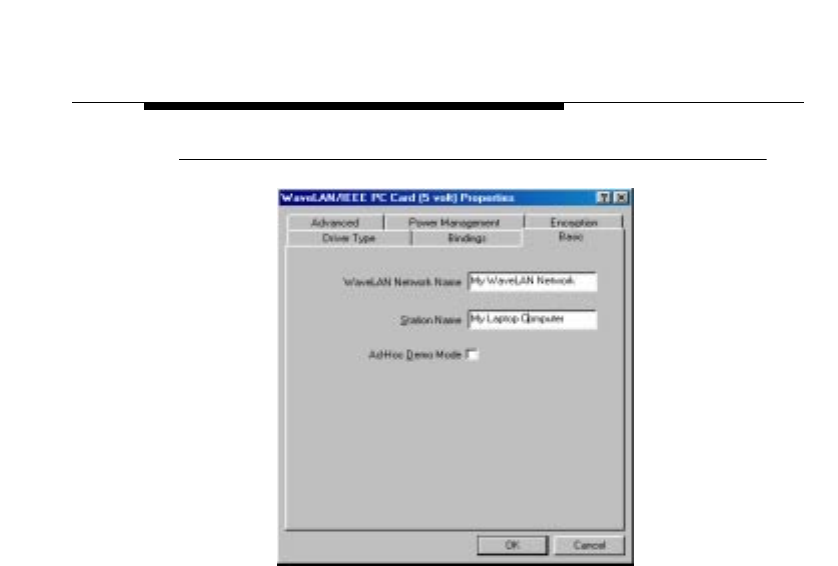
Installation for Windows
Setting the WaveLAN Parameters
WaveLAN/IEEE Turbo 11 Mb PC Card 3-15
Figure 3-5 Setup WaveLAN Parameters
Connecting to Any Network 3
To connect to any IEEE 802.11 network in the vicinity of your
WaveLAN computer, you can leave WaveLAN Network Name field
blank, or enter the name “ANY” (all characters in upper-case).
When your WaveLAN Network name is set to “ANY”, your
computer will attempt to establish a radio connection with any
IEEE 802.11 network that provides good communications quality.
You may wish to use the “ANY” option when:
■You operate your computer in multiple network environments,
that are identified by different WaveLAN Network Names.
■You do not know the WaveLAN Network Name of the network
to which you would like to connect your computer.

Installation for Windows
Setting the WaveLAN Parameters
3-16 WaveLAN/IEEE Turbo 11 Mb PC Card
Connecting to a Specific Network 3
If you would like to connect to one specific WaveLAN Network only,
enter the “WaveLAN Network Name” that applies to your network,
for example: “MY_WAVELAN_NETWORK”.
This is the WaveLAN Network Name that the LAN Administrator
programmed into the WavePOINT-II access points. Consult your
LAN Administrator for the value that applies to your network.
Setting up a New IEEE 802.11 Infrastructure? 3
When setting up a new IEEE 802.11 network, you may enter a
“WaveLAN Network Name” of your choice. This name should also
be programmed into other WaveLAN stations, and (if applicable)
the WavePOINT-II access points.
The WaveLAN Network Name can be any alphanumeric string in
the range of “a” to “z”, “A” to “Z” and “0” to “9”. This string which
can contain from 1 to 32 characters is case-sensitive.
Example: “MY_WAVELAN_NETWORK”
Station Name 3
The Station Name is a name that will be used to identify your
WaveLAN station in the WaveLAN diagnostic tools described in
Chapter 4.
■When your computer runs the Windows 95 or Windows 98
operating system, enter a string of alphanumeric characters in
the range of “a-z”, “A-Z” and “0-9” with a maximum of 32
characters.
You are advised to use the same name as the one you entered
in the “Computer Name” field in your Windows Network
Neighborhood Properties (see Figure 3-4 on page 3-12).

Installation for Windows
Setting the WaveLAN Parameters
WaveLAN/IEEE Turbo 11 Mb PC Card 3-17
■When your computer runs the Windows NT operating system,
the Station Name field is not available. On these systems, the
diagnostic tools will use the “Computer Name” value from the
“Identification” tab.
Connecting to an Ad-hoc Network 3
In case you do not wish to connect to a network infrastructure, but
prefer to setup a small wireless workgroup as pictured in Figure
1-2 on page 1-2, you can enable the “Ad-hoc Demo Mode” tick
box.
In Ad-hoc Demo Mode, your computer will:
■Ignore the WaveLAN Network Name
■Ignore WavePOINT-II access points
■Fix the radio to operate at its factory-set default channel.
This means that your WaveLAN IEEE station can communicate
with any other WaveLAN IEEE station within its range, provided
that these stations have been equipped with cards that have a
matching default radio frequency (see Table A-6 on page A-8).
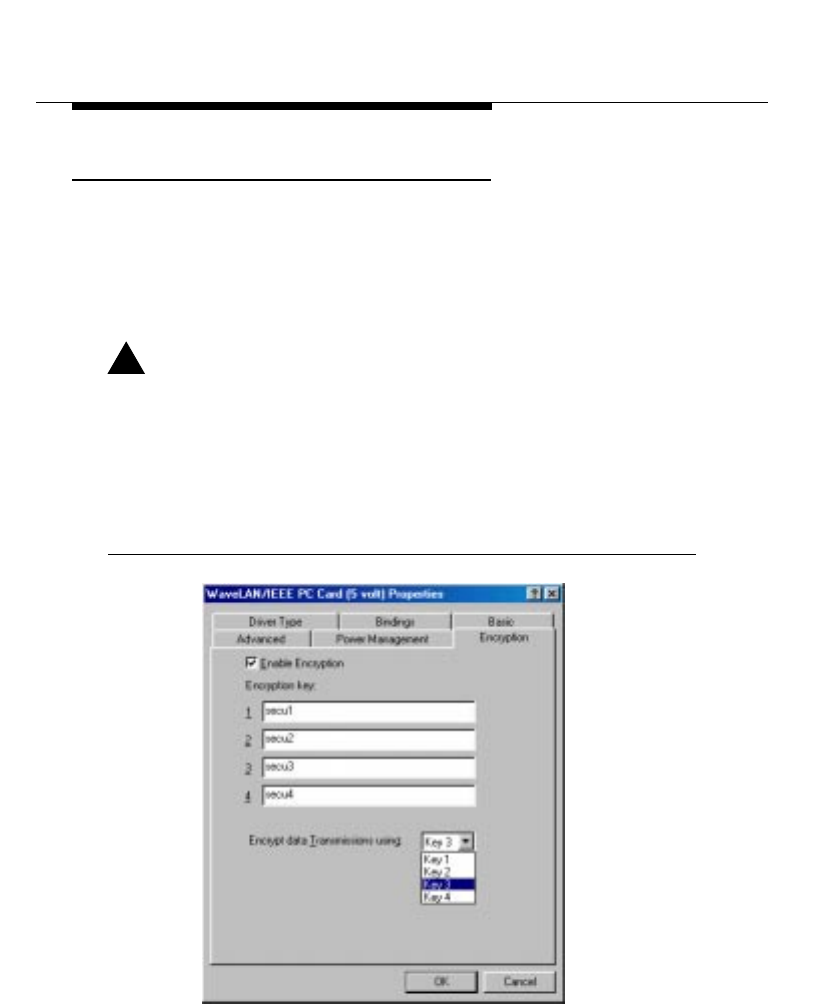
Installation for Windows
Setting the WaveLAN Parameters
3-18 WaveLAN/IEEE Turbo 11 Mb PC Card
WaveLAN Encryption Parameters 3
The encryption tab enables you to define the encryption keys that
your WaveLAN/IEEE Turbo 11 Mb PC Card should use to:
■Decrypt wireless messages received via its wireless interface.
■Encrypt data that will be transmitted via the wireless interface.
!CAUTION:
The encryption feature only works with WaveLAN IEEE
Silver and Gold Label PC Cards. If the PC Card in your
computer is an an older type WaveLAN/IEEE PC Card
which does not support encryption (typically (identified by
a Bronze or White Label ), do not enable encryption.
Doing so may prevent the card from normal operation.
Figure 3-6 Setup WaveLAN Encryption Parameters

Installation for Windows
Setting the WaveLAN Parameters
WaveLAN/IEEE Turbo 11 Mb PC Card 3-19
You can identify up to 4 different key values to decrypt wireless
data, and select one of these keys to encrypt wireless data
transmissions.
Subject to the type of WaveLAN PC Card, the key value of your
choice may either be:
■5 alphanumeric characters in the range of “a-z”, “A-Z” and “0-
9” for Silver cards.
■16 alphanumeric characters in the range of “a-z”, “A-Z” and “0-
9” for Gold cards.
The alphabetical characters you select are “case-sensitive”.
Example: Secu1 for silver cards, or Security Key1234 for Gold
cards.
Alternatively, you may select to enter a hexadecimal string,
preceded by the characters “0x”values, being either:
■10 digit hexadecimal values in the range of “A-F” and “0-9” for
Silver cards.
■32 digit hexadecimal values in the range of “A-F” and “0-9” for
Gold cards.
Example: 0xABCD1234FE for Silver cards, or
0x1234567890ABCDEF0987654321FEDCBA for Gold cards
!CAUTION:
To allow encrypted data communications, you must set the
same encryption key values on all stations and/or access
points.
Carefully write down the values you enter here, and keep
this note in a secure place.
The values you enter on the encryption tab, will only be
visible the first-time you enter the keys. After closing this
tab, all key values will be displayed as “
xxxxxxxxxxx
” every
time the tab is displayed again.
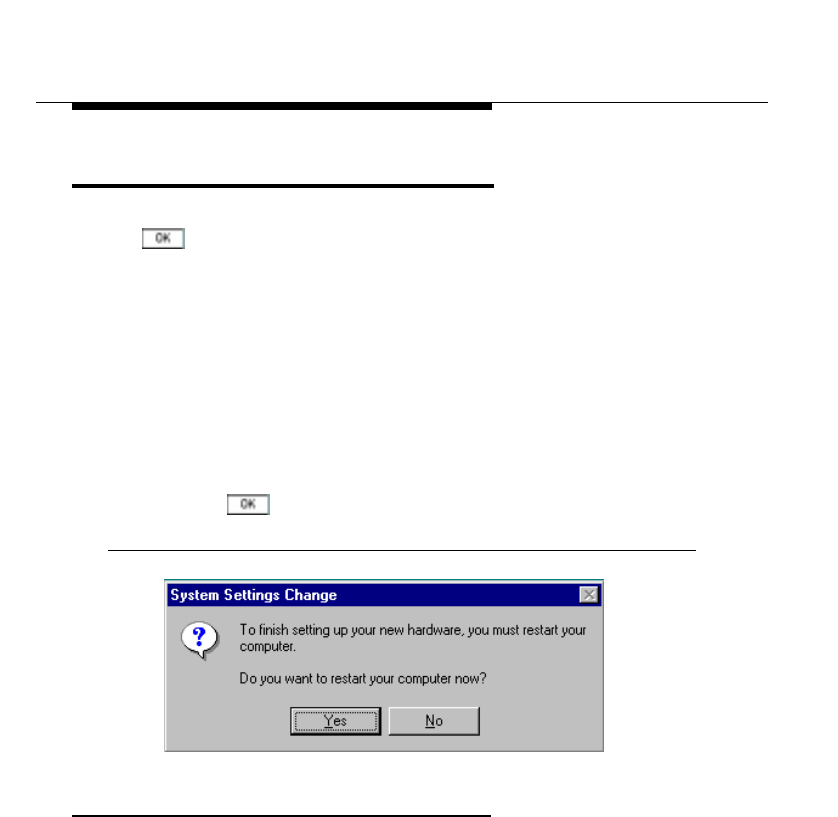
Installation for Windows
Finishing the WaveLAN Installation
3-20 WaveLAN/IEEE Turbo 11 Mb PC Card
Finishing the WaveLAN Installation 3
When you have finished “Setting the WaveLAN Parameters”, click
the button to proceed with the installation process. Windows
will finish building the driver configuration database and copy some
files from your CD-ROM or diskette to your computer’s hard disk.
If the Windows operating system prompts you to identify the
location of the Windows files, specify the drive and directory of the
Windows Installation CD-ROM or diskettes (see also page 3-11).
When Windows has finished the copying of files, it will prompt you
to restart your computer.
1. Remove the WaveLAN software diskette from drive A:\
2. Click the button to restart your computer.
Figure 3-7 Finished Setting up the Hardware
After Restarting Your Computer 3
After you have restarted your computer, the Windows operating
system should detect the WaveLAN IEEE 802.11 PC Card (you
can hear the two-tone sound of the PC Card Socket Controller).
Windows will load the WaveLAN IEEE 802.11 Miniport driver and
will open with a dialog box that enables you to enter a user name
and password. The password you enter here will be the one used
to log into the Windows Network Neighborhood.

Installation for Windows
Working with WaveLAN & Windows
WaveLAN/IEEE Turbo 11 Mb PC Card 3-21
Working with WaveLAN & Windows 3
View Other WaveLAN Stations 3
When multiple WaveLAN stations are up-and-running in your
wireless network, you can use the procedure described below to
display the other computers:
1. Start Windows Explorer.
2. Scroll down the list of files and folders to look for the item
“Network Neighborhood”.
3. Double-click the “Network Neighborhood” item to display all
stations in your Microsoft Networking Group.
4. To display other workgroups in the network environment,
double-click the “Entire Network” icon.
5. If there is a second network operating system running in your
network environment (for example a Novell NetWare network),
the “Entire Network” window, will also display available servers
running under the second network operating system.
If you click on these servers, you may be asked to enter your
user name and password that apply to the other network
operating system
If you cannot find other (WaveLAN) networked computers,
verify whether or not the other WaveLAN computers are:
■Powered up and logged on to the network.
■Configured to operate with an identical:
— Networking Protocol.
— WaveLAN Network Name
To verify the radio connection with other stations, you can also run
the Monitoring Options as described in Chapter 5 .

Installation for Windows
Working with WaveLAN & Windows
3-22 WaveLAN/IEEE Turbo 11 Mb PC Card
Selecting the Networking Protocol 3
Upon initial installation, your Windows operating system will
typically install a basic set of networking protocols.
You may need to check whether the network installation process:
■Truly added the protocols required to communicate with other
computers in your network environment.
■Configured the appropriate protocol settings to allow
communication within your networking environment.
Infrastructure Networks 3
When connecting your station to a network infrastructure, you will
usually need additional networking protocols, according to the
network operating system used within your LAN environment.
The most common protocols are:
■IPX/SPX compatible protocols when your networking
environment is using the Novell NetWare network operating
system.
■NetBEUI when you would like to use file and printer sharing, as
supported by Microsoft Networking for Windows Workgroups.
■TCP/IP when you would like to connect your computer to a
network that uses IP addressing, and/or you would like to
connect to the internet.
These networking protocols can operate simultaneously with any
other networking protocol.
Ad-hoc Workgroup Networks 3
When connecting your station to an ad-hoc wireless workgroup,
you will also need a networking protocol that will allow your station
to participate in peer-to-peer networking.

Installation for Windows
Working with WaveLAN & Windows
WaveLAN/IEEE Turbo 11 Mb PC Card 3-23
The most common protocols are:
■NetBEUI when you would like to use file and printer sharing, as
supported by Microsoft Networking for Windows Workgroups.
■TCP/IP when you would like to use “local webserver”
capabilities that allow participants to surf (designated areas of)
one-another’s disk-drives using an Internet Browser.
When using the TCP/IP protocol, each workgroup participant
must be identified by a unique IP Address value.
Consult your Microsoft documentation for more information about
protocols and peer-to-peer networking.
Verifying the Current Protocol Setting 3
To verify whether your station has been configured for the correct
type of network and networking protocols:
1. Click the button from the Windows Taskbar.
2. Click on Settings, then Control Panel.
3. In the Control Panel, double-click the “Network” icon.
4. Verify that the list of network components includes the
following items:
■Client for Microsoft Networks.
■(optional) Client for NetWare Networks.
If the item of your choice is already available, click the
button to exit this configuration screen and skip to the next
step.
If the items you require are missing, click the “Add” button and
select “Add Client” to add the client software of the networking
software that you would like to install.

Installation for Windows
Working with WaveLAN & Windows
3-24 WaveLAN/IEEE Turbo 11 Mb PC Card
5. When the proper Client software is installed, but you do not
see the required protocols, click the “Add” button, and follow
the instructions of the Windows operating system as they
appear on your screen.
Consult your LAN Administrator for more help or information about
configuring the IPX/SPX and/or TCP/IP properties.
Display or Modify WaveLAN Parameters 3
If you would like to view or modify WaveLAN parameters, for
example because you would like to connect to another network or
type of network, proceed as follows:
1. Click the button from the Windows Taskbar.
2. Click on Settings, and then on Control Panel.
3. Double-click the “Network” icon.
4. In the Network Properties Window, select the WaveLAN IEEE
802.11 PC Card Adapter and click the “Properties” button.
5. (Optional) Change the parameters you would like to modify,
and click
■the button to confirm your changes, or
■the button to ignore your modifications.

Contents
4
Advanced WaveLAN
Parameters
Introduction 4-1
MAC Address 4-2
AP Density 4-3
Transmit Rate 4-4
The Auto Transmit Rate Select Mechanism 4-4
The User-defined Transmit Rate 4-5
Medium Reservation 4-8
■About the Hidden Station Problem 4-8
■About the Medium Reservation Mechanism 4-11
Power Management 4-13
Enable Power Management: 4-14
■Maximum Sleep Duration 4-15
■Receive All Multicasts 4-15

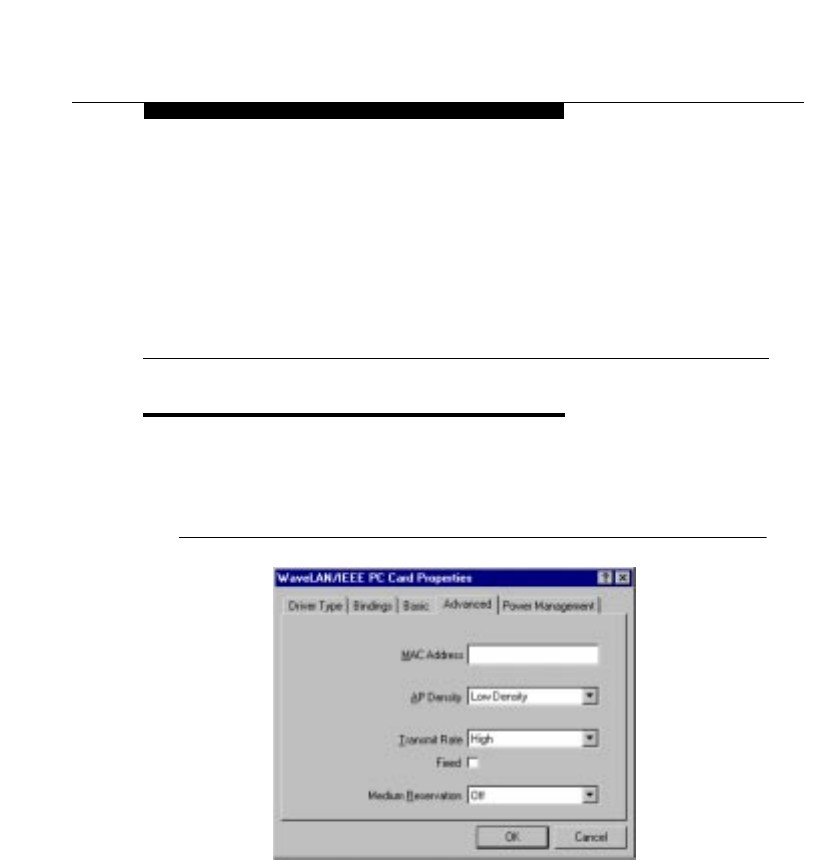
WaveLAN IEEE 802.11 PC Card User’s Guide 4-1
4
Advanced WaveLAN
Parameters
Introduction 4
In most network environments you will not need to change the
settings of the Advanced Parameters, as their default settings will
prove most efficient for normal network communications.
Figure 4-1 Advanced WaveLAN Parameters
In special situations however, for example upon advice of an IEEE
802.11 WaveLAN expert, you may wish to change the defaults of
the parameters described in this chapter.
To display the parameters, follow the instructions as described
under “Display or Modify WaveLAN Parameters” on page 3-24.

Advanced WaveLAN Parameters
MAC Address
4-2 WaveLAN IEEE 802.11 PC Card User’s Guide
MAC Address 4
All WaveLAN IEEE 802.11 PC Cards have a unique Universal
MAC Address that is used to identify your computer on the
network.
■For most network operating systems, you will not need to
change this parameter, i.e. you can leave this field blank.
■When your network system uses a “Local MAC Addressing”
scheme, you may need to assign a Local MAC Address value
to the WaveLAN IEEE 802.11 PC Card of your computer.
Valid address values are 12-digit, hexadecimal values, where
the 2nd digit must be either 2, 6, A, or E.
Consult your LAN Administrator to find out whether your network
requires Local MAC Addresses, and (if applicable) to obtain a
unique Local MAC Address value.
NOTE:
The Access Control security feature for WavePOINT-II
access points (described on page 6-3) does not work in
systems that use Local MAC Addressing. If you would like
to use Access Control, you must disable Local MAC
Addressing.
If you do not wish to assign a Local MAC Address, you should
leave the MAC Address field blank, or enter the value “0” (zero).

Advanced WaveLAN Parameters
AP Density
WaveLAN IEEE 802.11 PC Card User’s Guide 4-3
AP Density 4
The Access Point Density parameter controls the roaming
sensitivity of your wireless station. This parameter should be set
according to match:
■The density of the WavePOINT-II access points that have
been installed throughout the wireless network area, and
■The setting of this parameter in the configuration of the access
points.
Figure 4-2 Access Point Density Parameter
Consult your LAN Administrator for the appropriate values that
apply to your network. Valid values are:
■Low (default)
■Medium
■High
!CAUTION:
Using non-matching values may seriously affect wireless
performance of your wireless station.

Advanced WaveLAN Parameters
Transmit Rate
4-4 WaveLAN IEEE 802.11 PC Card User’s Guide
Transmit Rate 4
The actual data transmission speed of your WaveLAN device is
subject to the following criteria:
■The type of WaveLAN IEEE cards at both ends of the wireless
link, being:
■The card inserted into your computer, and
■The card inserted into the WavePOINT-II or,
the peer-to-peer partner in an Ad-hoc network.
■The communications quality of the wireless link.
■The user-defined preference for the data Transmit Rate.
NOTE:
Transmissions at high data rates do not cover the same
distances as wireless data transmitted at Standard or Low
data rates (see Table A-4 on page A-5).
When upgrading from standard WaveLAN cards to Turbo
cards, you may need to perform a site survey again to
verify that the entire coverage area allows for data
transmissions at the highest transmit rates.
The Auto Transmit Rate Select Mechanism 4
In most networking scenarios, you will see that the factory-set
default “High” will prove the most efficient. Whenever your card
communicates via the wireless medium it will:
■Sense the maximum transmit rate as supported by both
communication partners, and switch to that Transmit Rate.
■Determine if the communication quality allows for
communicating at this data rate.

Advanced WaveLAN Parameters
Transmit Rate
WaveLAN IEEE 802.11 PC Card User’s Guide 4-5
Transmissions at lower data speeds are usually more reliable.
Therefore when the communications quality drops beneath a
certain level, the WaveLAN cards will automatically switch to a
lower data rate.
When the communications quality improves again, both
WaveLAN cards will gradually increase the data rate again,
until they have reached the highest available Transmit Rate as
supported by both cards.
The User-defined Transmit Rate 4
If you wish to balance speed versus reliability, you can also select
a user-defined preference from the following four options:
■High (default)
■Medium
■Standard
■Low
Figure 4-3 WaveLAN Transmit Rate

Advanced WaveLAN Parameters
Transmit Rate
4-6 WaveLAN IEEE 802.11 PC Card User’s Guide
Optionally, you can select to disable the Auto-Transmit Rate Select
mechanism, by “fixing” the Transmit Rate to the selected user-
defined preference. You are advised however to do so only in
special circumstances, typically upon advice of a WaveLAN IEEE
expert or WaveLAN Technical Support representative.
■Use the default “High” with Auto-Transmit Rate Select rate
(i.e. the Fixed tick box is cleared) to in regular networking
environments. This setting will allow your WaveLAN card to
operate at the maximum data rate as supported by the
hardware:
— Ethernet equivalent speed for WaveLAN IEEE Turbo cards.
— IEEE 802.11 Standard speed for regular WaveLAN IEEE
802.11 cards.
■Use “High - Fixed” data rate only in networking environments
where:
— You are certain that all wireless devices can communicate
at the highest Transmit Rate, and
— Where performance appears to slow down as a result of
many retransmissions, even though the wireless coverage
provides an “Excellent Radio Connection”.
This situation may occur in exceptional cases where for
example Microwave ovens in the WaveLAN Signal path
interfere with WaveLAN data communication.
■Use “Standard” in Ad-hoc wireless workgroups, where the
wireless peers in the workgroup have been equipped with
standard WaveLAN IEEE adapters, that do not support the
Medium and High data rates.
■Use “Low - Fixed” only in networking environments where
range of the wireless connection is more important than speed.
This setting will “instruct” your WaveLAN adapter to conserve
resources by not attempting to (re-)transmit data at higher data
rates.

Advanced WaveLAN Parameters
Transmit Rate
WaveLAN IEEE 802.11 PC Card User’s Guide 4-7
NOTE:
The actual transmit rates “High” and “Medium” are only
supported by WaveLAN IEEE 802.11 Turbo cards.
Regular WaveLAN IEEE 802.11 adapter cards that do not
support these transmit rates, will interpret the settings
“High” and “Medium” in the same way as the setting
“Standard”.

Advanced WaveLAN Parameters
Medium Reservation
4-8 WaveLAN IEEE 802.11 PC Card User’s Guide
Medium Reservation 4
It is normal behavior for WaveLAN stations to defer transmissions
automatically when they sense that another WaveLAN device is
using the wireless medium.
This behavior also referred to as the Carrier Sense Multiple
Access/Collision Avoidance protocol (CSMA/CA) will avoid that
wireless messages would collide in situations where two or more
stations would start transmissions at the same time.
The Medium Reservation mechanism enables you to improve
wireless performance in network environments where the CSMA/
CA protocol would fail due to the “hidden station” problem as
pictured in Figure 4-4 on page 4-9.
Medium Reservation may provide a solution for networks where:
■The density of WaveLAN stations and WavePOINT-II access
points is very low.
■You witness poor network performance due to excessive frame
collisions at the WavePOINT-II access points.
About the Hidden Station Problem 4
A hidden station is a situation in which two stations are within
range of the same WavePOINT-II, but are not within range of each
other.
Figure 4-4 on page 4-9 illustrates an example of the “Hidden
Station” problem. Both Station A and Station B are within range of
the WavePOINT-II access point however, Station B cannot “hear”
Station A, therefore Station A is a “hidden station” for Station B.
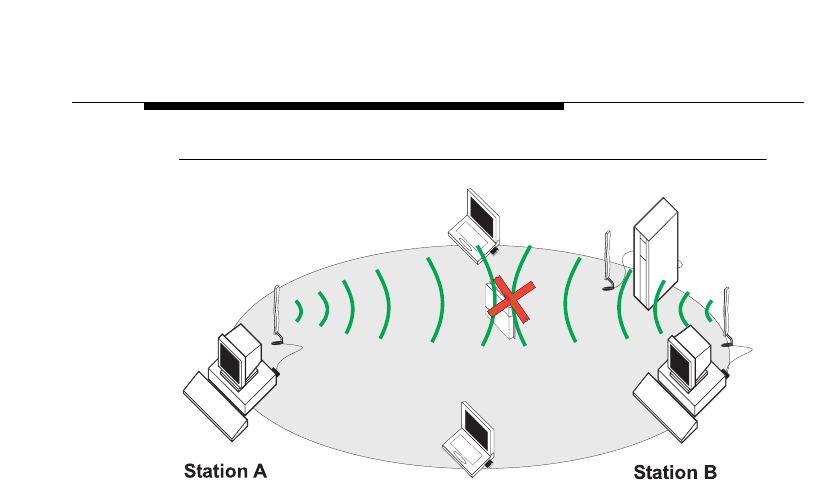
Advanced WaveLAN Parameters
Medium Reservation
WaveLAN IEEE 802.11 PC Card User’s Guide 4-9
Figure 4-4 The Hidden Station Problem
When Station B starts to communicate with the WavePOINT-II
access point, it might not notice that Station A is already using the
wireless medium. When Station A and Station B send messages at
the same time, they might collide when arriving simultaneously at
the WavePOINT-II access point. The collision will most certainly
result in a loss of messages for both stations.
In situations as pictured Figure 4-4, Medium Reservation may
provide a solution to prevent message collisions by handing over
transmission control to the WavePOINT-II access point.
Troubleshooting a “Hidden Station” problem usually provides the
best results when it is performed on the suspected WaveLAN
Client stations that suffer from errors as a result of the “hidden
station” problem.
When configuring the WaveLAN card parameters (in the PC Card
properties window) you can set the Medium Reservation
parameter to either:
■“Hidden Station”, or
■“Off”
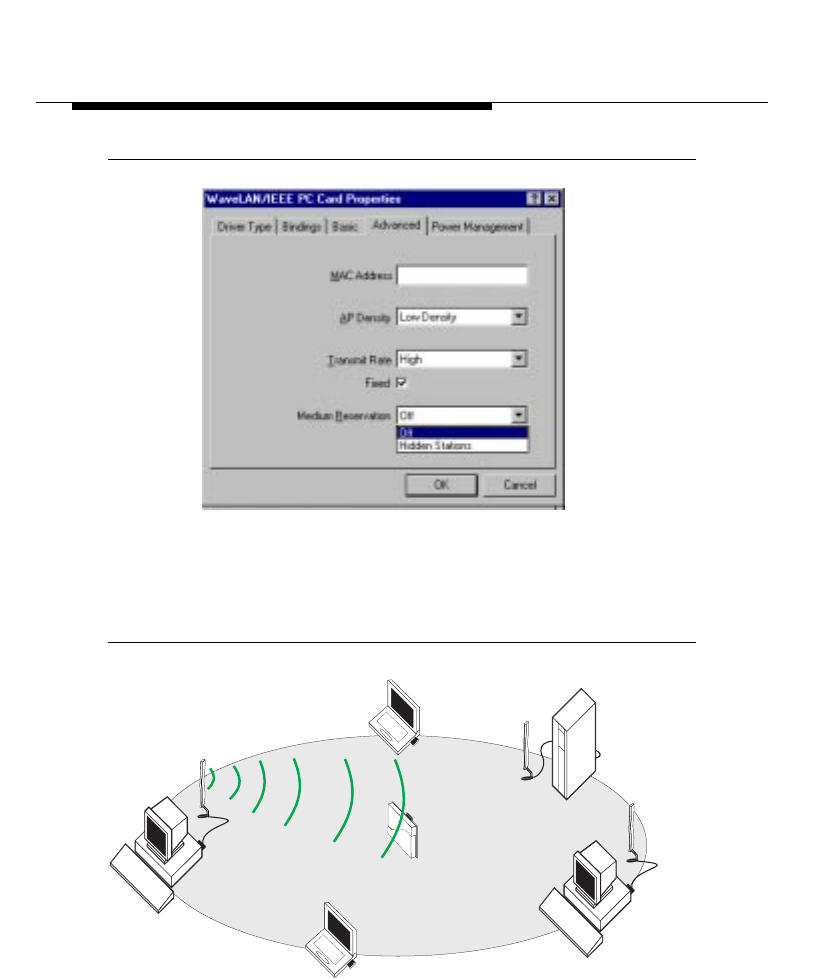
Advanced WaveLAN Parameters
Medium Reservation
4-10 WaveLAN IEEE 802.11 PC Card User’s Guide
Figure 4-5 Medium Reservation Parameters
You can enable Medium Reservation on individual stations, i.e. the
setting of this parameter does not have to be the same for all
WaveLAN devices in your network.
Figure 4-6 Medium Reservation “Request to Send”
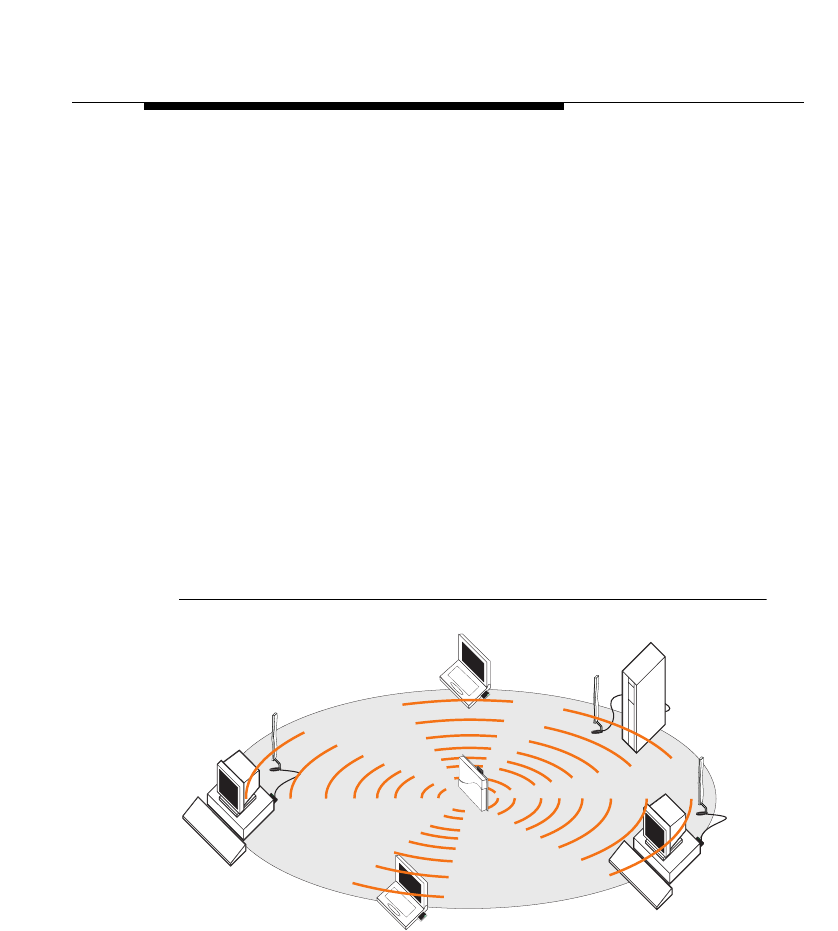
Advanced WaveLAN Parameters
Medium Reservation
WaveLAN IEEE 802.11 PC Card User’s Guide 4-11
About the Medium Reservation Mechanism 4
When you enable Medium Reservation on a suspect “hidden
station”, this WaveLAN station and its WavePOINT-II access point
will use a Request to Send/Clear to Send protocol (RTS/CTS).
■The station will send an RTS to the WavePOINT-II device, that
will include information about the length of the frame that the
station would like to transmit (see Figure 4-6).
■Upon receipt, the WavePOINT-II device will respond with a
CTS message to all stations within its range to:
— Notify all other stations to defer transmissions for the time-
frame of the requested transmission.
— Confirm the requestor station that the WavePOINT-II has
checked the medium for availability, and has reserved it for
the time-frame of the requested transmission. The CTS
process is Figure 4-7 on page 4-11.
Figure 4-7 Medium Reservation “Clear to Send”

Advanced WaveLAN Parameters
Medium Reservation
4-12 WaveLAN IEEE 802.11 PC Card User’s Guide
NOTE:
In most networking environments it is very unlikely that
you will need to enable Medium Reservation on the
WavePOINT-II to prevent collisions.
Since all stations connected to a WavePOINT-II device are
typically within range of the WavePOINT-II device they
should be able to sense whenever the WavePOINT-II is
using the medium to transmit messages via the wireless
medium.
Enabling Medium Reservation on the WavePOINT-II
would require the WavePOINT-II to ask for a CTS for every
message that it wishes to forward to stations within its
range, even if it is forwarding traffic between stations that
belong to the same wireless cell.
This might cause redundant network overhead that could
negatively affect the throughput performance instead of
providing a remedy.

Advanced WaveLAN Parameters
Power Management
WaveLAN IEEE 802.11 PC Card User’s Guide 4-13
Power Management 4
The Power Management option on your WaveLAN IEEE 802.11
PC Card is designed to conserve battery life of your portable
computing device. When Power Management is enabled, your
WaveLAN card will go into “sleep” mode, to minimize power
consumption.
While in “sleep” mode, all network traffic addressed to your station
will be buffered in the WavePOINT-II unit. At regular intervals, your
WaveLAN card will “wake up” to verify whether there is information
buffered at the WavePOINT-II access point.
■If there is no traffic, your WaveLAN card will return to power-
saving sleep mode.
■If there is buffered traffic, the station will collect it and return to
sleep mode.
The Power Management feature is best suited for transaction-
based processing. In network environments characterized by
heavy data traffic, enabling Power Management may affect
throughput performance as perceived at the wireless station.
NOTE:
Power Management requires dedicated support from the
WavePOINT-II access points. Previously purchased/
installed WavePOINT-II access points may not yet support
buffering of traffic for wireless clients in sleep mode.
Before enabling Power Management on your WaveLAN
computer, please consult your LAN Administrator to verify
whether the WavePOINT-II access points have been
upgraded to support this feature.

Advanced WaveLAN Parameters
Power Management
4-14 WaveLAN IEEE 802.11 PC Card User’s Guide
Enable Power Management: 4
1. Right click the Network Neighborhood icon, and select
“Properties”.
2. Select the WaveLAN/IEEE PC Card, and click “Properties”.
3. Select the “Power Management” tab
4. Enable “Card Power Management”.
Figure 4-8 WaveLAN Power Management Parameters
When Power Management is enabled, the Power LED will “flicker”,
as compared to a stable green Power LED for the WaveLAN IEEE
802.11 PC Card not utilizing the Power Management feature.
To manage the power consumption of your WaveLAN card, you
will use the following PC Card property settings:
■Maximum Sleep Duration
■Receive All Multicasts

Advanced WaveLAN Parameters
Power Management
WaveLAN IEEE 802.11 PC Card User’s Guide 4-15
Maximum Sleep Duration 4
The Maximum Sleep Duration identifies the “listen interval” (in
milliseconds) for WaveLAN cards in sleep mode. At the specified
listen interval, the WaveLAN card will “wake up” and check to see if
there is network traffic addressed to your station.
The default setting is 100 milliseconds (ms). For notebook and
desktop computers, we recommend that you do
not
change this
value, since this may interfere with standard operation of your
Network Operating System. Hand-held devices may consider
higher values, but first check the user manual that came with the
device.
Receive All Multicasts 4
When multicast frames are sent to the WaveLAN card, the card will
be prompted to “wake up” at regular intervals to receive all
multicast frames from the network.
The default and recommended setting of this parameter is enabled
to receive all multicast frames.
When using Power Management on a networked computer, we
advise you not to disable the “Receive All Multicast” option, unless
you are absolutely certain that neither the application, nor the
higher layer protocols of the network system need multicast
messages for proper communication (for example, in a single-
application, single-protocol system like a hand-held scanner).
!CAUTION:
Disabling the “Receive All Multicast” option for networked
computing devices in regular networking environments
may affect the performance of your computer. Missing too
many Multicast messages might result in losing your
network connection.


Contents
5
Monitoring WaveLAN
Performance
About WaveMANAGER/CLIENT 5-1
Installing WaveMANAGER/CLIENT 5-2
Running WaveMANAGER/CLIENT 5-3
Monitoring Options 5-3
What to Monitor 5-4
■Communications Quality 5-4
■Data Throughput Efficiency 5-5
Choosing your WaveMANAGER Tool 5-6
WaveLAN Status/Function Window 5-7
WaveLAN Link Test 5-8
Testing Radio Communications Quality 5-9
Testing Data Throughput Efficiency 5-10
■High, Medium, Standard & Low Data Rates 5-10
■Sent, Received & Lost Messages 5-11
■Link Test Options 5-12
WaveLAN Card Diagnostics 5-13
Advanced User Options 5-14
Basic Mode versus Enhanced Mode 5-14

WaveLAN IEEE 802.11 PC Card User’s Guide 5-1
5
Monitoring WaveLAN
Performance
About WaveMANAGER/CLIENT 5
The WaveMANAGER/CLIENT IEEE program is a diagnostic tool
for WaveLAN wireless networks that you can use to:
■Verify the quality of wireless communications between your
WaveLAN station and the WavePOINT-II access point.
■Display information about the configuration settings of your
WaveLAN station and the WavePOINT-II access point.
■Perform a site verification to determine or optimize placement
of your WaveLAN station and WavePOINT-II access points.
The WaveMANAGER/CLIENT IEEE tool runs only on WaveLAN
equipped computers that run one of the following operating
systems:
■Windows 95 or Windows 98
■Windows NT (version 4.0 or higher)
NOTE:
The WaveMANAGER/CLIENT IEEE tool shipped with your
WaveLAN IEEE 802.11 adapter does not work with
previous generation WaveLAN devices. To monitor
networks that use WaveLAN/PCMCIA or WaveLAN/ISA,
you are advised to install the WaveMANAGER/CLIENT
that was shipped with those products.

Monitoring WaveLAN Performance
Installing WaveMANAGER/CLIENT
5-2 WaveLAN IEEE 802.11 PC Card User’s Guide
Installing WaveMANAGER/CLIENT 5
To install the WaveMANAGER/CLIENT IEEE software:
1. Insert the WaveLAN Software CD-ROM in the station that you
have designated as the WaveMANAGER Station.
If you downloaded the software from the web, please refer to
the installation instructions found on the web.
2. Select “Run” from Windows 95, 98 or Windows NT Start menu.
3. Use the option “Browse” to navigate to the CD-ROM drive and
folder that contains the installation files for your
WaveMANAGER/CLIENT program:
This is typically: software\adapter\pc_card\tools\windows if you
are installing form the WaveLAN Software CD-ROM
4. Select the file “setup.exe” and click “OK” to return to the Start
menu.
5. Click “OK” again to start the installation program.
If you had a previous version of the WaveMANAGER/CLIENT
IEEE program installed, it will be overwritten.
6. Follow the instructions of the setup program that are displayed
on the screen.
The installation program will:
■Create a “WaveMANAGER” folder on your computer’s
hard disk, typically:
c:\program files\wavelan\wavemanager\client ieee.
■Copy the WaveMANAGER/CLIENT IEEE program with
the associated on-line help files to this folder, and
■Create an icon on the “Programs” menu.

Monitoring WaveLAN Performance
Running WaveMANAGER/CLIENT
WaveLAN IEEE 802.11 PC Card User’s Guide 5-3
Running WaveMANAGER/CLIENT 5
To start WaveMANAGER/CLIENT IEEE:
1. Click the button in the Windows Task bar.
2. Click on “Programs” and then select “WaveLAN”.
3. In the list of WaveLAN program files select “WaveMANAGER
CLIENT IEEE” to start the diagnostic utility.
The opening window of WaveMANAGER/CLIENT will give a
general indication of the wireless connection from your
WaveMANAGER/CLIENT station to the WaveLAN IEEE 802.11
Infrastructure. Looking at this window you will be able to:
■Determine whether your card is functioning properly.
■Determine the WaveLAN Network to which your WaveLAN
IEEE 802.11 PC Card has established a connection.
■Assess the communications quality with the selected IEEE
802.11 network.
Monitoring Options 5
WaveMANAGER/CLIENT offers you various options to investigate
wireless performance of your IEEE 802.11 WaveLAN network:
■The WaveLAN Status/Function Window
■The WaveLAN Link Test
■The WaveLAN Card Diagnostics
This chapter will provide a set of guidelines to determine which tool
to use in your situation. For more detailed information about each
of the diagnostic options and screens, you are advised to consult
the on-line help file of the WaveMANAGER/CLIENT program.

Monitoring WaveLAN Performance
Running WaveMANAGER/CLIENT
5-4 WaveLAN IEEE 802.11 PC Card User’s Guide
To access context-sensitive help in the WaveMANAGER/CLIENT
program file:
■Click the button on your screen, or
■Press the function key on your keyboard.
What to Monitor 5
To analyze wireless performance of your IEEE 802.11 WaveLAN
network there are two major diagnostic indicators:
■The Communications Quality of the radio connection.
■The Data Throughput Efficiency of your wireless connection.
Communications Quality 5
The radio communications quality is expressed in the Signal to
Noise Ratio (SNR). When communications quality is good, in most
situations the data throughput efficiency will be good as well.
When the communications quality of the radio connection is poor,
this is usually the result of:
■A “poor” WaveLAN Signal Level, for example when your
wireless station and access points are “too far apart”, or
■A high level of interference (Noise Level), usually caused by
other (wireless) devices emitting radio signals in the same
frequency band as your WaveLAN adapter card.
To monitor the communications quality of your connection to the
network, the Link Test tool in WaveMANAGER/CLIENT IEEE
actively exchanges messages to test the quality of the link. If your
computer is idle, you can see the Transmit/Receive LED flickering
due to these test messages. (These are test messages only; no
email or other files are sent as part of the Link Testing).
F1

Monitoring WaveLAN Performance
Running WaveMANAGER/CLIENT
WaveLAN IEEE 802.11 PC Card User’s Guide 5-5
To quickly view the quality of your communication with the network,
open the WaveMANAGER/CLIENT IEEE program, and you can
quickly view the quality of the link in two different locations:
■On the opening WaveMANAGER/CLIENT window, there is a
visual Green/Yellow/Red indicator along with a text description
of the connection (Good, Adequate, Poor).
■On the Windows Taskbar, an icon (in the shape of a dish
antenna) will indicate whether the connection is Good (Green),
Adequate (Yellow) or Poor (Red).
When you minimize the WaveMANAGER/CLIENT IEEE program,
you can still view the communications quality of your connection.
You will notice a small icon next in the right corner of your Windows
Taskbar. This icon will display either Green (Good connection),
Yellow (adequate) or Red (poor)
Data Throughput Efficiency 5
The Data Throughput Efficiency is largely determined by:
■The communications quality of the radio connection
■The congestion of the medium
A “poor” communications quality will most likely affect the data
throughput efficiency. When communications quality is “poor” it is
likely that messages may get lost.
Losing some messages is not dramatic, as your WaveLAN network
adapter will automatically retransmit lost data frames. Losing many
frames however may result in longer network response times, as
numerous retransmissions will require more time and bandwidth to
maintain successful network communication, while contributing to
the congestion of the medium.

Monitoring WaveLAN Performance
Running WaveMANAGER/CLIENT
5-6 WaveLAN IEEE 802.11 PC Card User’s Guide
When many wireless stations try to communicate simultaneously,
the congestion of the medium might slow down network
performance. The network performance may slow down because:
■WaveLAN stations defer data transmissions for one another to
avoid frame collisions
■WaveLAN stations need to retransmit frames repeatedly
because initial transmissions failed, for example due to a
frame collision.
How to analyze Data Throughput Efficiency is described under
“WaveLAN Link Test” on page 5-8.
Choosing your WaveMANAGER Tool 5
To monitor performance of your WaveLAN adapter and your IEEE
802.11 network, you can select either one of the following
WaveMANAGER/CLIENT options:
■The “WaveLAN Status/Function Window” when you are only
interested in the general performance of your wireless
connection.
■When you are troubleshooting wireless performance, or when
you would like to perform more thorough investigations select:
■Link Test to investigate a specific connection or location in
detail, or
■WaveLAN Card Diagnostics, when you suspect a failure of
your card.
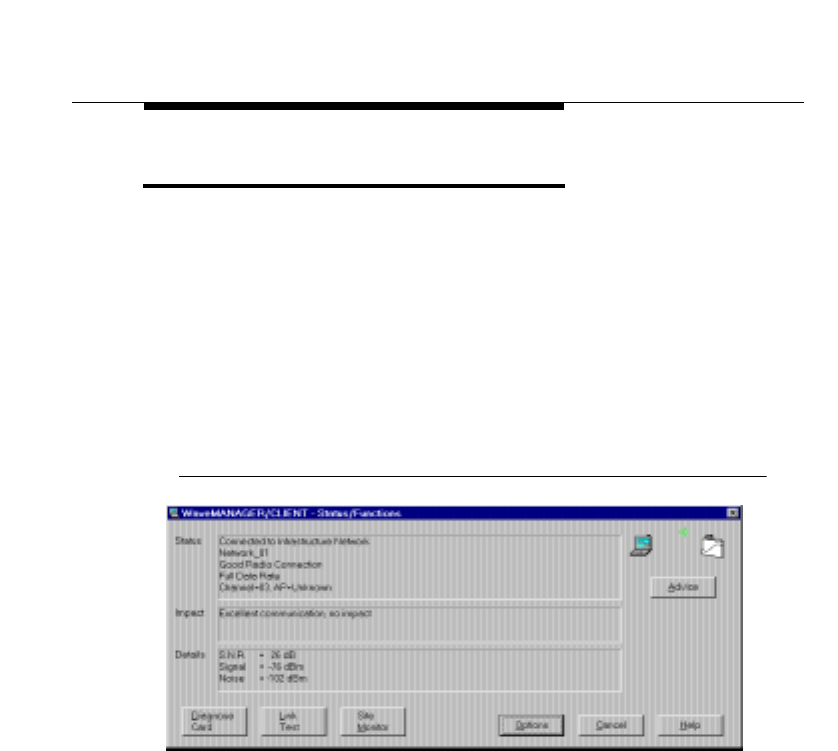
Monitoring WaveLAN Performance
WaveLAN Status/Function Window
WaveLAN IEEE 802.11 PC Card User’s Guide 5-7
WaveLAN Status/Function Window 5
The WaveMANAGER/CLIENT always opens with a general status
window, that informs about whether your WaveLAN card managed
to connect to an IEEE 802.11 network. This window will display:
■The name of the network to which you are currently
connected.
■The communications quality of the radio connection between
your station and the network.
■The Impact of the communications quality on your network
communication.
Figure 5-1 WaveMANAGER/CLIENT Status Window
Optionally you can use one of the available buttons to:
■Click the “Advice” button to troubleshoot unexpected results.
■Start the WaveLAN Link Test.
■Use the “Card Diagnostics” option when the Status window
indicates that the WaveLAN Card is not functioning properly.
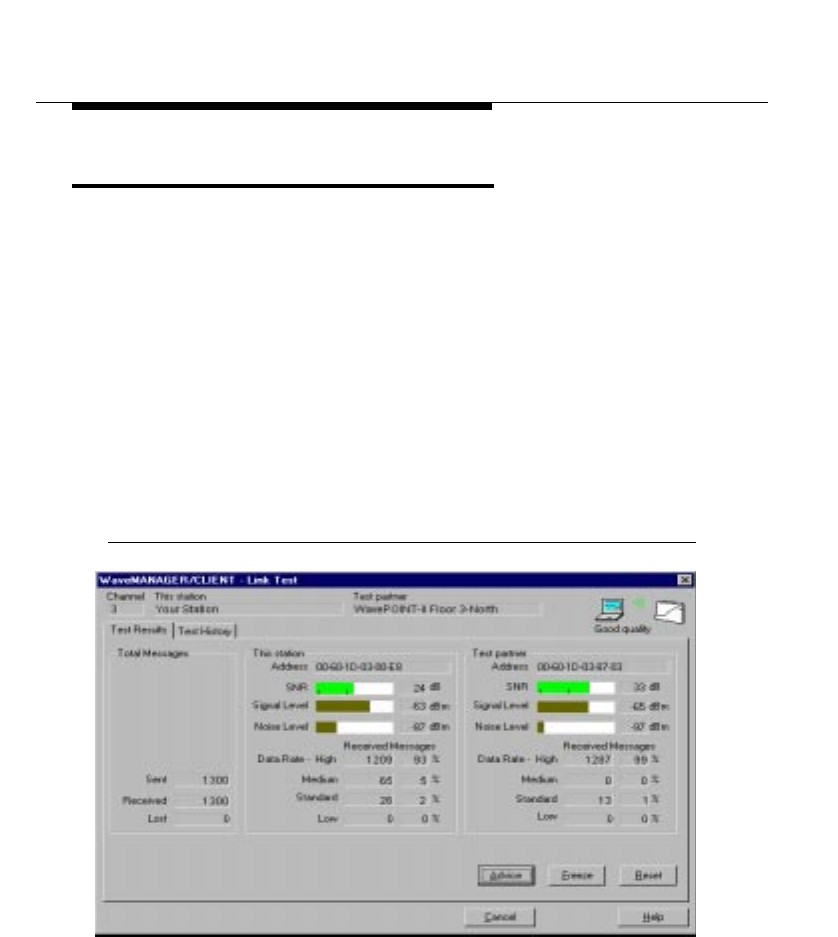
Monitoring WaveLAN Performance
WaveLAN Link Test
5-8 WaveLAN IEEE 802.11 PC Card User’s Guide
WaveLAN Link Test 5
You can use the Link Test to investigate the specific link between a
WaveLAN computer and its WavePOINT-II unit in your WaveLAN
Infrastructure environment (see Figure 1-3 on page 1-3).
The Link Test mode enables you to investigate:
■The Communications Quality of the radio connection
■The Data Throughput Efficiency of the radio connection.
When you run the Link Test mode while roaming throughout the
network environment, you will notice that the ‘Link Test Partner will
change according to the WavePOINT-II devices that service the
wireless areas that you pass.
Figure 5-2 WaveMANAGER Link Test

Monitoring WaveLAN Performance
WaveLAN Link Test
WaveLAN IEEE 802.11 PC Card User’s Guide 5-9
Testing Radio Communications Quality 5
The primary indicator to monitor is the communications quality of
the radio connection. This value is expressed in a Signal to Noise
Ratio (SNR). The SNR indicator will change color in the range
‘Green, Yellow and Red, according to communications quality
result as identified below:
When the SNR is rated as “Good” or “Adequate” the performance
of your WaveLAN station will be good as well.
When SNR is rated “Poor” you may need to consider one of the
options proposed by the WaveMANAGER/CLIENT tool.
To access WaveMANAGER/CLIENT tips for troubleshooting click
the “Advice” button. Advice may include:
■Optimizing antenna placement to increase the WaveLAN
Signal Level, or
■Eliminating sources of interference to decrease the Noise
Level that affects the Signal to Noise Ratio (SNR).
Use the indicators for Signal Level and Noise Level to determine
the cause of reduced performance. The panels for “Your Station”
and the “Link Test Partner” will help you to identify where you
should start “optimizing antenna placement” or “eliminating
interference”.
Color Description
■Green Communication quality is “Good”.
No intervention is required.
■Yellow Communications quality is “Adequate”.
No intervention is required.
■Red Communications quality is “Poor” and requires user-
intervention (see Appendix B ”Troubleshooting”)

Monitoring WaveLAN Performance
WaveLAN Link Test
5-10 WaveLAN IEEE 802.11 PC Card User’s Guide
Testing Data Throughput Efficiency 5
The secondary indicator for wireless performance is the Data
Throughput Efficiency of the radio connection. Data Throughput
Efficiency is measured in:
■“High, Medium, Standard & Low Data Rates”
■“Sent, Received & Lost Messages”
High, Medium, Standard & Low Data Rates 5
WaveLAN/IEEE PC Cards use an automatic Transmit Rate Select
mechanism to ensure reliable communications:
■When communicating with another wireless IEEE 802.11
compliant LAN device, both devices will automatically
synchronize their data rate to the highest compatible transmit
rate.
■As data communications at lower speeds may travel larger
distances that communications at high speed, the WaveLAN
adapters will automatically switch to a lower data rate when
one or both of the two link partners are moving away from one
another.
NOTE:
When running a network with multiple types of WaveLAN
PC Cards, all communications between the different types
of PC Cards will be at the Standard speed (see “About
Using Different Card Types” on page 1-7).
When running the WaveMANAGER/CLIENT Link Test, the
diagnostic tallies will inform you at which speed the both Link test
partners synchronized their data transmissions.

Monitoring WaveLAN Performance
WaveLAN Link Test
WaveLAN IEEE 802.11 PC Card User’s Guide 5-11
You can use these tallies to determine whether you might need to:
■Move wireless stations closer to the WavePOINT-II access
point (or together when operating in an Ad-hoc Wireless
Workgroup as pictured in Figure 1-2 on page 1-2).
■Verify the type of card installed at both Link Test Partners, for
example by displaying the information on the "Configuration
Info tab.
Sent, Received & Lost Messages 5
Messages Sent/Received/Lost, displayed on the left-bottom side
of the Link Test window.
When a data transmission fails, the WaveLAN card will
automatically retransmit the data. When the number of “Messages
Lost” is relatively high, this may indicate a problem that is either
related to:
■A poor Signal to Noise Ratio (SNR), or
■Frame collisions, due to a congestion of the medium.
When SNR is low and the number of “Messages Lost” is high, the
problem is most likely due to a poor Communications Quality, for
example because your station and the Link Test Partner are too far
apart, or because the connection suffers from a source of
interference (Noise) that affects the quality of your
communications.
However when SNR is rated “Good” or “Adequate” but you still
witness a relatively large number of lost messages, this might
indicate:
■A very busy network, where many stations try to access the
WaveLAN medium at the same time.
■A microwave oven in the signal path is causing short bursts of
interference. This noise might not be displayed by the Noise
Level indicator, but still be forcing the WaveLAN stations to
retransmit frames over and over again.

Monitoring WaveLAN Performance
WaveLAN Link Test
5-12 WaveLAN IEEE 802.11 PC Card User’s Guide
■Another station is suffering from a “Poor” communications
quality, and consequently sending many retransmissions
■Numerous frame collisions occur due to a “hidden station”
problem.
You are advised to run the WaveMANAGER/CLIENT Link Test
from multiple stations to determine whether:
■This problem is a local problem, i.e. for one station only, or
■This problem is experienced by all stations.
When all stations suffer from poor Data Throughput Efficiency,
despite a “Good” SNR value, investigate what is causing the heavy
traffic load.
Link Test Options 5
To investigate Link Test results in more detail, you can use one of
the following options:
■Freeze the display by clicking the “Freeze” button.
■Display Radio Communications Quality in a line-chart graphic,
by selecting the Link Test History window.
■Log measurement results to a disk file (see “Advanced User
Options” on page 5-14).

Monitoring WaveLAN Performance
WaveLAN Card Diagnostics
WaveLAN IEEE 802.11 PC Card User’s Guide 5-13
WaveLAN Card Diagnostics 5
The Card Diagnostics enables you to:
■Run a Card Test.
■Display a set of communication statistics.
■Display the configuration settings of your card
(Enhanced Mode only, see Advanced User Options).
You will need to run the Card Test only in situations where the
Status window (as pictured in Figure 5-1 on page 5-7) reports a
card failure, or when you suspect a configuration mismatch.
!CAUTION:
Running the Card Test may temporarily disrupt the
communication of your computer with the network. In
exceptional cases you may lose your network connection.
When this is the case, restart the computer to restore your
network connection.
When contacting WaveLAN Technical Support, the Card Test
results may help the support representative determine the cause of
a malfunctioning device.

Monitoring WaveLAN Performance
Advanced User Options
5-14 WaveLAN IEEE 802.11 PC Card User’s Guide
Advanced User Options 5
Basic Mode versus Enhanced Mode 5
The default configuration of your WaveMANAGER/CLIENT
program will provide all the diagnostic information that you would
need to perform standard diagnostic routines:
■Verify if the card is functioning properly.
■Verify if your WaveLAN station is within range of the IEEE
802.11 network.
■Determine or optimize placement of WavePOINT-II access
points.
This configuration setting also enables you to perform basic
troubleshooting routines such as
■Optimizing antenna placement.
■Detecting the occurrence of in-band interference (noise).
When you are an experienced user of WaveLAN IEEE 802.11
products, you may be interested in using the ‘”Enhance Mode” of
WaveMANAGER/CLIENT IEEE.
The “Enhanced Mode” option is typically used by skilled LAN
Administrators or Network Installation Technicians in situations
where you are troubleshooting a problem related to WaveLAN
networking. This mode will enable you to:
■Display the Configuration Settings of your WaveMANAGER/
CLIENT station and the WavePOINT-II access point.
■Display the tallies of standard communication statistics, such
as Unicast/Multicast Frames, Fragments or the number of
deferred Transmissions or Communication Errors.
■Display the Communication Protocol settings.
■Save measurement data to a log file as described in “Logging
Measurement Data” on page 5-15.

Monitoring WaveLAN Performance
Advanced User Options
WaveLAN IEEE 802.11 PC Card User’s Guide 5-15
Enabling/Disabling Enhanced Mode 5
1. Start the WaveMANAGER/CLIENT program.
2. Open the Status/Functions window (pictured in Figure 5-1 on
page 5-7)
3. Click the “Options” button.
4. Select or clear the “Enhanced Mode” check box.
5. Click OK to confirm and return to the WaveMANAGER/
CLIENT program.
NOTE:
Optionally, you can also place a check-mark in the “Skip
Initial Screen” box, when you would like to open the
WaveMANAGER/CLIENT IEEE program directly to the
“Status/Function” screen.
Logging Measurement Data 5
The WaveMANAGER/CLIENT enables you to save measurement
results of your Link Test session to a log file. You can use this log
file for example to:
■Evaluate the results at a later stage.
■Compare the results with previous measurements.
■Send the measurement results to your WaveLAN Support
representative when troubleshooting a specific problem.
Comparison of measurement data with previous measurements
may help you investigate the performance of your wireless LAN
over a period of time, for example to analyze the consequences of
relocated network equipment.
WaveMANAGER/CLIENT log files are saved in Comma Separated
Value (CSV) file format. You can read these files with any ASCII
editor, or import the data into any standard spreadsheet or
database application.

Monitoring WaveLAN Performance
Advanced User Options
5-16 WaveLAN IEEE 802.11 PC Card User’s Guide
Logging Options 5
To enable logging option, you must set the WaveMANAGER/
CLIENT to “Enhanced Mode” as described in “Enabling/Disabling
Enhanced Mode” on page 5-15.
Once the WaveMANAGER/CLIENT runs in Enhanced Mode, you
can set the log option to store measurement data manually, or
automatically at regular intervals.
■Use “manual” when you would like to save measurement data
at specific locations and moments, e.g. when you are
investigating a particular source of interference.
■Use ‘”automatic” when you would like to collect measurement
data on network performance over a longer period of time.
This may be useful if you wish to analyze recurring events or
variation in values.
Automatic logging is typically used when the WaveMANAGER/
CLIENT station is running a Link Test at a particular location.
Setting the Logging Options 5
To set the logging options, click the “Log Settings” tab in Link Test
window. In both modes, the measurement data will be saved in the
file entered in the “Path and file name” field. Each time new data is
saved, this information is added to the existing file. If you wish to
save the data in a new file, use this field to enter a new file name.
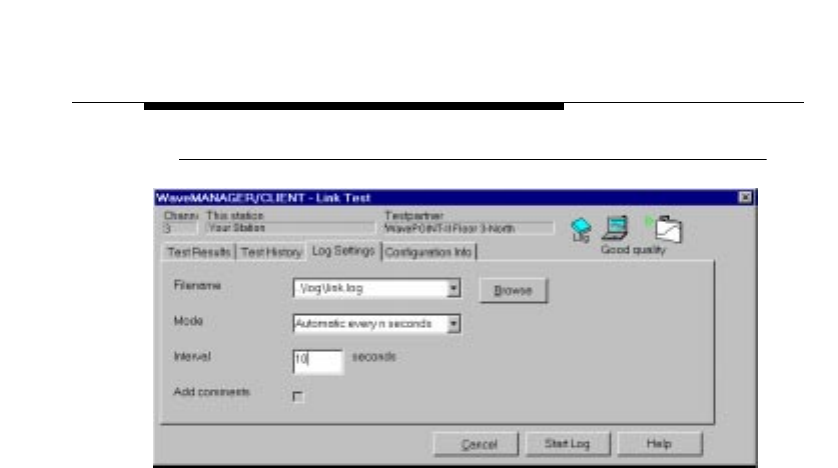
Monitoring WaveLAN Performance
Advanced User Options
WaveLAN IEEE 802.11 PC Card User’s Guide 5-17
Figure 5-3 Logging Setup Dialog Box
Start or Stop Logging 5
When you have set the Logging Options, the WaveMANAGER/
CLIENT will create a button on the lower-right side of the
diagnostic window.
Depending on your choice of logging option, this button will read:
■“Log Once” for the manual log option, or
■“Start” for the automatic log option.
If you selected the manual option, click the “Log Once” button each
time you wish to save measurement data.
For the automatic option, click the “Start” button. Click this button
again to stop the logging function.
To change the logging option, proceed as described in “Setting the
Logging Options” on page 5-16.

Monitoring WaveLAN Performance
Advanced User Options
5-18 WaveLAN IEEE 802.11 PC Card User’s Guide


WaveLAN IEEE 802.11 PC Card User’s Guide 6-1
6
WaveLAN Security Options
Introduction 6
Wireless network systems that comply to the IEEE 802.11
standard for wireless LANs, allow computing devices to attempt to
establish a wireless (radio) connection to the network, as easy as
possible.
Such a wireless connection however, only refers to a “physical”
connection to the LAN, similar to a cable that is pulled between an
Ethernet station and a hub, or patch panel.
The “physical” connection will not provide access to networking
data or services, which would typically require a station to:
■Have the appropriate network operating system software
installed.
■Log on to the network, using a login name and password.
Besides standard security measures as supported by most of
today’s network operating systems, the WaveLAN IEEE 802.11
system allows you to implement a number of additional security
options, that can help to prevent unauthorized access to your
network, and network data.

WaveLAN Security Options
Introduction
6-2 WaveLAN IEEE 802.11 PC Card User’s Guide
Examples of such additional WaveLAN security measures are:
■“Closing the Infrastructure” described on page 6-2.
■“Wireless Access Control” described on page 6-3.
■“Wireless Data Encryption” described on page 6-4.
For more detailed information on operating system security
measures, please refer to the documentation that came with the
network operating system, or consult the reseller of your LAN
software.l
Closing the Infrastructure 6
The IEEE 802.11 standard on wireless LANs was designed to
allow mobile computing devices to establish a (radio) connection to
a Local Area Network (LAN) as easy as possible.
This means that mobile users that do not know the correct
WaveLAN Network Name can use the value “ANY”, or use an
empty string for the network name to establish a radio connection
with the nearest access point.
Although such a physical connection does not provide access to
network data without the appropriate username and password, in
some occasions, you may wish to restrict access to the network
resources in a more stringent way.
Lucent Technologies WavePOINT-II access points, allow you to
“close” the wireless infrastructure via a special setting of the
access point(s). Doing so, the WavePOINT-II devices will:
■Ignore radio association request from users that have
configured their WaveLAN IEEE device to use the value “ANY”
■Ignore radio association request from users that use a non-
Lucent WaveLAN adapter.

WaveLAN Security Options
Introduction
WaveLAN IEEE 802.11 PC Card User’s Guide 6-3
This means that the WavePOINT-II will only allow WaveLAN IEEE
stations that have been configured with the correct WaveLAN
Network Name to establish a radio connection.
NOTE:
The “Closed” option is not fully compliant with the IEEE
802.11 Standard for Wireless LANs.
For more information please consult the WaveMANAGER IEEE
User’s Guide that was shipped with your WavePOINT-II access
point(s), or download the latest copy from the WaveLAN website.
Wireless Access Control 6
When your IEEE 802.11 compliant
infrastructure includes WavePOINT-
II access points, you are advised to
use the WaveLAN “Access Control”
feature of your WavePOINT-II
access points to restrict wireless
access to the network to authorized
stations only.
Authorized stations are listed by the
MAC Address of their WaveLAN
card in an Access Control Table.
The MAC Address of your WaveLAN
Card is printed on a label on the
backside of your WaveLAN PC
Card.
To enable the Access Control feature, the LAN Administrator must:
1. Determine which WaveLAN cards will be authorized to
communicate with the WavePOINT-II access points.

WaveLAN Security Options
Introduction
6-4 WaveLAN IEEE 802.11 PC Card User’s Guide
2. Enter the MAC Address of these cards into an Access Control
Table file.
3. Load the Access Control Table file into all WavePOINT-II
access points that belong to the network infrastructure.
With the Access Control file loaded, the WavePOINT-II access
points will:
■Only forward wireless data to/from “Authorized Stations” that
are identified in the Access Control table file, and
■Ignore all request to forward data from/to stations that use a
WaveLAN card of which the MAC Address is not listed in the
Access Control table file.
Consult your LAN Administrator to verify whether your network
infrastructure uses the WavePOINT-II Access Control feature. If
this is the case, the LAN Administrator should add the MAC
Address of your card to the Access Control Table.
The MAC Address of your WaveLAN card is printed on a label on
the back-side of your WaveLAN card.
Wireless Data Encryption 6
If you would like to add an extra security layer to your wireless
communication, you can optionally install a WaveLAN IEEE 802.11
system that supports wireless data encryption.
Two types of WaveLAN PC Cards allow you to build such a
system:
■WaveLAN/IEEE Silver Label Cards (described on page 1-6).
■WaveLAN/IEEE Gold Label Cards (described on page 1-7).
To install such a system, all devices in your wireless network, must
be equipped with WaveLAN/IEEE PC Cards that support
encryption.

WaveLAN Security Options
Introduction
WaveLAN IEEE 802.11 PC Card User’s Guide 6-5
■Silver cards support the IEEE compliant "Wired Equivalent
Privacy (WEP) data encryption, based upon the 64 bit RC4
encryption algorithm.
■Gold cards support an enhanced type of data encryption,
based upon the 128 bit RC4 algorithm.
When enabling encryption, the WaveLAN interface of your wireless
stations and/or WavePOINT-II Access Points, will encrypt all data
that will be transmitted via the wireless intrerface.
■The encryption feature allows you to define up to four
encryption keys to decypher messages received via the
wireless interface.
■You can select one of these four keys to encrypt the wireless
data tranmissions.
If you plan to use data encryption within your network, all stations
and access points must be:
■Equipped with a WaveLAN PC Card that supports encryption.
■Configured with a matchinng set of encryption keys.
The option to specify up to four decryption keys allows you to
refresh the key values at regular intervals (for example starting
at the access points) without the necessity to update all station
at the same time.
For information about setting encryption key parameters, please
consult the section “WaveLAN Encryption Parameters” on page
3-18 as described in Chapter 3.
NOTE:
Early models of the WaveLAN/IEEE Silver PC Cards,
(typically shipped prior to July 1999), may need an update
of the card firmware to v4.08 or higher, to enable the
encryption feature. This update for Silver Cards, is
managed via a dedicated "
WaveLAN Station
Update
" tool
(WSU version 4.08 or higher) that can be downloaded
from the WaveLAN website.


Contents
A
Card Specifications
Physical Specifications A-1
Networking Characteristics A-2
Radio Characteristics A-3
Supported Frequency Sub-bands A-7
WaveLAN PC Card Types A-9
About Previously Purchased Cards A-9
■Standard IEEE 802.11 PC Cards 1-9
■About the IEEE 802.11 Turbo Card 1-11
■About the Fixed wireless PC Card 1-11
Can I Upgrade WaveLAN Cards? 1-12


WaveLAN/IEEE Turbo 11 Mb PC Card A-1
A
Card Specifications
Physical Specifications A
Table A-1 Physical Specifications
Table A-2 Power Characteristics
Form Factor PC Card Type-II Extended
Color1
1 Color of the extended antenna is related to the Radio Characteristics
described on page A-3
■Black for WaveLAN/IEEE Turbo 11 Mb PC Cards
(both Gold and Silver Label)
■Red for IEEE Fixed Wireless PC Cards
Dimensions (LxWxH) 117.8 x 53.95 x 8.7 mm
Weight 45 gram (PC Card)
Temperature & Humidity
Operation 0° to 55° C2
2Although the card may still operate in the range of -20° to 70° C, operation
outside the range of 0° to 55° C may no longer be according to specifications.
maximum humidity 95%
Transit -20° to 70° C 15 to 95% (no condensation allowed)
Storage -10° to 60° C 10 to 90% (no condensation allowed)
Doze Mode 10 mA
Receive Mode 180 mA
Transmit Mode 280 mA
Power Supply 5 V

Card Specifications
Networking Characteristics
A-2 WaveLAN/IEEE Turbo 11 Mb PC Card
Networking Characteristics A
Table A-3 Networking Characteristics
Compatibility IEEE 802.11 Standard for Wireless LANS (DSSS)
Network Operating
System
■Novell® Client 3.x & 4.x
■Microsoft Windows® Networking
Host Operating
System Microsoft Windows® 95/98 and Windows® NT:
■NDIS Miniport Driver
MS-DOS & Microsoft Windows 3.x:
■DOS ODI Driver
■Packet Driver
Windows CE
■Windows CE v.2.0 & 2.11
Apple Macintosh Operating Systems:
■Apple PowerBook G3
Media Access
Protocol CSMA/CA (Collision Avoidance) with
Acknowledgment (ACK)
Data Rate ■High 11 Mb/s
■Medium 5.5 Mb/s
■Standard 2 Mb/s
■Low 1 Mb/s
The cards use an automatic Transmit Rate Select
mechanism. Optionally the user can choose the
fix the transmit rate at a specific speed.

Card Specifications
Radio Characteristics
WaveLAN/IEEE Turbo 11 Mb PC Card A-3
Radio Characteristics A
Radio Characteristics of WaveLAN adapter cards may vary
according to:
■The country where the product was purchased.
■The type of product that was purchased.
Wireless communication is often subject to local radio regulations.
Although WaveLAN wireless networking products have been
designed for operation in the license-free 2.4 GHz band, local
radio regulations may impose a number of limitations to the use of
wireless communication equipment.
To comply with such regulations, WaveLAN IEEE 802.11 cards are
marketed with dedicated channel-sets with a number of factory-
programmed channels identified by the following acronyms:
■ETS for countries that adhere to the regulations as defined by
the European Telecommunications Standards Institute (ETSI).
■FCC for countries that adhere to the regulations as defined by
the US Federal Communications Commission (FCC).
■FR for France, and
■JP for Japan.
The acronym of the channel-set supported by your card is printed
on a label on the back-side of your WaveLAN IEEE 802.11 card
(see Table A-6 on page A-8 for a detailed list of channels).
If you plan to install and use WaveLAN adapter cards to connect a
WavePOINT-II or other computing device to an outdoor antenna
installation, additional regulations may apply.

Card Specifications
Radio Characteristics
A-4 WaveLAN/IEEE Turbo 11 Mb PC Card
To comply with such regulations Lucent Technologies offers two
types of WaveLAN adapter cards:
■In countries that adhere to the FCC regulations, you can use
the standard black-colored WaveLAN IEEE 802.11 card.
■In countries that adhere to the ETSI regulations, including
France and Japan, you must select the card-type based upon
the antenna that will be used:
■You can use the black-colored WaveLAN IEEE 802.11
card when connecting the device to standard Lucent omni-
directional antennas.
■You
must
use the red-colored IEEE Fixed Wireless PC
Card when connecting the device to the standard Lucent
14 dBi directional antenna for outdoor use.
When you ordered a WaveACCESS LINK WP-II kit1 for outdoor
antenna installations, your kit includes the correct card type that
complies with the regulations that apply in your country.
!WARNING:
At all times, it will be the responsibility of the end-user to
ensure that an outdoor antenna installation complies with
local radio regulations. The end-user must verify that:
■
The antenna installer is aware of these regulations.
■
The correct type of WaveLAN card is used to connect
the host device to the outdoor antenna installation.
Lucent Technologies and its resellers or distributors are
not liable for any damage or violation of government
regulations that may arise from failing to comply with these
guidelines.
1 Formerly identified as the WaveLAN IEEE PTP Kit

Card Specifications
Radio Characteristics
A-5 WaveLAN/IEEE Turbo 11 Mb PC Card
Table A-4 Radio Characteristics
R-F Frequency Band 2.4 GHz (2400-2500 MHz)
Number of selectable
sub-channels North America (FCC) 11
Europe (ETS) 13
France (FR) 4
Japan (JP) 1
Other Countries: ■FCC 11
■ETS 13
Modulation Technique Direct Sequence Spread Spectrum
■CCK for High & Medium Transmit Rate
■DQPSK for Standard Transmit Rate
■DBPSK for Low Transmit Rate
Spreading 11-chip Barker Sequence
Bit Error Rate (BER) Better than 10-5
Nominal Output Power 15 dBm
Range (100 bytes User Data) /
Transmit Rate High Speed
11 Mb/s Medium Speed
5.5 Mb/s Standard Speed
2 Mb/s Low Speed
1 Mb/s
Open Office Environment 160 m (525 ft.) 270 m (885 ft.) 400 m (1300 ft.) 550 m (1750 ft.)
Semi-Open Office Environment 50 m (165 ft.) 70 m (230 ft.) 90 m (300 ft.) 115 m (375 ft.)
Closed Office 25 m (80 ft.) 35 m (115 ft.) 40 m (130 ft.) 50 m (165 ft.)
Receiver Sensitivity -83 dBm -87 dBm -91 dBm -94 dBm
Delay Spread (at FER of <1%) 65 ns 225 ns 400 ns 500 ns

Card Specifications
Radio Characteristics
A-6 WaveLAN/IEEE Turbo 11 Mb PC Card
The range of the wireless signal is related to the Transmit Rate of
the wireless communication. Communications at lower Transmit
range may travel larger distances.
NOTE:
The range values listed in Table A-4 on page A-5 are
typical distances as measured at the Lucent Technologies
WaveLAN laboratories. These values may provide a rule
of thumb and may vary according to the actual radio
conditions at the location where the WaveLAN product will
be installed.
■The range of your wireless devices can be affected
when the antennas are placed near metal surfaces
and solid high-density materials.
■Range is also impacted due to “obstacles” in the signal
path of the radio that may either absorb or reflect the
radio signal.
Table A-4 lists the typical ranges when used indoors in “office
environments” that can be described as follows:
■In Open Office environments, antennas can “see” each
other, i.e. there are no physical obstructions between them.
■In Semi-open Office environments, work space is divided by
shoulder-height, hollow wall elements; antennas are at
desktop level.
■In Closed Office environments, work space is separated by
floor-to-ceiling brick walls.
If you intend using the WaveLAN PC Card as part of an outdoor
antenna installation, the range of the outdoor antenna installations
will be related to:
■Type of outdoor antennas connected to the WaveLAN card.
■Length of antenna cables.
■Clearance of the radio signal path.

Card Specifications
Radio Characteristics
WaveLAN/IEEE Turbo 11 Mb PC Card A-7
For more information please consult the “WaveLAN IEEE Outdoor
Antenna Installation Guide”
Table A-5 WaveLAN Fixed Wireless PC Card
Supported Frequency Sub-bands A
Subject to the radio regulations that apply in your country, your
WaveLAN card may support a different set of 2.4 GHz channels
(see Table A-6). Consult your Authorized WaveLAN Reseller or
Lucent Technologies Sales office for information about the radio
regulations that apply in your country.
R-F Frequency Band 2.4 GHz (2400-2500 MHz)
Number of selectable
sub-channels: Europe (ETS) 13
France (FR) 4
Japan (JP) 1
Other Countries (ETS)1
1 The Fixed Wireless PC Card is not available in FCC regulated countries.
13
Modulation Technique: Direct Sequence Spread Spectrum
■CCK for High & Medium Transmit Rate
■DQPSK for Standard Transmit Rate
■DBPSK for Low Transmit Rate
Spreading 11-chip Barker Sequence
Bit Error Rate (BER) Better than 10-5
Nominal Output Power: 8 dBm
Range Consult the “WaveLAN IEEE Outdoor
Antenna Installation Guide”2
2 This card is designed for outdoor antenna installations in countries that
adhere to radio regulations as defined by the ETSI.

Card Specifications
Radio Characteristics
A-8 WaveLAN/IEEE Turbo 11 Mb PC Card
Table A-6 WaveLAN IEEE 802.11 Channels Sets
When installing WaveLAN adapter cards the channel configuration
is managed as follows:
■For wireless clients that operate in a WaveLAN IEEE 802.11
Infrastructure, the WaveLAN card will automatically start
operation at the channel identified the WavePOINT-II access
points. When roaming between different access points the
station can dynamically switch to another channel if required.
■For WaveLAN cards installed into wireless clients that operate
in a “Ad-hoc Demo Mode”, the WaveLAN card will use the
factory-set default channel (printed in bold).
■When inserted into a WavePOINT-II access point, the
WaveLAN card will use the factory-set default channel (printed
in bold), unless the LAN Administrator selected a different
channel when configuring the WavePOINT-II device.
Frequency Range 2400-2500 MHz
Channel ID FCC ETSI France Japan
12412 2412 - -
22417 2417 - -
3 2422 2422 --
42427 2427 - -
52432 2432 - -
62437 2437 - -
72442 2442 - -
82447 2447 - -
92452 2452 - -
10 2457 2457 2457 -
11 2462 2462 2462 -
12 - 2467 2467 -
13 - 2472 2472 -
14 ---2484

Contents
B
Troubleshooting
LED Activity B-1
Windows Operating Systems B-4
Generic Problems B-4
■Windows does not detect my new card B-4
■Enabling the PC Card Controller 2-4
■Station Cannot Connect to the Network B-5
Hardware Conflict B-6
■Running Windows NT Diagnostics B-7
■Despite NT Diagnostics, still facing problems B-11
■PC Card Conflict B-12
Upgrading the WaveLAN Miniport Driver B-14
■Upgrading the driver for Windows 98 B-15
■Upgrading the driver for Windows NT B-17
■Upgrading the driver for Windows 95 B-18
Removing the WaveLAN Miniport Driver B-20
■Deleting the WaveLAN Driver Files B-21
MS-DOS Systems B-23
Error Messages B-23
■No PACKET.INI found B-23
Can Not Connect To The Network B-23


WaveLAN/IEEE Turbo 11 Mb PC Card B-1
B
Troubleshooting
LED Activity B
If you encounter difficulty using and/or installing your WaveLAN
product, the error may be related to various causes:
■Out-of range situation, which prevents the WaveLAN PC Card
from establishing a wireless connection with the network.
■Configuration mismatch, which prevents the WaveLAN PC
Card from establishing a wireless connection with the (correct)
network.
■Absence of, or conflict of the WaveLAN Driver.
■A problem or conflict with the PC Card slot which prevents the
PC Card from powering on.
■A conflict of the WaveLAN hardware with another device.
The starting point to troubleshoot problems with your WaveLAN
card is looking at the LED activity of the WaveLAN PC Card.
Table B-1 on page B-2 provides an overview of the various modes
of operation and the associated LED activity. Table B-1 also
includes a number of troubleshooting hints, if required, that may
help you solve the problem.

Troubleshooting
LED Activity
B-2 WaveLAN/IEEE Turbo 11 Mb PC Card
Table B-1 LED Activity Table
Power LED Transmit
Receive LED Description/Action
Continuous
Green
Blinking Standard operational mode.
■Card is powered on.
■Sensing/transmitting wireless data.
Off ■Card is powered on.
■No wireless activity.
No action is required.
Flicker Flicker
Power Management mode:
■Card is powered on, but set to power
saving mode, to conserve battery life.
■Flashes indicates that the card wakes up
at regular intervals to verify if there is
wireless data addressed to your computer.
Both LEDs blink once
every 10 seconds
WaveLAN card works fine, but did not yet
succeed establishing a wireless connection
with the wireless Infrastructure.
Actions:
■Contact the LAN Administrator to verify the
WaveLAN Network Name assigned to the
wireless infrastructure.
■Contact the LAN Administrator to verify the
correct value(s) of the encryption keys.
■Contact the LAN Administrator to verify
whether the network infrastructure has
been closed (see page 6-2).
■Change the configuration of your
WaveLAN PC Card to enter the correct
WaveLAN Network Name
■If there are no WavePOINT-II devices
available, change the configuration of your
WaveLAN PC Card to run in “Ad-hoc
Demo mode.

Troubleshooting
LED Activity
WaveLAN/IEEE Turbo 11 Mb PC Card B-3
Off Off Card is not powered on, so it can not
transmit/receive data.
The cause may either be:
■No Driver loaded/installed
■Card - Driver mismatch which prevented
the driver from loading
■Device conflict which prevented the driver
from loading
Actions:
■Verify if a driver has been installed, if not
install the driver.
■Verify the device settings of the PC Card
to determine the occurrence of a conflict
with another device. If so, change the
settings of either your WaveLAN or the
conflicting device to resolve the problem.
■Verify the versions of the driver, and the
embedded software in the WaveLAN card
(also referred to as Station firmware).
■Consult the WaveLAN website to see if
newer versions are available and if so,
upgrade both the embedded software and
driver to the latest available version.
Table B-1 LED Activity Table—Continued
Power LED Transmit
Receive LED Description/Action

Troubleshooting
Windows Operating Systems
B-4 WaveLAN/IEEE Turbo 11 Mb PC Card
Windows Operating Systems B
Generic Problems B
Windows does not detect my new card B
■Windows NT operating systems v3.51 and v4.0 do not support
“Plug & Play”. On such systems, you will need to manually
introduce the card to your operating system as described in
Chapter 3 under “Getting Started in Windows NT” on page 3-5
.
■In some occasions, Windows 95 and/or Windows 98 do not
detect a new card either. This may be the case in one of the
following situations:
■The laptop computer into which you wish to install the
WaveLAN card is a brand-new “out-of-the-box” computer,
where the Windows 95/98 operating system was already
factory-installed (see “Enabling the PC Card Controller” on
page B-4).
■A previous installation of the WaveLAN adapter card was
aborted before it was finished.
Enabling the PC Card Controller 2
Today, most brand-new “out-of-the-box” laptop computers come
with the Windows 95/98 operating system factory-installed. On
some of these computers, a number of options like PC Card &
Socket Services have been disabled by default to save on disk and
memory space. In order to use such options you must first finalize
the Windows 95/98 installation in order to enable such options.
If a Windows 95/98 computer does not detect your WaveLAN PC
Card, proceed as described below, to enable the PC Card socket
interface, or to verify that it has been enabled, proceed as follows:

Troubleshooting
Windows Operating Systems
WaveLAN/IEEE Turbo 11 Mb PC Card B-5
1. Click the button on the Windows Taskbar.
2. Click on Settings, then Control Panel.
3. In the Control Panel window, double-click the “PC Card icon”
to open the PC Card Properties window (see Figure B-1).
Figure B-1 Enabling the PC Card Controller
4. In the PC Card Properties window, double-click one of the PC
Card Sockets.
If the PC Card socket interface was not yet enabled, the
Windows operating system will display a message that it is
finalizing the PC Card Socket installation.
5. Click the button to confirm and close the PC Card
Properties window.
Station Cannot Connect to the Network B
This situation may occur in any of the following situations:
■Incorrect WaveLAN Network Name
■No driver loaded

Troubleshooting
Windows Operating Systems
B-6 WaveLAN/IEEE Turbo 11 Mb PC Card
■“Closed” System (see “Closing the Infrastructure” on page
6-2).
■Station not authorized to access network (see “Wireless
Access Control” on page 6-3).
■Card defect
■“Hardware Conflict” on page B-6
Hardware Conflict B
When installing adapter cards or peripheral devices on a computer
you may occasionally run into hardware conflict that may:
■prevent your WaveLAN card from working properly, or
■disturb operation of other devices after the installation of the
WaveLAN drivers.
Such problems are most of the times caused when multiple
devices installed onto your computer are using identical values for
I/O Base Address and/or Interrupt Request (IRQ).
The factory-set values of your WaveLAN cardhave been set to use
the following defaults:
Table B-2 Default Strappings of the WaveLAN Hardware
Device Resource Default Value
WaveLAN IEEE 802.11 PC Card1
1 For older driver versions the default I/O Base Address value is 0300
I/O Port 0400-0437
IRQ 10

Troubleshooting
Windows Operating Systems
WaveLAN/IEEE Turbo 11 Mb PC Card B-7
Unlike the Windows 95 or Windows 98 operating systems,
Windows NT is not able to check automatically whether the
proposed values are already used by another device.
To avoid or troubleshoot hardware conflicts with another device,
you are advised to use the Windows NT Diagnostic program, to
determine whether the default I/O port and IRQ for your WaveLAN
card are available, and if not to select an alternative value.
NOTE:
Sometimes it may be pretty difficult to determine where a
device conflict is locared. As a rule of thumb, you can use
the following troubleshooting hint:
■When the conflict is related to an conflcitng I/O Base
setting, in most cases the WaveLAN card will not work
at all: i.e. you will not see any LED activity.
■If the problem is related to a conflicting IRQ value,
LEDs may flicker, but you can notconnect to the
network.
In a number of cases you may be able to verify that
the card succeeded in establishing a radio connection
with a WavePOINT-II device, but fails to really
connecting to the network operating system.
Running Windows NT Diagnostics B
When installing the WaveLAN card, the Windows NT operating
system will prompt you to confirm or modify the factory-set device
values for your WaveLAN card:
Starting Windows NT Diagnostics B
1. Click the button on the Windows NT Taskbar.
2. Click on Programs, and then “Administrative Tools”.

Troubleshooting
Windows Operating Systems
B-8 WaveLAN/IEEE Turbo 11 Mb PC Card
3. From the list of “Administrative Tools”, click the item “Windows
NT Diagnostics”.
Verifying IRQ Settings B
To display the IRQ values that are already in use by other devices
installed on your computer:
1. Click the “Resources” tab on the Windows NT Diagnostics
screen. This will display the screen pictured in Figure B-2.
Figure B-2 Verifying IRQ Availability
2. Click the “IRQ” button to display the Interrupt Request (IRQ)
vectors currently in use by other devices in your computer.
The default IRQ value for WaveLAN IEEE 802.11 PC Cards is
10. Is the value 10 already listed?
■If No, you can use the WaveLAN default. Write down IRQ
10 and proceed with the next step.

Troubleshooting
Windows Operating Systems
WaveLAN/IEEE Turbo 11 Mb PC Card B-9
■If Yes, this means that another device is already using the
IRQ, i.e. you will need to select another value for your
WaveLAN IEEE 802.11 PC Card.
3. See whether one of the following values is available (i.e. not
listed in the Windows NT Diagnostics window):
03, 04, 05, 07, 09, 10, 11, 12, 15.
4. Select one non-listed value and write it down before you
proceed with “Verifying I/O Port Settings”.
Verifying I/O Port Settings B
To display the values of I/O Ports that are already in use by other
devices installed on your computer, proceed as follows:
1. On the “Resources” screen of the Windows NT Diagnostics
program, click the button “I/O Port”. This will display the
window pictured in Figure B-3.
The default I/O Port value for WaveLAN IEEE 802.11 PC
Cards is 04001.
Is this appropriate value already listed for your version of the
Miniport driver?
■If No, you can use the WaveLAN default. Write down
I/O Port 0400 and proceed with the next step.
■If Yes, this means that another device is already using
this port address, i.e. you will need to select another
value for your WaveLAN IEEE 802.11 PC Card.
1 This applies to WaveLAN/IEEE Miniport driver version 1.33 and higher.
For earlier versions of this driver, the default I/O Base Address is 0300.
If you are unsure about the version of the Miniport driver that is currently
installed, use the WaveMANAGER/CLIENT IEEE tool. Use the option
“Diagnose Card” to display the “Version Info” tab which will list the version
numbers of the card’s hardware, embedded software and driver.
For the latest WaveLAN Miniport driver, consult the WaveLAN website at:
http://www.wavelan.com.
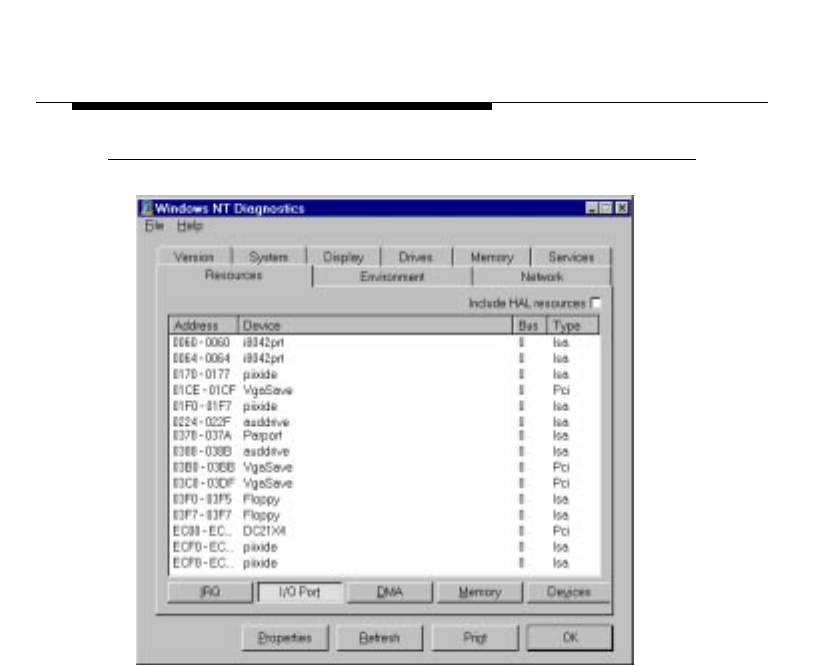
Troubleshooting
Windows Operating Systems
B-10 WaveLAN/IEEE Turbo 11 Mb PC Card
Figure B-3 Verifying I/O Port Availability
If the default WaveLAN I/O Port has already been assigned to
another device, select an alternative I/O Port value from the
range listed below:
* For driver versions 1.32 or earlier, the default was 0300.
** For version 1.33 or higher, the default setting is 0400.
2. Verify that the alternative value is available (i.e. not listed in the
Windows NT Diagnostics window).
0200 0300* 0400** 0500 0600 0700
- - 0440 0540 0640 0740
0280 0380 0480 0580 0680 0780
- - 04C0 05C0 06C0 07C0

Troubleshooting
Windows Operating Systems
WaveLAN/IEEE Turbo 11 Mb PC Card B-11
3. Write down the alternative I/O Port value and close the
Windows NT Diagnostics Program.
Having finished these steps, you should now have a note that
identifies the following (alternative) values:
■IRQ value
■I/O Port Address
You can use these values to install the WaveLAN Miniport
Driver as described later in this chapter.
Despite NT Diagnostics, still facing problemsB
The Windows NT Diagnostics program is not “bullet-proof”.
Occasionally you may run into a hardware conflicts despite the fact
that the Windows NT Diagnostics program displayed resources as
being available to your WaveLAN card.
This may be the case when your computer has one or more
devices and/or peripherals installed which claimed an I/O Base
Address and/or IRQ value without notifying the Windows NT
operating system: Your Windows NT Diagnostics program will not
be able to display these values, simply because it “doesn’t know”.
If this is the case, a value you perceived as being available to your
WaveLAN card, had already claimed by a conflicting device
resulting in:
■A WaveLAN card that does not work, and/or
■A conflicting device that does not work properly.
It will depend on your preferences and the configuration options
supported by each of the conflicting devices to determine which
device settings should be changed to allow flawless operation.
In most situations the WaveLAN Miniport driver will prove most
flexible to select alternative settings for I/O Base Address or IRQ

Troubleshooting
Windows Operating Systems
B-12 WaveLAN/IEEE Turbo 11 Mb PC Card
values. However since the conflicting device apparently did not
communicate its System Resource claims to Windows NT, you
may need to try multiple values before the problem will be
resolved.
■Consult the documentation that came with your computer and/
or the conflicting device to find out which values are used by
the conflicting device that have not been listed in the Windows
NT Diagnostics.
!CAUTION:
To isolate the problem, you are advised to change only
one parameter at a time. For example: first try to resolve a
possible conflict with the I/O Base Address. If that does not
work, try to resolve a possible IRQ conflict.
PC Card Conflict B
When your WaveLAN PC Card installation has completed
successfully, but it does not become operational, it is possible that
there is an I/O Port conflict.
The Windows Resource Manager may not have been able to
detect the conflict, allowing the installation to complete
successfully, but not allowing the PC Card to operate properly
because another device has been assigned the specified port.
The default I/O Base address used by your WaveLAN IEEE 802.11
PC Card is 0400 (when using Miniport driver version 1.33 or
higher) and 0300 (when using Miniport version 1.32 or earlier).
You are advised to try different I/O Port values, as described in
“Verifying I/O Port Settings” on page B-9.

Troubleshooting
Windows Operating Systems
WaveLAN/IEEE Turbo 11 Mb PC Card B-13
Table B-3 Default Configuration Settings
Description Default Value
Station Name (none)
Connect to Network Type IEEE 802.11 Infrastructure
■Connect via access points
■Ad-hoc Demo disabled
WaveLAN Network Name (none)
MAC Address (none: use Universal MAC Address)1
1 The Universal MAC Address of your WaveLAN card is printed on a
label on the backside of the card.
AP Density Low Density
Transmit Rate High - Auto Rate Select
Medium Reservation OFF
Card Power Management OFF
■Receive All Multicasts Enabled
■Maximum Sleep Duration 100
Encryption OFF

Troubleshooting
Upgrading the WaveLAN Miniport Driver
B-14 WaveLAN/IEEE Turbo 11 Mb PC Card
Upgrading the WaveLAN Miniport Driver B
Upgrading the WaveLAN Miniport Driver installed may be required
in one of the following situations:
■You would like to use new features that have become available
for your WaveLAN IEEE 802.11 PC Card.
■You installed a newer version of the WaveMANAGER/CLIENT
IEEE tool.
■Your WaveMANAGER/CLIENT IEEE Card Diagnostics
reported a Driver/Firmware mismatch.
!CAUTION:
Upgrading the WaveLAN Miniport Driver should only be
done by a skilled LAN Administrator or support engineer
that has a working knowledge of the Microsoft Windows
95, 98 and/or the Windows NT operating system.
The procedure to upgrade device drivers differs between the
various Windows operating systems:
■Windows 98 and Windows NT systems feature an “update
driver” function that allows you to easily replace the current
driver with a more recent version.
■Windows 95 systems usually require you to first to completely
remove the driver from your computer, prior to installing the
latest driver. This is described on page B-18.

Troubleshooting
Upgrading the WaveLAN Miniport Driver
WaveLAN/IEEE Turbo 11 Mb PC Card B-15
Upgrading the driver for Windows 98 B
1. On the Windows Taskbar, click the Start button.
2. Click on Settings, and then click Control Panel.
3. In the Control PaneI window, double-click the System icon.
4. In the System Properties window, select “Device Manager”
tab.
Figure B-4 The Windows 98 Device Manager
5. In the top section of the Device Manager tab, select the option
“View devices by type” as pictured in Figure B-4 on page B-15.
6. In the list of computer devices, double-click ”Network
Adapters”.
7. Select the item “WaveLAN/IEEE PC Card” and click the
“Properties” button.
8. In the WaveLAN/IEEE PC Card Properties window, select the
“Driver” tab to display the window pictured in Figure B-5.
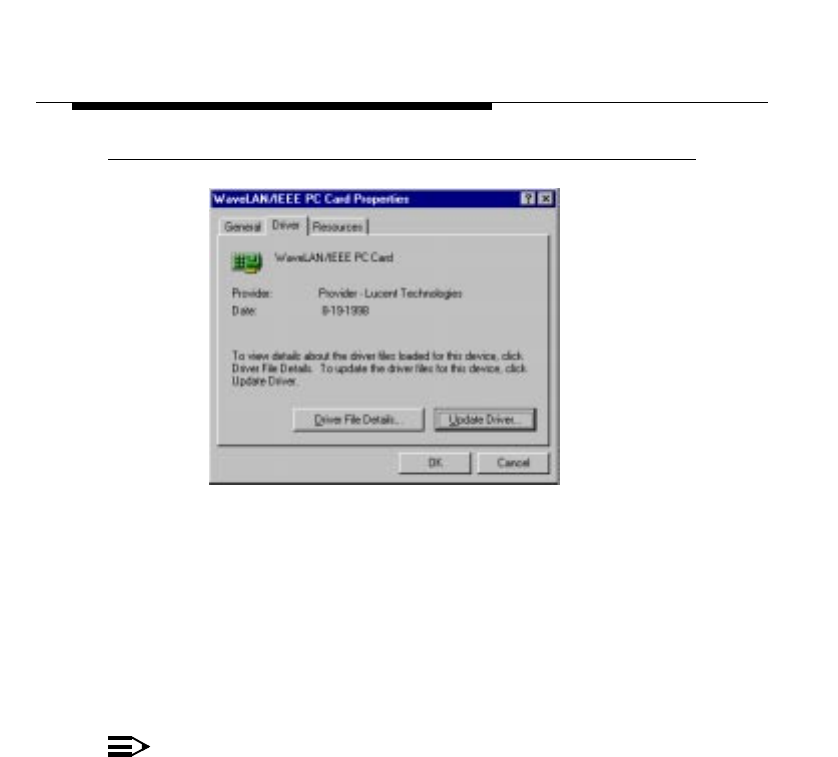
Troubleshooting
Upgrading the WaveLAN Miniport Driver
B-16 WaveLAN/IEEE Turbo 11 Mb PC Card
Figure B-5 Windows 98 Update Driver Window
■To display information about the currently installed driver,
click the “Driver File Details” button.
■To upgrade your current driver to a newer version click the
“Update Driver” button and follow the instructions as
displayed on your screen.
9. Restart your computer to finish the driver upgrade procedure
and to have the new driver loaded by the operating system.
10. (Optional) Upgrade the WaveMANAGER/CLIENT program.
NOTE:
The procedure described above may look familiar to users
of computers that run Windows 95 operating systems
which are identified as OSR2 versions. Although such
systems may also show an “Update Driver” button,
thorough testing in the Lucent Technologies WaveLAN
labs have proven that this procedure does not work for the
Windows 95 systems (the operating system will NOT
replace the current driver). For Windows 95 systems,
proceed as described on page B-18.
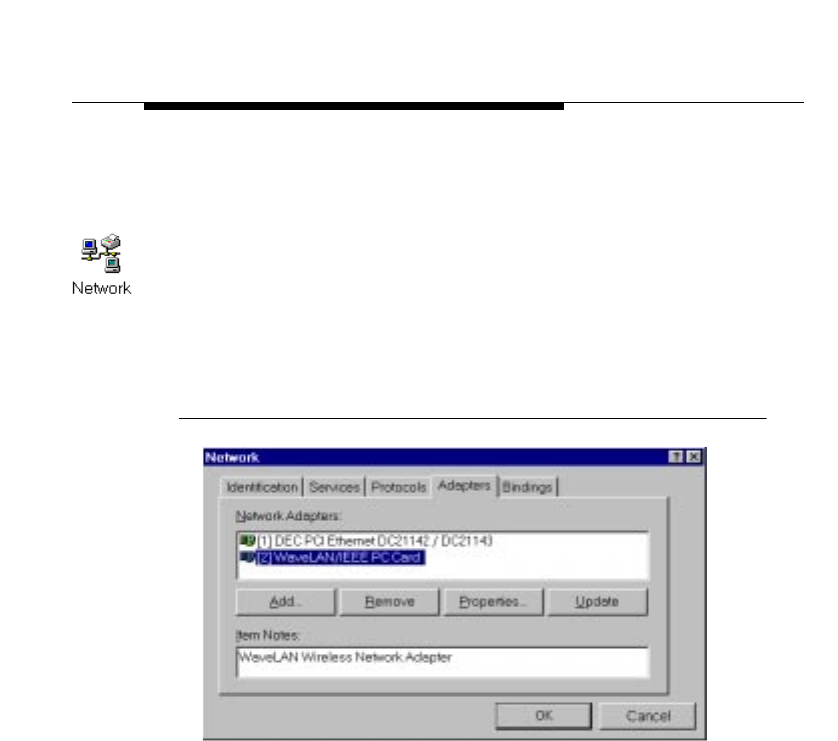
Troubleshooting
Upgrading the WaveLAN Miniport Driver
WaveLAN/IEEE Turbo 11 Mb PC Card B-17
Upgrading the driver for Windows NT B
1. On the Windows Taskbar, click the Start button.
2. Click on Settings, then click Control Panel.
3. In the Control PaneI, double-click “Network Neighborhood”.
4. Select the “Adapters” tab to display the window as pictured in
Figure B-6 on page B-17
5. Select the “IEEE WaveLAN Adapter” and click “Update”.
6. Follow the instructions as they appear on your screen.
Figure B-6 Update Driver in Windows NT
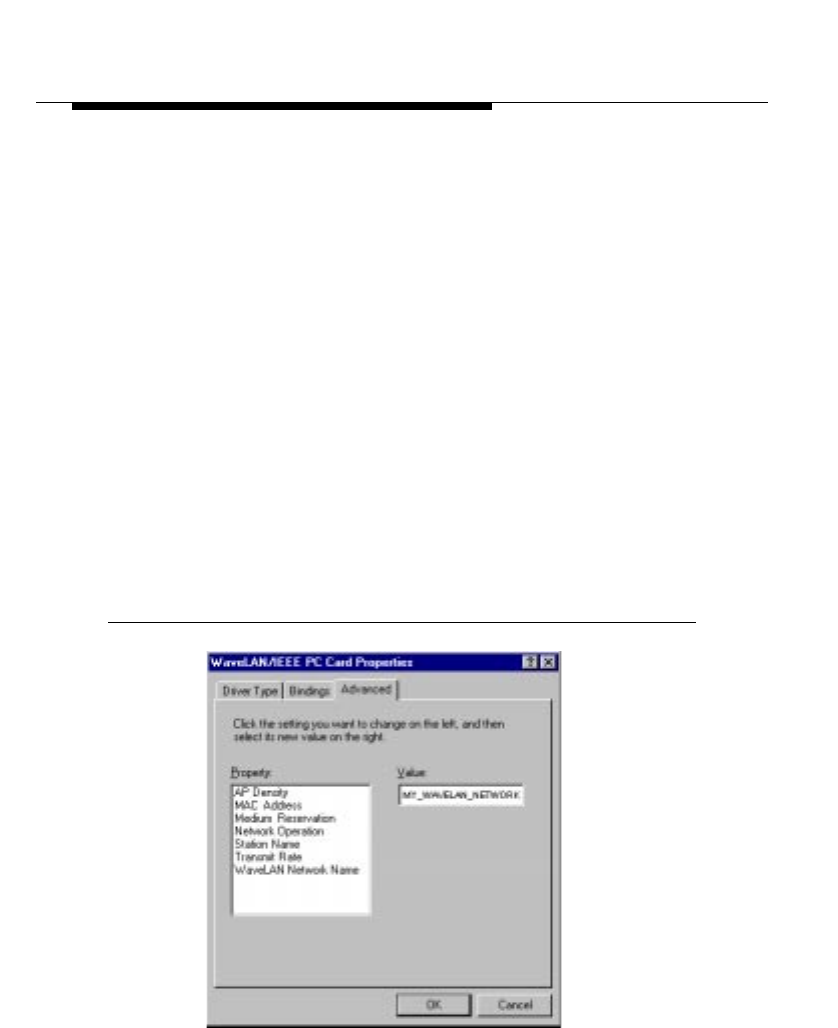
Troubleshooting
Upgrading the WaveLAN Miniport Driver
B-18 WaveLAN/IEEE Turbo 11 Mb PC Card
Upgrading the driver for Windows 95 B
To upgrade the WaveLAN Miniport driver on a Windows 95
system, you will typically need to perform the following three steps:
1. Remove the current WaveLAN Miniport Driver.
2. (Optional) Physically delete the driver file from your hard
disk.
3. (Re-)install the latest WaveLAN Miniport Driver.
Step 2 is optional, subject to the type of driver you have currently
installed:
■When the interface of your current driver looks as displayed in
Figure B-7 on page B-18, you
must
delete the driver files from
the hard-disk,
prior
to installing the new drivers.
■When the interface of your current driver looks as pictured in
Figure B-8 on page B-19, you may, but do not need to delete
the driver files from the hard-disk.
Figure B-7 Interface of early WaveLAN Drivers
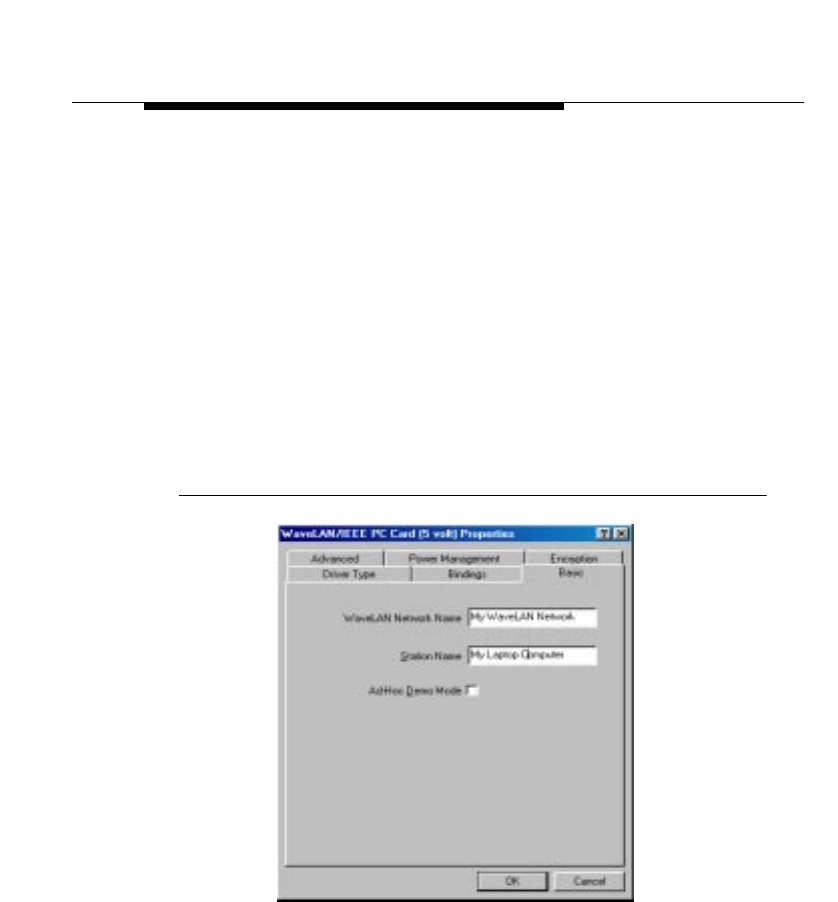
Troubleshooting
Upgrading the WaveLAN Miniport Driver
WaveLAN/IEEE Turbo 11 Mb PC Card B-19
Why delete the old driver? The “Plug & Play” support of Windows
95 operating systems associates a specific driver with specific
hardware. When you select the option “Remove Driver” from the
Network (Neighborhood) Control Panel, the operating system will
only disable the driver, but will not delete the driver from your
harddisk (see also “What You Need to Know” on page 3-2).
When trying to upgrade a driver, the Windows operating system
will recognize your WaveLAN card as a piece of hardware that had
been installed before and will attempt to re-install the old driver: i.e.
when the operating system finds the appropriate driver files on
your hard disk, it will not bother copying the files from the diskette
with the new drivers.
Figure B-8 Setup WaveLAN Parameters

Troubleshooting
Upgrading the WaveLAN Miniport Driver
B-20 WaveLAN/IEEE Turbo 11 Mb PC Card
Removing the WaveLAN Miniport Driver B
1. Close all applications that are currently open
2. On the Windows Taskbar, click the Start button.
3. Click on Settings, then click Control Panel.
4. In the Control PaneI window, double-click the “Network” icon.
5. Select the IEEE WaveLAN Adapter and click the “Remove”
button.
The Windows operating system will disable the Miniport driver
and update the driver configuration files. It will not delete the
driver from your computer’s harddisk.
This means that when you would re-insert the WaveLAN card,
your Windows operating system will attempt to activate the
same driver files again (see also “What You Need to Know” on
page 3-2).
6. When prompted to “Restart your computer” select:
■Yes, if you don’t mind that the driver and configuration files
reside on your hard disk (the restart will finish your
procedure to disable the driver).
■No, if you would like to physically remove the drivers from
your hard disk (typically required to upgrade the driver on
a Windows 95, 98 operating system).
Proceed as described under “Deleting the WaveLAN
Driver Files” on page B-21 to delete the driver and its
information and configuration files from your harddisk.

Troubleshooting
Upgrading the WaveLAN Miniport Driver
WaveLAN/IEEE Turbo 11 Mb PC Card B-21
Deleting the WaveLAN Driver Files B
The procedure to physically remove the WaveLAN Miniport Driver
files from your harddisk is similar for all Windows operating
systems.
!CAUTION:
Prior to deleting the files from your harddisk, it is important
to remove the drivers as described on page B-20.
Failing to do so prevents the Windows operating system
from cleaning the Windows Registry, which might lead to
complications when you try to re-install the WaveLAN
driver in the future.
1. Open the Windows Explorer.
2. In the Explorer menu, click on “View” and select “Options”
3. From the “View” tab, select “Show all files” and clear the
check-box “Hide MS-DOS file extensions”.
4. Click the “Apply” button to return to the Explorer window.
5. Back in the Explorer, open the Windows System folder:
■c:\windows\system for Windows 95 and 98
■c:\winnt\system32\drivers for Windows NT systems
6. Delete the WaveLAN driver files listed below, as identified for
your operating system:
■For Windows 95/98 delete the following files from the
folder c:\windows\system:
— wvlan41.sys
— wvlanuif.vxd
If present (subject to the driver version you had previously
installed) also delete the files:
— wv41int.dll
— wvlan41.hlp
— wvlan41.cnt

Troubleshooting
Upgrading the WaveLAN Miniport Driver
B-22 WaveLAN/IEEE Turbo 11 Mb PC Card
■For Windows NT systems delete the files listed below from
the folder c:\windows\system32:
—wvlan41.dll
—wvlan41.hlp
— wvlan41.cnt
From the folder c:\windows\system32\drivers delete:
—wvlan41.sys
7. Next delete the inf files:
■For Windows 95 open the folder c:\windows\inf and delete
the file: wvlan41.inf
■For Windows 98 delete the file: Provider - Lucent
Technologies WVLAN41 from the folder c:\windows\inf and/
or c:\windows\inf\other
8. Close the Windows Explorer and Restart your computer.
When deleting the WaveLAN Miniport Driver files was part of an
“Upgrade Driver” routine, you can now (re-)install the new
WaveLAN Miniport Driver as described in Chapter 3 ”Installation
for Windows”.

Troubleshooting
MS-DOS Systems
WaveLAN/IEEE Turbo 11 Mb PC Card B-23
MS-DOS Systems B
Error Messages B
No PACKET.INI found B
The WaveLAN Packet Driver will display this error message in one
of the following two situations:
■The driver could not find the file PACKET.INI
■The file PACKET.INI contained invalid parameter values that
prevented the driver from loading.
Subject to the type of error, the driver may either load using the
factory-set defaults or not load at all.
You are advised to verify the path statement in the “AUTOEXEC.BAT”
file. You may need to add a statement to your “AUTOEXEC.BAT” file
that will make the directory that contains the WaveLAN Packet
driver the active directory. When the PACKET.INI file is stored in the
same directory as the WaveLAN Packet Driver, the driver should
be able to automatically find the PACKET.INI file.
Can Not Connect To The Network B
The WaveLAN Netwrok Name is case-sensitive. When you
entered this name, the value should have been placed between
quotation marks e.g. "My WaveLAN Network".
If you omitted the quotation marks, the driver will interpret the
value as all upper-case e.g. MY WAVELAN NETWORK.
If your access points have been configured with both lower- and
uppre-case characters, the driver will not be able to establish a
radio connection.

Troubleshooting
MS-DOS Systems
B-24 WaveLAN/IEEE Turbo 11 Mb PC Card


WaveLAN IEEE 802.11 PC Card User’s Guide C-1
C
Installing in Windows CE
Introduction C
Windows CE devices are most commonly used on hand-held
computing devices also referred to as H/PC devices.
Subject to the type and brand of the device, you will see that
multiple versions of the Windows CE operating system exist today,
where each CE device may also use a specific type of processor.
The WaveLAN/IEEE drivers will only work with CE devices that:
■Run the MS-Windows CE operating system version 2.0 in
combination with a MIPS, SH3 and X86 processor, or
■Run the MS-Windows CE operating system version 2.111 in
combination with a SH4, ARM or X86 processor.
To determine whether your Windows CE device satisfies these
requirements:
1. Click the button on the Windows Taskbar.
2. Click on Settings, then Control Panel.
3. On the Control Panel, double-click the “System” icon to display
the window pictured in Figure C-1.
1 v2.11 is sometimes also referred to as MS-Windows CE HPC PRO v3.0.

Installing in Windows CE
Introduction
C-2 WaveLAN IEEE 802.11 PC Card User’s Guide
Figure C-1 Windows CE CPU Type
Installing the WaveLAN Driver C
What you Need C
Windows CE devices are typically used in combination with
desktop computers running ‘Windows CE Services’ to transfer
data between the desktop computer and the H/PC device.
To use WaveLAN IEEE 802.11 in your Windows CE device, you
will need to:
1. Run the WaveLAN installation file “setup.exe” for Windows CE
to copy the Miniport driver and configuration files from the
floppy disk to the “synchronization folder” for Windows CE
services on your desktop computer, and
2. Use the Windows CE Services to transfer files to your H/PC
device.
The default location of the Windows CE “synchronization
folder is: C:\Program Files\Windows CE Services\wavelan
Please refer to the Microsoft Handheld PC Companion booklet and
the user documentation of your H/PC device for more information
about installing the Windows CE Services.

Installing in Windows CE
Introduction
WaveLAN IEEE 802.11 PC Card User’s Guide C-3
Running the Installation Program C
To install the WaveLAN drivers on your Windows CE device,
simply do the following:
1. Insert the WaveLAN CD-ROM into the desktop computer.
2. Browse to the CD-ROM folder that includes the Windows CE
driver files. For example:
e:\software\adapter\pc_card\drivers\win_ce
Where "e" represents the drive letter of your CD-ROM drive.
3. Double-click the "setup2xx.exe" file that matches the version
of the Windows CE operating system on the handheld device:
■Use setup200.exe when your handheld device runs
Microsoft Windows CE version 2.0
■ Use setup211.exe when your handheld device runs
Microsoft Windows CE version 2.11
■When finished, use the serial cable and/or docking station
to connect your Windows CE device to the desktop
computer.
Once the computers have been connected, the Windows CE
services will automatically copy the files and drivers from your
desktop computer to the Windows CE device.
NOTE:
If you encounter difficulty copying the WaveLAN driver files
to your Windows CE device, please refer to the Microsoft
Handheld PC Companion booklet and the user
documentation of your H/PC device for more information
about installing and/or troubleshooting the Windows CE
Services.
If you encounter difficulty establishing a network
connection after you installed the WaveLAN drivers
successfully, consult the readme.txt of the WaveLAN driver
files for Windows CE for troubleshooting hints.

Installing in Windows CE
Introduction
C-4 WaveLAN IEEE 802.11 PC Card User’s Guide
Using WaveLAN with Windows CE C
When you insert the WaveLAN card into your Windows CE device,
it will start operation with the following factory-set defaults:
■Connect to a Network Infrastructure
■Use the WaveLAN Network Name “ANY” to connect to the first
access point that provides a communications quality that is
acceptable or better.
On the Control Panel of your Windows CE device, you will also find
a WaveLAN icon, to view or modify the WaveLAN parameters.
Monitoring Wireless Performance C
The WaveLAN software for Windows CE devices, does not include
diagnostic tools. This is partially due to the memory limitations of
Windows CE devices.
However you can use other WaveLAN stations to monitor wireless
communications between the other station and your Windows CE
device.
■For Independent Network environments, you should start the
WaveMANAGER/CLIENT IEEE program on a WaveLAN
computer running either the Windows 95, 98 or Windows NT
operating systems.
The Link Test mode of this utility enables you to analyze the
communications quality between the “Initiator” station and your
Windows CE device (identified as the “Remote Station”).
■In Infrastructure Networks, consult the LAN Administrator to
run the WaveMANAGER/AP tool. The “Remote Link Test” of
this utility enables the LAN Administrator to analyze the
communications quality between the WavePOINT-II (identified
as the “Initiator” station) and your Windows CE device
(identified as the “Remote Station”).

Installing in Windows CE
Introduction
WaveLAN IEEE 802.11 PC Card User’s Guide C-5
Modifying Configuration Parameters C
To view or modify the WaveLAN configuration parameters, open
the Control Panel on your Windows CE device and double-click
the WaveLAN icon.
For more information about these parameters, please consult:
■The WaveLAN help system for your Windows CE drivers by
clicking the “?” help icon, or
■The chapters about other Windows operating systems
described earlier in this User’s Guide.


Contents
D
Installation for MS-DOS
Introduction D-1
What You Need to Know D-1
Driver Types D-1
Installation Overview D-2
Copy the WaveLAN Software D-3
Setup the WaveCAD Program D-4
Card & Socket Services D-4
Intel 82365 PCIC D-5
Install the Network Client Software D-9
Setup the WaveLAN Parameters D-10
DOS ODI Driver Configuration D-10
■About the NET.CFG File D-17
Packet Driver Configuration D-19
■Setup the WaveLAN Packet Driver D-19
Finishing Installation D-25
Advanced Options D-27
Dual Card Configuration D-27
Start-up Menu Configuration D-27




WaveLAN IEEE 802.11 PC Card User’s Guide D-1
D
Installation for MS-DOS
Introduction D
What You Need to Know D
Installing an IEEE 802.11 WaveLAN PC Card requires the same
level of expertise that you would need to install any other type of
standard Ethernet network adapter card. It is assumed that you
have a working knowledge of MS-DOS operations and of installing
network adapter cards and network client software.
Driver Types D
When your computer runs the MS-DOS operating system, or
Microsoft Windows for Workgroups (usually referred to as
Windows 3.x), you can use one of the following network drivers:
■WaveLAN DOS ODI Driver (WVLAN43.COM)
■WaveLAN Packet Driver (WVLAN42.COM)
To install these network drivers, you will also need a program
called the “WaveLAN Card Access Driver” (WaveCAD).
The WaveCAD software is included with the MS-DOS Driver
software that was shipped with your IEEE 802.11 WaveLAN Card.
The WaveCAD driver (wvlancad.sys) will enable you to access the

Installation for MS-DOS
Introduction
D-2 WaveLAN IEEE 802.11 PC Card User’s Guide
WaveLAN Card via any PC Card slot that is controlled by an Intel
82365 PCIC or computers that support Card & Socket Services.
Installation Overview D
To install the IEEE 802.11 WaveLAN PC Card in an MS-DOS
environment, you will need to:
1. Copy the WaveLAN software manually to the hard disk of your
computer.
2. Setup the WaveCAD program.
3. Install the Network Client Software for your network operating
system.
4. Setup the WaveLAN configuration parameters.
5. Restart the computer to verify that the WaveCAD executes
successfully and the network driver is loaded.
To setup the various configuration parameters, you may need to
edit a number of system files. You can use any MS-DOS line editor
to edit these files, for example the MS-DOS ‘EDIT‘ command.
Example DOS commands:
c:\
edit config.sys

Installation for MS-DOS
Copy the WaveLAN Software
WaveLAN IEEE 802.11 PC Card User’s Guide D-3
Copy the WaveLAN Software D
The IEEE 802.11 WaveLAN PC Card disk includes a small batch
file (CPY2HDSK.BAT). This file will:
■Create a new directory on your hard disk, and
■Copy the IEEE 802.11 WaveLAN PC Card software to this new
directory.
To copy the WaveLAN software, proceed as follows:
1. Choose a name for the hard disk directory where you would
like to store the WaveLAN software: e.g. c:\wavelan
2. Place the WaveLAN software diskette in drive A:
3. Make drive A: the current drive
4. Run the batch file CPY2HDSK.BAT with the chosen hard disk
directory name as parameter.
Example DOS commands:
a:\
cpy2hdsk c:\wavelan

Installation for MS-DOS
Setup the WaveCAD Program
D-4 WaveLAN IEEE 802.11 PC Card User’s Guide
Setup the WaveCAD Program D
To allow MS-DOS-based computers to “identify” the presence of a
PC Card in the PC Card slot, the computer needs dedicated
software that will enable it to do so. For your WaveLAN IEEE
802.11 card this can either be:
■Card & Socket services software as provided by various
software vendors, or
■The WaveLAN Card Access Driver (wlancad.sys), a Lucent
Technologies proprietary driver, that was designed specifically
for WaveLAN cards.
The card software must be loaded before any other program
(network driver or utility) tries to access the WaveLAN card.
In this section, we describe the proper WaveCAD installation
procedure and settings for the following systems:
■Computers using Card & Socket Services
■Intel 82365 PCIC based computers
Card & Socket Services D
To ensure the WaveCAD is always run at start-up time, you must
edit the system file “CONFIG.SYS” to include a “DEVICE” statement
that will identify the path and filename of the WaveCAD program.
Example DOS commands:
c:\
edit c:\config.sys
The format of the device line is as follows:
DEVICE = [path name]wvlancad.sys

Installation for MS-DOS
Setup the WaveCAD Program
WaveLAN IEEE 802.11 PC Card User’s Guide D-5
When for example your device line looks as follows:
DEVICE = c:\wavelan\wavecad\wvlancad.sys
With Card & Socket Services, you do not need to set any
parameters (Memeory, IRQ, I/O Port) in the “DEVICE” statements.
However, if you would like to overrride the default settings, follow
the directions for “Intel 82365 PCIC” on page D-5, using Table D-1
on page D-7 to identify valid parameter values that can be included
in the wvlancad.sys “DEVICE” statement.
Intel 82365 PCIC D
For Intel 82365 PCIC based computers, you must start the
WaveLAN Card Access Driver (wvlancad.sys) before any other
program (network driver or utility) can access the WaveLAN card.
To ensure the WaveCAD is always run at start-up time, you must
edit the system file “CONFIG.SYS” to include a “DEVICE” statement
that will identify the:
■Path and file name of the wvlancad.sys program
■Memory Address of the WaveLAN card
■I/O Port Address of the WaveLAN card
■Interrupt Request Line number (IRQ) of the WaveLAN card.
Use Table D-1 on page D-7 to identify valid parameter values that
can be included in the wvlancad.sys “DEVICE” statement.
In order for your card to function properly, you will need to verify
whether the values that you select to include in the “DEVICE”
statement are not already used by another device that has been
installed in your computer. Consult your LAN Administrator or a
computer expert to determine an available Memory Address, I/O
Port Address and IRQ value that you can use to install the
WaveCAD driver.

Installation for MS-DOS
Setup the WaveCAD Program
D-6 WaveLAN IEEE 802.11 PC Card User’s Guide
Alternatively you can use the Microsoft Diagnostics program
(MSD.EXE) to determine the available values. For more information
about Microsoft diagnostics, please refer to the documentation that
came with your MS-DOS operating system.
You can use any MS-DOS line editor to edit the CONFIG.SYS file.
The format of the device line is as follows:
DEVICE = [path name]wvlancad.sys /m=xxxx /b=xxxx /i=nn
For example, if your device line looks as follows:
DEVICE = c:\wavelan\wavecad\wvlancad.sys /m=d100 /b=0340 /i=11
The WaveCAD will be programmed to use:
■Memory Address d100 - dFFF
■I/O Port Address 0340H and
■IRQ 11

Installation for MS-DOS
Setup the WaveCAD Program
WaveLAN IEEE 802.11 PC Card User’s Guide D-7
Table D-1 WaveCAD Configuration Parameter Values
NOTE:
When editing the “CONFIG.SYS” file, please note the
following:
— Remove any other PCMCIA-related “DEVICE”
statement from the “CONFIG.SYS” file. When for
example the “CONFIG.SYS” file includes “DEVICE”
statements for “Card Services” or “Socket Services”
you must remove these statements.
You are advised to consult the documentation that
came with your computer or other PCMCIA device to
help you to identify these statements.
Parameter Description Valid Values
<path> Disk drive and directory containing WaveCAD program
wavecad.sys (do not type brackets)
/m=xxxx Memory Address 4-digit hexadecimal value
Valid range: C000 - EF00 in
increments of 100
For example:
C000, C100, C200, or C300, etc.
/b=xxxx I/O Port Address 4-digit hexadecimal value
Valid range: 0300 - FFC0 in
increments of 40
For example:
0300, 0340, 0380, 03C0 or
FF00, FF40, FF80, or FFC0
/i=nn IRQ 1- or 2-digit decimal value
Valid values:
3, 4, 5, 7, 9, 10, 11, 12, 14, or 15

Installation for MS-DOS
Setup the WaveCAD Program
D-8 WaveLAN IEEE 802.11 PC Card User’s Guide
— When your computer has a memory manager program
installed, for example “EMM386.EXE”, you must exclude the
Memory Address space that you assigned to the
WaveCAD program in the previous step (see page D-6).
To exclude the Memory Space address, you must add an
exclude parameter to “DEVICE” statement that activates the
memory manager program.
For example, if your computer uses the “EMM386.EXE”
memory manager program, your “DEVICE” statement could
look as follows:
DEVICE=c:\dos\emm386.exe noems x=d100-d1ff
— When your computer runs Microsoft Windows 3.x, you
must also edit the Windows “SYSTEM.INI” to protect the
Memory Address space that you assigned to the
WaveCAD program in the previous step (see page D-6).
You can use any ASCII text editor, such as Windows
Notepad to edit the “SYSTEM.INI” file and add the following
statement to the section “386Enh”:
Example:
= [386Enh] ... EMMExclude=D100-D1FF

Installation for MS-DOS
Install the Network Client Software
WaveLAN IEEE 802.11 PC Card User’s Guide D-9
Install the Network Client Software D
To use the WaveLAN card in a network environment, you will need
to install Network Client software.
If you already had Network Client software installed, you are
advised to remove this software, and run the Network Client
installation program again.
1. Make the directory that contains the Network Client software
the active directory.
For example when installing the Network Client software from
a floppy disk:
a. Insert the disk into floppy drive A:, and
b. Make drive A: the active drive.
2. Proceed as described in the User documentation that came
with the Network Client software to start the installation.
3. When prompted to select a driver use the option “Other driver”.
Sometimes this option is referred to as “updated” or “OEM”
driver, or “driver provided by other vendor”.
4. Remove the Network Client software disk from the floppy disk
drive and insert the WaveLAN disk for MS-DOS environments.
5. Follow the instructions as they appear on your screen.

Installation for MS-DOS
Setup the WaveLAN Parameters
D-10 WaveLAN IEEE 802.11 PC Card User’s Guide
Setup the WaveLAN Parameters D
To connect your IEEE 802.11 WaveLAN PC Card to a WaveLAN
network system, you must configure the WaveLAN parameters to
match the values of the network.
In LAN Infrastructure environments, these values should typically
match the values as set for the WavePOINT-II access points.
Consult your LAN Administrator for the values that apply in your
network.
This section describes how to set the parameters for the following
IEEE 802.11 WaveLAN Drivers:
■WaveLAN DOS ODI Driver
■WaveLAN Packet Driver
DOS ODI Driver Configuration D
When you are installing the Network Client software for Novell
NetWare, the installation program will prompt you to enter the
WaveLAN parameters, and save your parameter settings in the
Novell network configuration file “NET.CFG”.
If your Network Client Software did not prompt you to enter the
parameters, or if you wish to modify the WaveLAN parameter
settings you may need to edit the “NET.CFG” file manually, as
described in “About the NET.CFG File” on page D-17.
Table D-1 lists the various WaveLAN parameters with their value
ranges and usage.
NOTE:
Alphabetical character values are case-sensitive and
should be entered between “quotation marks “. Values
without quotes will be interpreted as UPPERCASE only.

Installation for MS-DOS
Setup the WaveLAN Parameters
WaveLAN IEEE 802.11 PC Card User’s Guide D-11
Table D-2 WaveLAN DOS ODI Driver Parameters
Parameter Description
1 Station Name Alphanumeric string with a maximum of 32
ASCII characters that will identify your
computer on the network when using the
WaveMANAGER/CLIENT diagnostics tool.
Valid Values: any character in the range of
“A-Z”, “a-z” and “0-9”.
Enter your value between “quotes”.
2 Network Type Use this parameter to select the type of
network to which you wish to connect your
computer.
Valid values: 1 or 3.
■1 will connect your computer to an
anonymous Ad-hoc workgroup (BSS)
■3 Will connect your computer to an IEEE
802.11 Infrastructure (ESS) identified by
parameter 2a “WaveLAN Network Name”.
2a WaveLAN Network
Name Alphanumeric string with a maximum of 32
ASCII characters that identifies the network
to which you would like to connect your
computer.
This parameter is only used when you
selected the Network Type “Infrastructure”.
Valid Values: any character in the range of
“A-Z”, “a-z” and “0-9” where:
■The value “ANY” enables your station to
connect to any IEEE 802.11 compliant
network (see also “Closed System”).
■A “user-defined name” allows your station
to connect to a specific network only. This
value should match the value as set for
the WavePOINT-II access points in your
network.

Installation for MS-DOS
Setup the WaveLAN Parameters
D-12 WaveLAN IEEE 802.11 PC Card User’s Guide
3 Transmit_Rate1Controls the data rate at which your
WaveLAN card will transmit its data.
Valid Values:
1. Fixed Low
2. Fixed Standard
3. Auto Select High-Medium-Standard-
Low (default).
4. Fixed Medium (Turbo cards only)
5. Fixed High (Turbo cards only)
6. Auto Select Standard-Low
7. Auto Select Medium-Standard-Low
4a Card Power
Management Enables/disables Power Management
Valid Values:
■Y - Yes, enable Power Management
■N - No, disable Power Management
(=default).
When enabling Power Management you will
also need to set the
Maximum_Sleep_Duration, and
Receive_All_Multicasts parameter.
When you disable Power Managment,
these two parameters will be disabled as
well.
4b Maximum Sleep
Duration This parameter specifies the maximum time
the station is allowed to spend
consecutively in DOZE state.
Valid Values: any numerical value in the
range of 1-65535 (default value is 100).
This parameter determines the Listen
Interval of the station’s Power Management
scheme.
If 4a Card Power Management is disabled,
this parameter will be ignored
Table D-2 WaveLAN DOS ODI Driver Parameters—Continued

Installation for MS-DOS
Setup the WaveLAN Parameters
WaveLAN IEEE 802.11 PC Card User’s Guide D-13
4b Receive All Multicasts This parameter specifies whether the
station must receive all multicast frames
when in Power Management mode.
Valid Values:
■Y - Yes, receive all Mulitcasts (= default)
■N - No, do not receive all Multicast
When this parameter is enabled, the
WaveLAN station will wake up at regular
intervals to receive the multicast frames.
Although enabling this option may yield less
optimal power savings, you are advised to
leave this parameter enabled when using
your computer in regular networking
environments.
If 4a Card Power Management is disabled,
this parameter will be ignored.
5 AP Density Parameter that controls the Roaming
sensitivity of your computer (must be set
according to the settings of the
WavePOINT-II access points).
Valid Values:
1. Low Density (default)
2. Medium Density
3. High Density
Table D-2 WaveLAN DOS ODI Driver Parameters—Continued

Installation for MS-DOS
Setup the WaveLAN Parameters
D-14 WaveLAN IEEE 802.11 PC Card User’s Guide
6 Medium Reservation Enables/disables the RTS/CTS Mechanism
Valid Values:
■2347 (default)
Disables Medium Reservation
■Numeric value in the range of “0-2346”
Enables the RTS/CTS Mechanism, and
sets the frame length threshold from
which the station should start using the
RTS/CTS Mechanism (recommended
value is “500”).
See “Medium Reservation” on page 4-8 for
more information.
7 Node Address (MAC
Address) To be used only when your network system
requires Local MAC Addressing.
Valid Values:
■“None” to use the card’s factory installed
Universal MAC address (=default)
■12 hexadecimal digits that identify the
user-defined Local MAC Address.2
The 2nd digit of the first digit-pair must be
2, 6, A, or E.
Table D-2 WaveLAN DOS ODI Driver Parameters—Continued

Installation for MS-DOS
Setup the WaveLAN Parameters
WaveLAN IEEE 802.11 PC Card User’s Guide D-15
8 Enable Encryption Enables/disables WEP encryption.
Valid values:
■Y - Yes, enable WEP encryption
■N - No, do not enable WEP encryption
(=default).
When this parameter is enabled, you can:
■Select up to four key for decrypting data
received via the wireless interface.
■Select one Transmit key (8e) for
encryptiing data that will be transmitted
via the wireless interface.
This parameter should only be enabled
when using WaveLAN IEEE Silver cards. If
you decide to enable encryption, please
note that all stations will be configured with
identical WEP key values.
8a WEP Key 1 Identifies one of the four keys that your
waveLAN card can use to decrypt data
received via its wireless interface.
Valid values for Silver cards:
■5-character ASCII key or 10-digit
hexadecimal key.
Valid values for Gold cards:
■5-character ASCII key or 10-digit
hexadecimal key.
■13-characterASCII key or 26-digit
hexadecimal key.
The key value is case-sensitive.
Hexadecimal values must be preceded by
“0x”.
All wireless clients and access points
should be configured with identical key
values.
Table D-2 WaveLAN DOS ODI Driver Parameters—Continued

Installation for MS-DOS
Setup the WaveLAN Parameters
D-16 WaveLAN IEEE 802.11 PC Card User’s Guide
8b WEP Key 2 See 8a WEP Key 1
8c WEP Key 3 See 8a WEP Key 1
8d WEP Key 4 See 8a WEP Key 1
8a WEP Transmit Key Use this parameter to select one of the
identified WEP decription keys for
encrypting data that will be transmitted via
the wireless interface.
Valid values:
■1 - to use WEP Key 1
■2 - to use WEP Key 2
■3 - to use WEP Key 3
■4 - to use WEP Key 4
9 Media Frame Type Use this parameter to select the frametype
that is used within the network to which you
wish to connect the computer. Consult your
LAN Administrator for the value that applies
in your network.
Valid values:
■Ethernet 802.2 (=default)
■Ethernet 802.3
■Ethernet 802.II
■Ethernet 802.SNAP
1 This parameter does not influence at which data rate the station will
be able to receive data. I.E. When the transmit rate is locked to
Fixed Low, the station may still receive messages that were
transmitted at Standard speed.
2 Note: The Access Control security feature of WavePOINT-II access
points does not recognize Local MAC addresses. When the
WavePOINT-II devices in your network infrastructure have been
programmed to use this feature, leave this parameter Access Control
Table D-2 WaveLAN DOS ODI Driver Parameters—Continued

Installation for MS-DOS
Setup the WaveLAN Parameters
WaveLAN IEEE 802.11 PC Card User’s Guide D-17
About the NET.CFG File D
The WaveLAN configuration parameters for the DOS ODI driver
are stored in a network configuration file called “NET.CFG”.
A sample of the “NET.CFG” file is included on the IEEE 802.11
WaveLAN software diskette.
If you installed the Novell Network Client software as described
earlier in this chapter, this file was created automatically. You may
skip this section and proceed with “Finishing Installation” on page
D-25, unless you would like to modify the WaveLAN parameter
settings or wish to learn more about the “NET.CFG” file.
A “NET.CFG” file must always include a “Link Driver” statement that
refers to the appropriate network driver, and a list of parameters
and parameter values that apply to the referenced driver. For the
IEEE 802.11 WaveLAN driver the “NET.CFG” file will look as follows:
LINK DRIVER WVLAN43
; BASIC PARAMETERS
WAVELAN_NETWORK_NAME XXXXXXXX
PORT_TYPE X
STATION_NAMEXXXXXXXX
;ADVANCED PARAMETERS
;AP_DENSITYx
;TRANSMIT RATEX
;MEDIUM RESERVATIONXXXX
;NODE ADDRESS
All lines that start with a semi-colon ( ; ) are informational
comments to the user, i.e. the driver will ignore this information.
The basic parameters that you should set are:
■WaveLAN Network Name
■Station Name for your station
■Port Type - to identify the type of network to which you wish to
connect your computer.

Installation for MS-DOS
Setup the WaveLAN Parameters
D-18 WaveLAN IEEE 802.11 PC Card User’s Guide
All other parameters are optional and should preferable only be
used in special situations, typically upon advice of a WaveLAN
IEEE 802.11 expert.
Table D-2 on page D-11 lists the various WaveLAN parameters
with their value ranges and usage. The WaveLAN parameter
values for the WaveLAN DOS ODI driver are not case-sensitive:
the WaveLAN DOS ODI Driver will interpret all values as upper-
case values.
When the installation program of your Network Client software did
not prompt you to identify a driver or specify the WaveLAN
parameters you may need to identify the proper location of the
WaveLAN DOS ODI driver and the “NET.CFG” file. This will allow
your Network Client software to find the correct driver.
You are advised to copy the WaveLAN DOS ODI Driver and the
“NET.CFG” file to the same directory that you selected to install the
network operating system software. For example, when you
selected the directory “c:\network” use the following copy
commands:
c:\
cd\wavelan\drivers\dosodi
copy wvlan43.com c:\network
copy net.cfg c:\network
1. Edit the “NET.CFG” file to add the statement “Link Driver
WVLAN43”.
2. Enter the WaveLAN parameter values on a new line, directly
after the “link driver” statement.
Consult your LAN Administrator for values that apply in your
network environment.

Installation for MS-DOS
Setup the WaveLAN Parameters
WaveLAN IEEE 802.11 PC Card User’s Guide D-19
NOTE:
When modifying the “NET.CFG” file ensure that all
WaveLAN parameter lines will be indented. Use the
key of your keyboard to create an indent at the beginning
of each line that will contain a WaveLAN parameter.
3. When finished, save the “NET.CFG” file and restart your
computer.
4. Proceed with “Finishing Installation” on page D-25.
Packet Driver Configuration D
The installation of the WaveLAN Packet Driver is a procedure that
requires you to edit a number of system files manually.
To ensure that the WaveLAN Packet Driver is loaded at start-up,
you will need to add a few command line statements to the
“AUTOEXEC.BAT” file.
These statements should include:
■A path to the directory that contains the Packet Driver.
■A “load driver” statement.
The WaveLAN parameters will be identified in a network
configuration file called “PACKET.INI”.
The WaveLAN Packet Driver and the “PACKET.INI” file must reside
in the same directory on the hard disk of your computer. When you
used the commands as identified “Copy the WaveLAN Software”
on page D-3, this directory is typically c:\wavelan\drivers\packet.
Setup the WaveLAN Packet Driver D
1. Edit the “AUTOEXEC.BAT” file of your computer to add the path
and file name of the WaveLAN Packet Driver, and the “load
driver” statement:
TAB

Installation for MS-DOS
Setup the WaveLAN Parameters
D-20 WaveLAN IEEE 802.11 PC Card User’s Guide
cd\wavelan\packet
lh=wvlan42.com l
2. To set the WaveLAN parameters, edit the “PACKET.INI” file.
The structure of the “PACKET.INI” file is as follows:
; BASIC PARAMETERS
WAVELAN_NETWORK_NAME XXXXXXXX
STATION_NAMEXXXXXXXX
;ADVANCED PARAMETERS
;AP_DENSITYx
;TRANSMIT RATEX
;MEDIUM RESERVATIONXXXX
;MAC ADDRESS
All lines that start with a semi-colon ( ; ) are informational
comments to the user, i.e. the driver will ignore the information.
The basic parameters that you should set are:
■WaveLAN Network Name
■Station Name for your station.
All other parameters are optional and should preferably only
be used in special situations, typically upon advice of a
WaveLAN IEEE 802.11 expert.
NOTE:
The string for a “WaveLAN Network Name” is case-
sensitive. If your network includes stations that also use
the WaveLAN DOS ODI Driver, you are advised to select
upper-case characters only (see also “DOS ODI Driver
Configuration” on page D-10).
3. To set a parameter value, remove the semi-colon ( ; )
preceding the parameter name and enter a value within the
range as specified in Table D-3 on page D-22.

Installation for MS-DOS
Setup the WaveLAN Parameters
WaveLAN IEEE 802.11 PC Card User’s Guide D-21
At the end of the “PACKET.INI” file you will find an additional set of
generic Packet Driver parameters that are not directly related to
WaveLAN operation.
;DRIVER_CLASSX
;NOVELL_FLAGYES/NO
;PACKET_INTERRUPT0x XX
4. Consult your LAN Administrator to select the appropriate
values that apply in your situation from the range as specified
in Table D-4 on page D-24.
5. When finished, save the “PACKET.INI” file and restart your
computer.
6. Proceed with “Finishing Installation” on page D-25.

Installation for MS-DOS
Setup the WaveLAN Parameters
D-22 WaveLAN IEEE 802.11 PC Card User’s Guide
Table D-3 WaveLAN Packet Driver Parameter Values
Parameter Description
WaveLAN_Network_
Name Alphanumeric string with a maximum of 32 ASCII
characters that identifies the network to which you
would like to connect your computer.
Valid Values: any character in the range of “a-z”
and “0-9” (no spaces allowed) where:
■The value “ANY” enables your station to
connect to any IEEE 802.11 network.
■A user-defined name allows your station to
connect to a specific network only.
This value should matches the value as set for
the WavePOINT-II access points in your
network.
Station_Name Alphanumeric string with a maximum of 32 ASCII
characters that will identify your computer on the
network, e.g. when using the WaveMANAGER/
CLIENT diagnostics tool.
Valid Values: any character in the range of “a-z”
and “0-9” (no spaces allowed).
AP_Density Parameter that controls the Roaming sensitivity of
your computer (must be set according to the
settings of the WavePOINT-II access points).
Valid Values:
1. Low Density (default)
2. Medium Density
3. High Density
Transmit_Rate1Controls the data rate at which your WaveLAN
card will transmit its data.
Valid Values:
1. Fixed 1 Mbit/second
2. Fixed 2 Mbit/second
3. Auto Rate Select 2 Mbit/s -1 Mbit/s (default)
....continued on following page.

Installation for MS-DOS
Setup the WaveLAN Parameters
WaveLAN IEEE 802.11 PC Card User’s Guide D-23
For more information about each of the WaveLAN parameters:
■Consult the description for the WaveLAN parameters as
described in “Setting the WaveLAN Parameters” on page 3-13.
MAC_Address To be used only when your network system
requires Local MAC Addressing.
Valid Values:
■“None” to use the card’s factory installed
Universal MAC address (=default)
■12 hexadecimal digits that identify the user-
defined “Local MAC Address”.2
The 2nd digit of the first digit-pair must be
2, 6, A, or E.
Medium_Reservation Enables/disables the RTS/CTS Mechanism
Valid Values:
■2347 (default)
Disables Medium Reservation
■Numeric value in the range of “0-2346” Enables
the RTS/CTS Mechanism, and sets the frame
length threshold from which the station should
start using the RTS/CTS Mechanism
(recommended value is “500”).
See “Medium Reservation” on page 4-8 for more
information.
1 This parameter does not influence at which data rate the station will
be able to receive data. I.E. When the transmit rate is locked to 1
Mbit/s, the station may still receive messages that were transmitted
at 2 Mbit/second.
2 Note: The Access Control security feature of WavePOINT-II access
points does not recognize Local MAC addresses. When the
WavePOINT-II devices in your network infrastructure have been
programmed to use this feature, leave this parameter blank.

Installation for MS-DOS
Setup the WaveLAN Parameters
D-24 WaveLAN IEEE 802.11 PC Card User’s Guide
■Alternatively type the following command lines at the MS-DOS
prompt to display help for the WaveLAN Packet Driver.
cd\wavelan\drivers\packet
wvlan42.com h
Table D-4 Packet Driver Specific Parameters
Driver_Class A specific “Packet Driver” parameter that controls
the frame format.
Valid Values:
1. DIX Ethernet (v2.0) frame format (Default)
11. IEEE 802.3 with 802.2 headers frame format.
Novell_Flag Enables support the Novell IPX 802.3 frame format.
Valid Values:
Y. Convert all 802.3 type packets to 8137 type
packets.
N. No, do not use the NovellFlag (=default)
Packet_Interrupt This parameter identifies the software interrupt
number that the Packet Driver should use.
Valid Values (hexadecimal):
■0x60 (default)
■0x70
Enter the value without the 0x prefix.

Installation for MS-DOS
Finishing Installation
WaveLAN IEEE 802.11 PC Card User’s Guide D-25
Finishing Installation D
To finish the installation insert your IEEE 802.11 WaveLAN PC
Card and restart your computer. Carefully read the messages that
appear on your screen, to verify that:
■The WaveCAD program executes correctly, and
■Your computer loads the correct driver parameter settings of
your IEEE 802.11 WaveLAN PC Card.
Correct execution of the WaveCAD program is confirmed with the
message (example):
WaveLAN/IEEE Card Access Driver, Variant X, Version XX.XX
Memory: xxxx, I/O Base: xxxx, IRQ xx
Card Access Driver Installed
Where:
■XX.XX identifies the version of the WaveLAN Driver
■xx or xxx identifies the values that you entered upon
installation of the WaveCAD software as described in “Intel
82365 PCIC” on page D-5
A successful load of the WaveLAN Driver is confirmed with either
one of the following messages:
Example WaveLAN DOS ODI Driver:
WaveLAN/IEEE DOS ODI Driver Variant X, v0.0x (yymmdd)
Desired SSID = AAAAAAAAAA
Driver loaded successfully
IRQ xx, Port xxxx, Node Address = xxxxxxxxxxxx L
Max Frame 1514 bytes, Line Speed 2 Mbps, Bus ID 3
Board 1, Frame ETHERNET_802.2, LSB Mode
Where:
■AAAAAAAAA identifies the WaveLAN Network Name that
you entered in the NET.CFG file,

Installation for MS-DOS
Finishing Installation
D-26 WaveLAN IEEE 802.11 PC Card User’s Guide
■xx or xxx identifies the values that you entered upon
installation as described in “Intel 82365 PCIC” on page
D-5
Example WaveLAN Packet Driver:
WaveLAN/IEEE Packet Driver, Variant X, Version X.XX
Novell Flag NOT set
IO Base=xxxx IRQ=xx MAC Address=xxxxxxxxxxxx
Packet Interrupt=0xXX
Where:
■Version X.XX identifies the version of the WaveLAN
Packet Driver
■xx or xxx identifies the values that you entered upon
installation of the WaveCAD software as described in “Intel
82365 PCIC” on page D-5
■Packet Interrupt 0xXX identifies the value you specified in
the “PACKET.INI” file.

Installation for MS-DOS
Advanced Options
WaveLAN IEEE 802.11 PC Card User’s Guide D-27
Advanced Options D
Dual Card Configuration D
When you intend to use multiple WaveLAN PC Cards in a single
computing device, for example a wireless server, the CONFIG.SYS
file should contain a DEVICE statement with unique parameter
values for each card.
Example:
DEVICE = c:\wavelan\wavecad\wavecad.sys /m=d100 /b=0340 /i=11
DEVICE = c:\wavelan\wavecad\wavecad.sys /m=e300 /b=04C0 /i=14
Start-up Menu Configuration D
If you intend to use your computer in combination with multiple PC
Cards, an MS-DOS Start-up Menu may provide a useful solution in
one or more of the following situations:
■You are using your computer in combination with another PC
Card that requires “Card & Socket Services”, or
■You would like to use your computer with either your WaveLAN
card or an Ethernet adapter card.
The Start-up Menu will enable you to setup your computer to
prompt the computer user to select a specific configuration.
Subject to the selected menu option, the computer will
automatically load the drivers and programs required for each
specific option.
The Start-up Menu is a standard MS-DOS feature that is described
in the Microsoft MS-DOS User’s Guide.

Installation for MS-DOS
Advanced Options
D-28 WaveLAN IEEE 802.11 PC Card User’s Guide
NOTE:
When using Multiple Boot options to swap WaveLAN with
Ethernet adapters and vice versa, you will need to install
the Network Client software twice, selecting separate
directories for each of the Network Client configurations.
The start-up Menu should identify which Network
Configuration file will be loaded for each item subject to
the selected menu-item.
Failing to do so could lead to a situation where the
Network Client install programs would simply overwrite the
configuration settings of the card you installed first.
Example of a Start-up Menu Configuration D
This section includes samples of the system files “CONFIG.SYS” and
“AUTOEXEC.BAT” that enable you to setup a Start-up Menu.
The names and values printed do not necessarily correspond with
the actual path and file names or parameter values that apply in
your situation.
CONFIG.SYS File D
[MENU]
menuitem=WaveLAN
menuitem=CSSS
[COMMON]
DEVICE=c:\dos\himem.sys

Installation for MS-DOS
Advanced Options
WaveLAN IEEE 802.11 PC Card User’s Guide D-29
DEVICE=c:\dos\emm386.exe noems x=xxxx-xxxx1
DEVICE=c:\dos\setver.exe
[WaveLAN]
REM This menu item will enable WaveLAN Card Access Driver
DEVICE = c:\wavelan\wavecad\wvlancad.sys /m=xxxx /b=xxxx /i=xx2
[CSSS]
REM This menu item will enable Card and Socket Services
DEVICE=c:\csss\socksvce.exe3
DEVICE=c:\csss\cardsvce.exe
[COMMON]
DEVICE=c:\windows\ifshlp.sys
AUTOEXEC.BAT File D
SET TEMP=c:\temp
PROMPT $P$g
SET DIRCMD=/O/P
GOTO %config%
:WaveLAN
REM This section contains WaveLAN related commands
PATH c:\dos;\c:\wavelan;c:\network\wavelan4;c:\windows
c:\network\wavelan\startnet
goto end
:CSSS
REM This section contains Card and Socket Services related commands
PATH c:\dos;\c:\wavelan;c:\network\ethernet\5;c:\windows
1 See page D-19
2See “Intel 82365 PCIC” on page D-5
3 The program path and file names should match the actual path and file
names of your Card Services and Socket Services (CS&SS) software.
4 Path to the “NET.CFG” file that contains the parameter values for your
WaveLAN card.
5 Path to the second “NET.CFG” file that contains the parameter values for
an Ethernet card.

Installation for MS-DOS
Advanced Options
D-30 WaveLAN IEEE 802.11 PC Card User’s Guide
c:\network\ethernet\startnet
goto end
:end
LH c:\windows\smartdrv.exe
LH c:\dos\doskey.com
LH c:\mouse\mouse.com
LH c:\windows\odi.hlp
c:\windows\net start
win
For more information about MS-DOS Start-up Menus, please
consult the user documentation that came with your computer or
MS-DOS software.

Contents
E
Installing in Apple Macintosh
Introduction E-1
Installing the WaveLAN Driver E-2
Installing Networking Protocols E-2
Enabling your WaveLAN Card E-3
Using WaveLAN with PowerBooks E-5
Basic Parameters E-6
■Type of Network E-6
■WaveLAN Network Name E-7
Advanced Parameters E-7
Monitoring Wireless Performance E-9
Modifying Configuration Parameters E-9
Removing the WaveLAN Driver E-10


WaveLAN IEEE 802.11 PC Card User’s Guide E-1
E
Installing in Apple Macintosh
Introduction E
To connect your Apple PowerBook to a wireless network, you will
need to:
1. Install the WaveLAN card software
2. Install one or more networking protocols to allow your
WaveLAN computer to communicate with other wireless and/
or wired computers on the network.
3. Power up the computer with the WaveLAN card.
4. Configure the networking protocols of your MAC operating
system to select the WaveLAN interface for network
communication.
NOTE:
Before you proceed, please note the following:
■When upgrading from previous driver versions, always
remove previously installed WaveLAN drivers as
described on page E-10.
■When installing a new driver, always do so
without
the
card inserted into the computer.
■New WaveLAN drivers must be installed
prior
to
inserting the card!

Installing in Apple Macintosh
Installing the WaveLAN Driver
E-2 WaveLAN IEEE 802.11 PC Card User’s Guide
Installing the WaveLAN Driver E
1. Insert the WaveLAN diskette for the MAC operating system
into your Apple PowerBook.
2. Double-click the diskette icon on the “desktop” of your
computer, to display the contents of this WaveLAN diskette.
3. Now double-click the file called “WaveLAN Installer” to start
the installation program.
4. In the welcome window click the button “Continue” to proceed.
5. From the list of options select “Easy Install”.
If you have any applications open during the WaveLAN
installation process, you will be prompted to close these
applications.
■Click “No” to abort installation, or
■Click “Continue” to proceed and have the MAC operating
system close all the open applications.
6. Follow the instructions as they appear on your screen and
restart your computer.
NOTE:
Now that you have installed the WaveLAN driver, you will
need to add a networking protocol to allow communication
with other networking devices.
Installing Networking Protocols E
Subject to the type of networking environment, you should install
one or more of the following protocols:
■AppleTalk, most commonly used to connect a number of Apple
workstations to a networking environment identified as the
“Applezone”
■TCP/IP to connect to larger network infrastructures, and/or
allow connections to the internet via the network.

Installing in Apple Macintosh
Installing the WaveLAN Driver
WaveLAN IEEE 802.11 PC Card User’s Guide E-3
Optionally you can install and enable both networking protocols.
For more information about installing protocols, please consult the
“balloon help” and User’s Manual that came with your Apple
PowerBook.
To finish the installation of the WaveLAN drivers and networking
protocols, please restart your Apple PowerBook computer.
Enabling your WaveLAN Card E
Insert the WaveLAN PC Card into your computer. Once your
computer has restarted, you will see the WaveLAN/IEEE icon
appear on the desktop of your Apple PowerBook.
NOTE:
If this icon is not displayed, verify if the PC Card is properly
inserted into the PC Card slot of your Apple PowerBook.
To enable your WaveLAN connection, you will need to configure
the AppleTalk protocol to use the WaveLAN card for its network
communication.
1. Double-click the WaveLAN/IEEE icon to launch the AppleTalk
installation.
2. In the top side of the AppleTalk window, open the pull-down list
of the item “Connect via:”
3. Select the item WaveLAN/IEEE as pictured in Figure E-1.
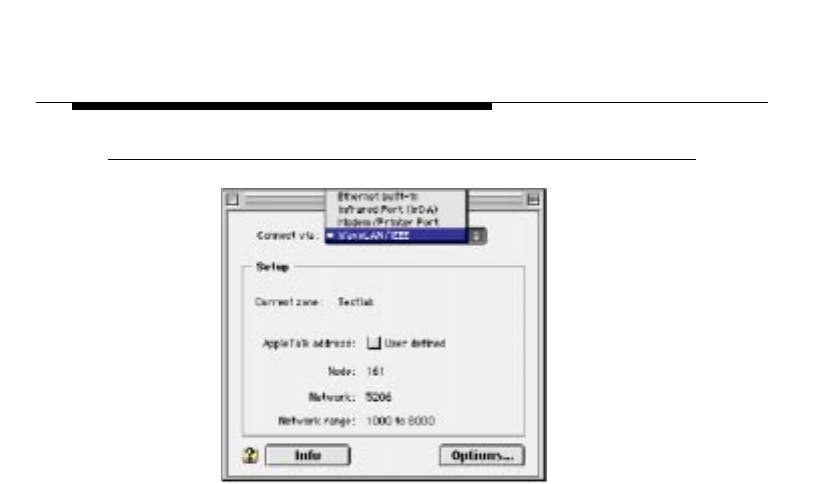
Installing in Apple Macintosh
Installing the WaveLAN Driver
E-4 WaveLAN IEEE 802.11 PC Card User’s Guide
Figure E-1 Setting the AppleTalk Parameters
4. Use the button on the top right side of the window to confirm
your changes and close the window again.
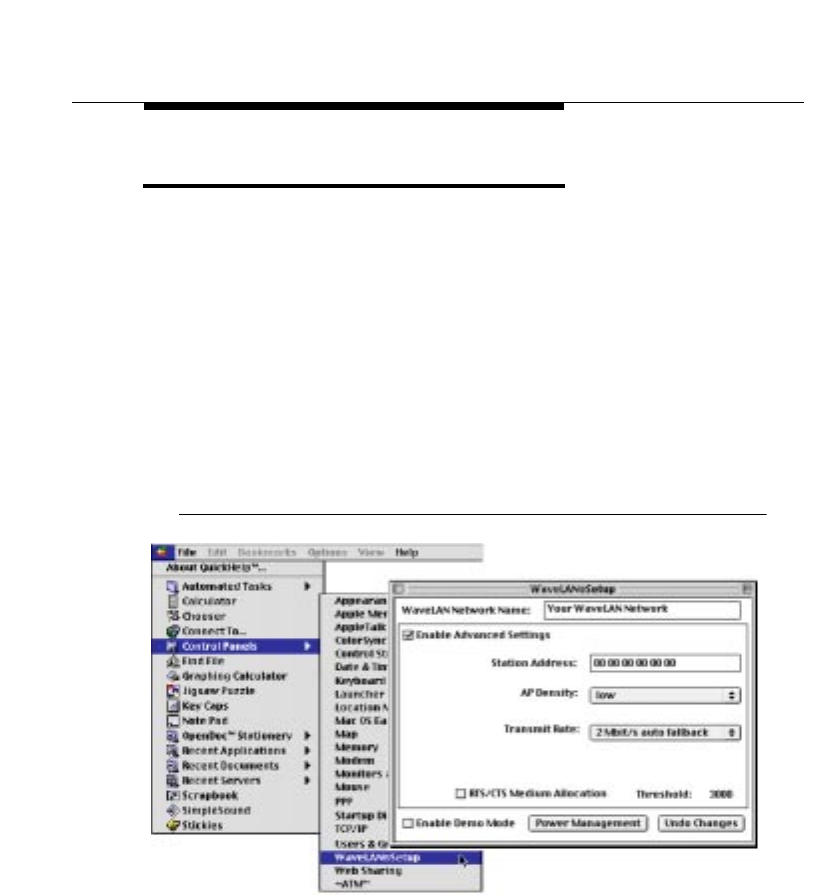
Installing in Apple Macintosh
Using WaveLAN with PowerBooks
WaveLAN IEEE 802.11 PC Card User’s Guide E-5
Using WaveLAN with PowerBooks E
When you insert the WaveLAN card into your Apple PowerBook
computer, it will start operation with the following factory-set
defaults:
■Connect to a Network Infrastructure.
■Use the WaveLAN Network Name “ANY” to connect to the first
access point that provides a communications quality that is
acceptable or better.
To view or modify the WaveLAN parameters, open the WaveLAN
Setup window that is listed under the Apple Menu, as an item in
the Control Panels (see Figure E-2 below).
Figure E-2 Setup WaveLAN Parameters

Installing in Apple Macintosh
Using WaveLAN with PowerBooks
E-6 WaveLAN IEEE 802.11 PC Card User’s Guide
Basic Parameters E
For standard operation of your WaveLAN IEEE PC Card, you will
only need to set the following parameters, characterized as the
Basic Parameters:
■Type of network to which you wish to connect your WaveLAN
computer.
■The WaveLAN Network Name of the network.
Type of Network E
IEEE 802.11 compliant LANs identify two types of networks:
■IEEE 802.11 Infrastructures - Wireless networks that include
(WavePOINT-II) access points to allow the wireless stations to
connect to other wired or wireless stations, and provide
seamless wireless connectivity to roaming mobile stations.
■Ad-hoc wireless workgroups - small stand-alone
workgroups of wireless computers, which do not include
access point devices.
To connect to an infrastructure network, clear the “Enable Demo
Mode” tick box and enter the name of the IEEE 802.11 wireless
infrastructure.
To connect to an ad-hoc workgroup of wireless stations, place a
check mark in the “Enable Demo Mode” tick box. Inthis mode your
WaveLAN card will:
■Ignore the WaveLAN Network Name value.
■Ignore WavePOINT-II access points.
■Fix the radio channel to operate at its factory-set default
channel.
This means that your WaveLAN IEEE station can commmunicate
with any other WaveLAN IEEE station within its range, provided

Installing in Apple Macintosh
Using WaveLAN with PowerBooks
WaveLAN IEEE 802.11 PC Card User’s Guide E-7
that these stations have been equipped with cards that have a
matching defualt radio frequency (see Table A-6 on page A-8).
WaveLAN Network Name E
If you selected to connect to an infrastructure network, you will
need to identify the name of that network. Consult your LAN
Administrator for the value that applies in your situation.
■Valid values are any alphanumeric string in the range of “a-z”,
“A-Z” and “0-9” including spaces, with a maximum of 32
characters. For example: “Your WaveLAN Network”.
■Alternatively, you can use the value “ANY” (all-uppercase).
This might be the preferred option when:
■You operate your computer in multiple network
environments that are identified by different WaveLAN
Network Names.
■You do not know the WaveLAN Network Name of the
network to which you would like to connect your computer.
NOTE:
If you select the value “ANY” please note that the LAN
Administrator may have selected to “close” the network
infrastructure as described on page 6-2.
Advanced Parameters E
The other parameters listed on the WaveLAN DSetup window, are
advanced parameters that will work most efficient when you leave
the settings to these parameters to their factory-set defaults.
You may only need to modify these parameters only when
troubleshooting WaveLAN performance upon advice of a
WaveLAN IEEE expert, or a WaveLAN Technical Support
representative.
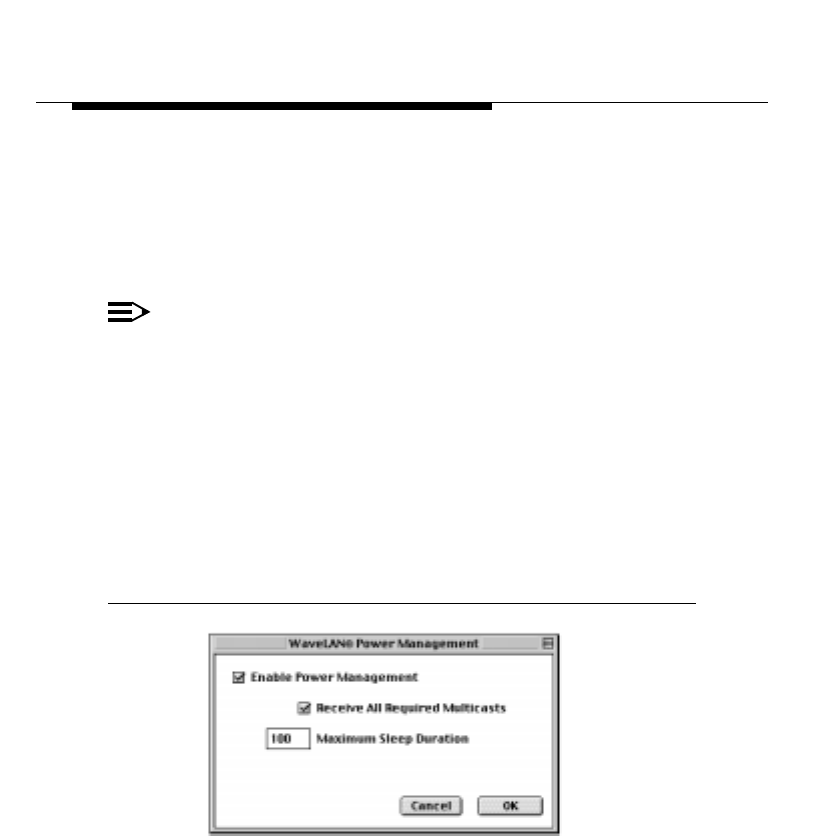
Installing in Apple Macintosh
Using WaveLAN with PowerBooks
E-8 WaveLAN IEEE 802.11 PC Card User’s Guide
A detailed description of these parameters can be found in
Chapter 4 ”Advanced WaveLAN Parameters”. Although Chapter 4
is basically oriented at Microsoft Windows operating systems, this
chapter will provide you sufficient information to learn more about
the setting fo these parameters.
NOTE:
The parameter names described in Chapter 4 are slightly
different from the names in the WaveLAN Setup window
for MAC operating systems. Please use the list below to
identify which section in Chapter 4 corresponds with the
parameter for your computer:
■Station Address - see “MAC Address” on page 4-2.
■RTS/CTS Medium Allocation - see .
■Power Management - “Power Management” on page
4-13.
Figure E-3 WaveLAN Power Managment Setup

Installing in Apple Macintosh
Using WaveLAN with PowerBooks
WaveLAN IEEE 802.11 PC Card User’s Guide E-9
Monitoring Wireless Performance E
The WaveLAN software for Apple PowerBook devices, does not
include diagnostic tools to validate the radio link quality.
However if your network also includes MS-Windows 95/98 or MS-
Windows NT v4.0 computers, you can use such stations to monitor
wireless communications between the other station and your
Apple PowerBook device.
■For Independent Network environments, you should start the
WaveMANAGER/CLIENT IEEE program on a WaveLAN
computer running either the MS-Windows 95, 98 or Windows
NT operating system.
The Link Test mode of this utility enables you to analyze the
communications quality between the “Initiator” station and your
Apple PowerBook device (identified as the “Remote Station”).
■In Infrastructure Networks, consult the LAN Administrator to
run the WaveMANAGER/AP tool.
The “Remote Link Test” of this utility enables the LAN
Administrator to analyze the communications quality between
a WavePOINT-II device (identified as the “Initiator” station) and
your Apple PowerBook (identified as the “Remote Station”).
Modifying Configuration Parameters E
To view or modify the WaveLAN parameters, open the WaveLAN
Setup window that is listed under the Apple Menu, as an item in
the Control Panels (see Figure E-2 on page E-5).
■Click the button at the top-right side of the window to confirm
changes and close the window.
■Click the button “Undo Changes” at the lower left-side of the
window to restore any modification, and cick the button at the
top-right side of the window to close the window again.

Installing in Apple Macintosh
Removing the WaveLAN Driver
E-10 WaveLAN IEEE 802.11 PC Card User’s Guide
Removing the WaveLAN Driver E
If you wish or need to remove previously installed WaveLAN
drivers, you can do so using the WaveLAN Installer program.
Removing previously drivers is mandatory if you wish to:
■Upgrade a driver
■Change the type of driver (e.g. migrate from “Apple Classic” to
Apple “Open Transport”.
To remove the drivers, proceed as follows:
1. Insert the WaveLAN diskette for the MAC operating system
into your Apple PowerBook.
2. Double-click the diskette icon on the “desktop” of your
computer, to display the contents of this WaveLAN diskette.
3. Now double-click the file called “WaveLAN Installer” to start
the installation program.
4. In the welcome window click the button “Continue” to proceed.
5. From the list of options select “Custom Remove”.
If you have any applications open during the WaveLAN
installation process, you will be prompted to close these
applications.
■Click “No” to abort the process, or
■Click “Continue” to proceed and have the MAC operating
system close all the open applications.
6. Follow the instructions as they appear on your screen and
restart your computer.

WaveLAN/IEEE Turbo 11 Mb PC Card W-1
W
Warranty Repair Card
About Warranty and Repair W
In case your IEEE 802.11 WaveLAN product is not working
properly, you are advised to consult the Troubleshooting hints,
prior to contacting WaveLAN Technical Support.
In case your IEEE 802.11 WaveLAN product is defective, return it
to your Dealer/Distributor in the original packaging.
Warranty Repairs: W
When returning a defective product for Warranty, always include
the following documents:
■The Warranty Repair card, and
■A copy of the invoice/proof of purchase
All other Repairs: W
When returning a defective product for Repair, always include the
the Warranty Repair card
You are advised to read the Information about “Limited Warranty”
as described on the following page.

Warranty Repair Card
Limited Warranty
W-2 WaveLAN/IEEE Turbo 11 Mb PC Card
Limited Warranty W
Lucent Technologies extends a limited warranty from date of
purchase of:
■Thirty-six (36) months for WaveLAN hardware products
■Twelve (12) months for WavePOINT access points
■Twelve (12) months for for the media on which the software is
furnished and the reproduction of the software on the media.
Upon proof-of-purchase Lucent Technologies shall at its option,
repair or replace the defective item at no cost to the buyer.
Defective items shall be returned to the dealer/distributor:
■Freight prepaid.
■Accompanied by a copy of proof-of-purchase.
■Accompanied by a filled out Warranty/Repair card.
This warranty is contingent upon proper use in the application for
which the products are intended and does not cover products
which have been modified without the seller’s approval or which
have been subjected to unusual physical or electrical demands or
damaged in any way.
This Warranty constitutes the sole and exclusive remedy of any
buyer or seller’s equipment and the sole and exclusive liability of
Lucent Technologies in connection with the products and is in lieu of
all other warranties, express, implied or statutory, including, but not
limited to, any implied warranty of merchantability of fitness for a
particular use and all other obligations or liabilities of Lucent
Technologies.
In no event will Lucent Technologies Inc. or any other party or
person be liable to you or anyone else for any damages, including
lost profits, lost savings or other incidental or consequential
damages, or inability to use the software provided on the software
media even if Lucent Technologies or the other party person has
been advised of the possibility of such damages.
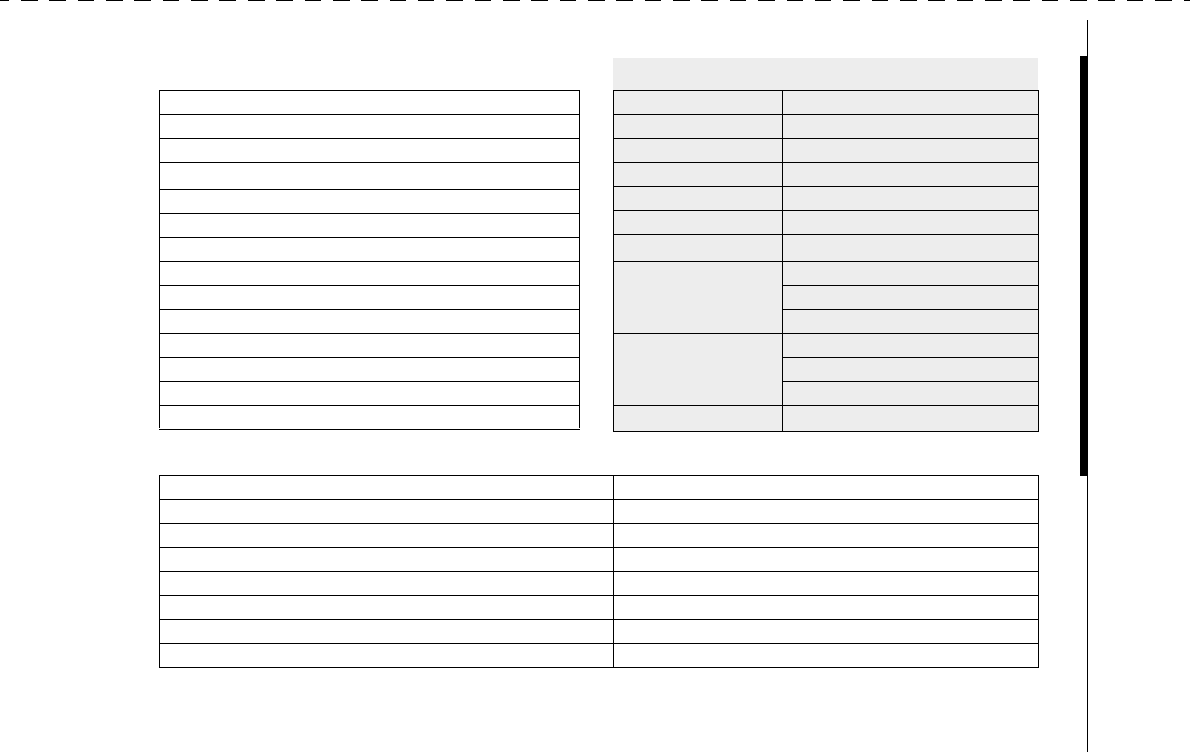
Warranty Repair Card
W-3 WaveLAN/IEEE Turbo 11 Mb PC Card
"
Reported Problem: Problem Description:
❑Out-of-Box Failure
❑Other
To be filled out by the User 0
Product Description :
COMCODE (Product ID) :
Serial Number:
Invoice Date: (dd/mm/yyyy)
Name:
Title:
Company:
Address:
City/State/Zipcode:
Country:
Telephone:
Fax:
Email:
To be filled out by the Dealer/Distributor 0
Dealer Name:
Address:
City/State/Zipcode:
Country:
Telephone:
Fax:
Warranty? Comment:
❑Yes
❑No
RMA Reference

WaveLAN/IEEE Turbo 11 Mb PC Card 1
Figure 1-1 WaveLAN IEEE 802.11 Kit Contents 1-1
Figure 1-2 Ad-hoc Wireless Workgroup 1-2
Figure 1-3 Stand Alone Wireless LAN 1-3
Figure 1-4 LAN Infrastructure 1-4
Figure 1-5 The WaveLAN/IEEE Turbo 11 Mb PC Card 1-5
Figure 1-6 Contents of the Software CD-ROM 1-11
Figure 1-7 Range Extender Antenna 1-14
Figure 1-8 Vehicle Mount Omni-Directional Antenna 1-16
Figure 2-1 Inserting the PC Card into Your Computer 2-2
Figure 3-1 Enable the PCMCIA service for Windows NT 3-7
Figure 3-2 Select WaveLAN Adapter Type 3-9
Figure 3-3 Identify the Location of Files 3-11
Figure 3-4 Windows Network Identification Properties 3-12
Figure 3-5 Setup WaveLAN Parameters 3-15
Figure 3-6 Setup WaveLAN Encryption Parameters 3-18
Figure 3-7 Finished Setting up the Hardware 3-20
Figure 4-1 Advanced WaveLAN Parameters 4-1
Figure 4-2 Access Point Density Parameter 4-3
Figure 4-3 WaveLAN Transmit Rate 4-5
Figure 4-4 The Hidden Station Problem 4-9
Figure 4-5 Medium Reservation Parameters 4-10
Figure 4-6 Medium Reservation “Request to Send” 4-10
Figure 4-7 Medium Reservation “Clear to Send” 4-11
Figure 4-8 WaveLAN Power Management Parameters 4-14
Figure 5-1 WaveMANAGER/CLIENT Status Window 5-7
Figure 5-2 WaveMANAGER Link Test 5-8
Figure 5-3 Logging Setup Dialog Box 5-17
Figure B-1 Enabling the PC Card Controller B-5
Figure B-2 Verifying IRQ Availability B-8
List of Figures

List of Figures
LOF-2 WaveLAN/IEEE Turbo 11 Mb PC Card
Figure B-3 Verifying I/O Port Availability B-10
Figure B-4 The Windows 98 Device Manager B-15
Figure B-5 Windows 98 Update Driver Window B-16
Figure B-6 Update Driver in Windows NT B-17
Figure B-7 Interface of early WaveLAN Drivers B-18
Figure B-8 Setup WaveLAN Parameters B-19
Figure C-1 Windows CE CPU Type C-2
Figure E-1 Setting the AppleTalk Parameters E-4
Figure E-2 Setup WaveLAN Parameters E-5
Figure E-3 WaveLAN Power Managment Setup E-8

WaveLAN/IEEE Turbo 11 Mb PC Card LOT-1
Table A-1 Physical Specifications A-1
Table A-2 Power Characteristics A-1
Table A-3 Networking Characteristics A-2
Table A-4 Radio Characteristics A-5
Table A-5 WaveLAN Fixed Wireless PC Card A-7
Table A-6 WaveLAN IEEE 802.11 Channels Sets A-8
Table B-1 LED Activity Table B-2
Table B-2 Default Strappings of the WaveLAN Hardware B-6
Table B-3 Default Configuration Settings B-13
Table D-1 WaveCAD Configuration Parameter Values D-7
Table D-2 WaveLAN DOS ODI Driver Parameters D-11
Table D-3 WaveLAN Packet Driver Parameter Values D-22
Table D-4 Packet Driver Specific Parameters D-24
List of Tables


WaveLAN/IEEE Turbo 11 Mb PC Card IX-1
A
Access Control 6-4, D-16, D-23
Ad-hoc workgroup
MS-DOS D-11
Advanced Parameters
Medium Reservation 4-8
Transmit Rate 4-4
AP Density
default B-13
DOS ODI Driver D-13, D-22
Miniport Driver 4-3
Apple E-1
AppleTalk E-2
B
BSS
MS-DOS D-11
C
Carrier Sense Multiple Access/
Collission Avoidance 4-8
CSMA/CA 4-8
CTS
see Medium Reservation 4-11
D
Data Encryption 6-4
Data Speed 4-4
Display Parameter Settings 3-24
Documentation Updates i
Driver_Class
Packet Driver D-24
Drivers
DOS ODI Driver D-10
Miniport Driver 3-9
Packet D-19
DSSS ii
E
Encryption 3-18
Enhance Mode
WaveMANAGER/CLIENT 5-14
Enhanced Mode
Disabling 5-15
Enabling 5-15
ESS
MS-DOS D-11
G
Gold Label Cards 1-7
H
Hot Swapping 2-2, 2-4
I
I/O Base (see I/O Port) B-6, D-7
Index

Index
IX-2 WaveLAN/IEEE Turbo 11 Mb PC Card
I/O Port
default B-6
DOS D-7
IEEE ii
Standard on Wireless LANs ii
Information
World Wide Web i
Infrastructure
MS-DOS D-11
Installation, network operating system
D-9
Interoperability ii
Interrupt Request
DOS D-7
IRQ
Display B-8
DOS D-7
ISA Card (Windows 95/98 only)
B-6
PC Card defaults B-6
verify availability B-8
L
LED
activity B-2
Logging Measurement Data
stop 5-17
M
MAC Address 6-4
default B-13
DOS ODI D-14, D-23
Miniport Driver 4-4
Macintosh E-1
Manual Logging 5-16
Measurement Data
automatic logging 5-16
logging options 5-16
Medium Reservation
default B-13
DOS ODI D-14, D-23
Miniport Driver 4-4
Memory Address
DOS D-7
Message Fragmentation
Miniport Driver 4-4
MS-DOS D-1
N
Novell Flag
Packet Driver D-24
P
Packet_Interrupt
Packet Driver D-24
PCIC
MS-DOS systems D-2
Plug & Play 2-3, 2-4, 3-5
Protocol
verify current setting 3-23
Protocols
ad-hoc workgroup 3-22
infrastructure networks 3-22
R
Radio
Safety ii

Index
WaveLAN/IEEE Turbo 11 Mb PC Card IX-3
Technology ii
RTS
see Medium Reservation 4-11
S
Security 6-3, 6-4
Access Control 6-3
Silver Label Cards 1-6
Software Updates i
SOHO 1-2
SSID
see WaveLAN Network Name
1-19, 3-14
Station Address
DOS ODI Driver D-14, D-23
Miniport Driver 4-2
Station Name 3-16
default B-13
DOS ODI Driver D-11, D-22
Miniport Driver 3-16
Packet Driver D-20
System Scale (AP Density) 4-3
T
TCP/IP
Macintosh environments E-2
Technical Support i
Transmit Rate
default B-13
DOS ODI Driver D-12, D-22
Miniport Driver 4-4
Transmit Rate Select 5-10
U
Updates i
W
WaveCAD D-1
WaveLAN Network Name 3-14
default B-13
DOS ODI Driver D-11
Miniport Driver 3-14
Packet Driver D-20, D-22
WaveLAN Parameters
Advanced 4-1
Basic 3-14
WaveMANAGER/CLIENT 5-15
Windows 95, OSR2 B-16
WVLAN42.COM D-1
WVLAN43.COM D-1





